Gettysburg Battlefield Preservation Association’s 48th Annual Civil War Show — Success!

GETTYSBURG, Penn.—
The Gettysburg Battlefield Preservation Association (GBPA), the oldest Civil War Battlefield preservation group in the nation, held its 48th Annual Gettysburg Civil War Collector’s Show over the last weekend in June. This event is the longest running show in the nation focused on original Civil War artifacts. Vendors from all over the United States, some as far away as Hawaii, filled more than 300 tables with unique relics from the War and associated reunions. One visitor travelled all the way from Costa Rica to purchase some ephemera at the show. For nearly half a century the show has served as both a repository of some of the finest relics offered and a gathering of some of the most reputable appraisers, dealers, and collectors in the field. The public was encouraged to bring items they wished to know more about, their current value, or how best to store or display their existing collections.
The show’s promoter, and Vice President of GBPA, Brendan Synnamon said, “attendance was excellent, and sales were plentiful. We were incredibly pleased
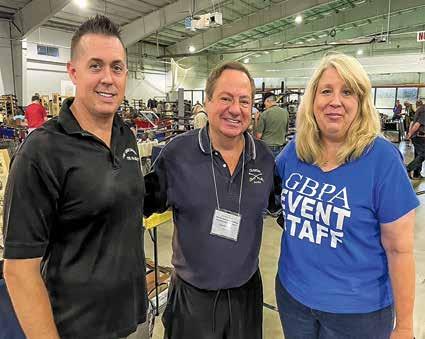
to host our friends and colleagues again, and aid in supporting a wonderful group such as the GBPA. There seemed to be some normalcy regained from the previous year,” which had been rescheduled into last fall due to the Covid-19 pandemic.
Show proceeds support the organization’s day-to-day operations and its educational programs for school groups and Boy Scouts at the Daniel Lady Farm.
While the line of eager visitors on Saturday morning stretched quite some distance, the show also sold a record number of early VIP tickets. The VIP tickets allowed holders to visit the show on Friday during the dealer’s setup time and enter an hour before general admission on Saturday and Sunday. Mr. Synnamon said “Some of the best deals are made when the vendor and buyer have time to discuss and thoroughly examine the goods without a lot of distractions.”
While the show is held on the outskirts of Gettysburg, relics from nearly every Civil War battle were present. One of the shows advertisements read: “From (A) rtillery to (Z)ouave, we have it all.” This year the show did not
disappoint, featuring multiple educational displays and exhibits in addition to the items for sale.
Mr. Charles Petrillo, a member of the GBPA and a vendor himself, was kind enough to sponsor the awards program again this year. After careful review of the displays, Mr. Petrillo announced the winners. The “People’s Choice” award went to Paul Loane for his display of Civil War sewing kits, or “Housewives” as they were known then. Gerald Roxbury received the “Judges’ Choice” award for his display of naval swords. The “Best of Show” award went to Elizabeth Topping for her display of photography related artifacts, titled “Illuminating the Darkened Chamber – Photographing the Faces of the Civil War.” Appreciation awards were given to Jeff Mattix, Jim Crane, and Debbie Sheads.
The venue had an eclectic array of items, creating an energetic atmosphere between dealers and
attendees. Many one-of-a-kind items offered for sale could be seen changing hands throughout the two days of public admittance. Uniforms, accoutrements, weapons, and images lined the show’s tables. Rare items such as Henry rifles and Lemat revolvers were available. Two flags, an original 21st Tennessee Infantry Confederate battle flag and a tattered National flag from a Pennsylvania museum, were loaned for exhibit by The Union Drummer Boy of Gettysburg. Mr. Synnamon credits the seemingly effortless flow of the show to his support staff. His father Bill, brother William, wife Jaime, and recently departed mother, Janine, worked behind-the-scenes in the year leading up to the event. Many volunteers involved with the GBPA worked the front lines to make the show a success for both vendor and visitor. Kirk Davis, President of the GBPA, commented “Even if you aren’t a collector, this is one of the best
museums you can possibly visit in Gettysburg. You have a very knowledgeable teacher behind every table and they love to pass that knowledge on to anyone who is interested.”
The 49th Annual Civil War Collector’s Show will be held June 25th and 26th, 2022. More information about this show, as well as the Historic Daniel Lady Farm and other GBPA events, can be found at www.gbpa.org. Donations may also be made to support their current projects.
Gettysburg Battlefield Preservation Association is a 501c3 nonprofit organization under the Internal Revenue Code and is registered as a charitable organization with the Pennsylvania Department of State, Bureau of Corporations and Charitable Organizations. Contributions are tax deductible.
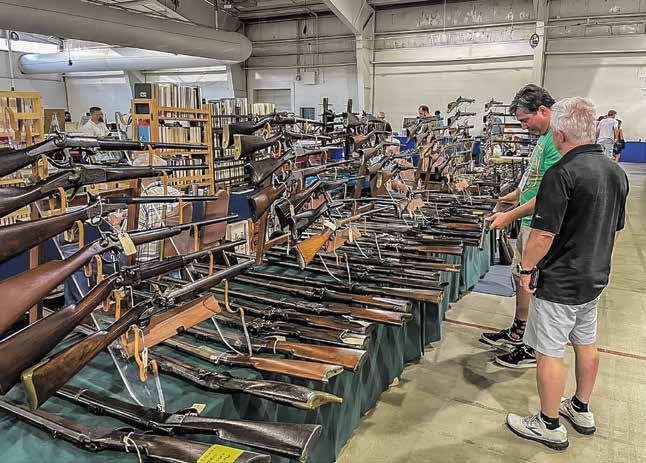
Vol. 47, No. 8 48 Pages, August 2021
12 – American Battlefield Trust 40 – Book Reviews 35 – Central Virginia Battlefield Trust 36 – Emerging Civil War 45 – Events 26 – The Graphic War 22 – Inspection, ARMS! 20 – The Source 8 – The Unfinished Fight 10 – This And That 18 – Through the Lens 29 – Trivia H Gettysburg Show . . . . . . . . . . . see page 4
$3.50 America’s Monthly Newspaper For Civil War Enthusiasts
Nick Periut and Wallace Markert browsing one dealer’s antique firearms tables.
GBPA’s Brendan Synnamon, Charles Petrillo, and Diana Forgett, some of GBPA’s staff who help make the show successful.
Civil War News
Published by Historical Publications LLC
520 Folly Road, Suite 25 PMB 379, Charleston, SC 29412 800-777-1862 • Facebook.com/CivilWarNews mail@civilwarnews.com • civilwarnews.com
Advertising: 800-777-1862 • ads@civilwarnews.com
Jack W. Melton Jr. C. Peter & Kathryn Jorgensen
Publisher Founding Publishers
Editor: Lawrence E. Babits, Ph.D.
Advertising, Marketing & Assistant Editor: Peggy Melton
Columnists: Craig Barry, Salvatore Cilella, Stephanie Hagiwara, Gould Hagler, Tim Prince, John Sexton, and Michael K. Shaffer
Editorial & Photography Staff: Greg Biggs, Michael Kent, Bob Ruegsegger, Gregory L. Wade, Joan Wenner, J.D.
Civil War News (ISSN: 1053-1181) Copyright © 2021 by Historical Publications LLC is published 12 times per year by Historical Publications LLC, 520 Folly Road, Suite 25 PMB 379, Charleston, SC 29412. Monthly. Business and Editorial Offices: 520 Folly Road, Suite 25 PMB 379, Charleston, SC 29412, Accounting and Circulation
Offices: Historical Publications LLC, 520 Folly Road, Suite 25 PMB 379, Charleston, SC 29412. Call 800-777-1862 to subscribe.
Periodicals postage paid at U.S.P.S. 131 W. High St., Jefferson City, MO 65101.
POSTMASTER: Send address changes to: Historical Publications LLC 520 Folly Road Suite 25 PMB 379 Charleston, SC 29412

Display advertising rates and media kit on request. The Civil War News is for your reading enjoyment. The views and opinions expressed herein are those of its authors, readers and advertisers and they do not necessarily reflect the official policy or position of Historical Publications, LLC, its owners and/or employees.
P UBLISHERS :
Please send your book(s) for review to: Civil War News
520 Folly Road, Suite 25 PMB 379 Charleston, SC 29412
Email cover image to bookreviews@civilwarnews.com. Civil War News cannot assure that unsolicited books will be assigned for review. Email bookreviews@civilwarnews.com for eligibility before mailing.
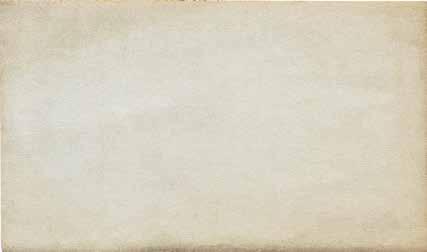
ADVERTISING INFO:
Email us at ads@civilwarnews.com Call 800-777-1862
MOVING?
Contact us to change your address so you don’t miss a single issue. mail@civilwarnews.com • 800-777-1862
SUBSCRIPTION RATES
U.S. Subscription rates are $41/year, $71/2 years, digital only $29.95/year, add digital to paper subscription for only $10/year more. Subscribe securely at CivilWarNews.com
A Volume number mistake was made with 2021 Civil War News. Volumes 41, No’s 1-6 are actually Vol. 47. No’s 1-6. NOTE: New policy for event listings.
By Jack Melton
After over thirty years of contributing to the Civil War News with his much-loved column, “Black Powder White Smoke,” our dear friend, Joe Bilby, has decided that it is time to retire.

Joe received his Bachelor’s and Master’s degrees in history at Seton Hall University and served as lieutenant in the 1st Infantry
Online DIGITAL Subscriptions for Civil War News and The Artilleryman Magazine
Digital subscriptions for back issues of Civil War News (Archive 2012 to the current issue are available) and The Artilleryman magazine from Vol. 1, No. 1 to the current issue, is now available. From the very first issue to the current publication are now available as an online, as a yearly digital subscription. Over 6,500 pages of artillery information available on your phone, tablet, or computer. This project is entirely up to date, with over 170 issues.
If you are a student of the Civil War, artillery, a historian, researcher, author, or just interested in the hobby, you’ll find plenty of information within this massive archive.
To Subscribe Visit: CivilWarNews.com or ArtillerymanMagazine.com
Deadlines for Advertising,
Editorial or Events Submissions is the 20th of each month. We strive to add all events submitted to us but do not guarantee that your event will be published.
Division in 1966–1967. He is Assistant Curator of the New Jersey National Guard and Militia Museum, a freelance writer and historical consultant, author or editor of 21 books, and over 400 articles on N.J. and military history and firearms. We have enjoyed working with him and are very grateful for all he has done to help make Civil War News a successful publication.
He was also publications editor for the N.J. Civil War 150 Committee and edited the award-winning New Jersey Goes to War. His latest book, New Jersey: A Military History, was published by Westholme Publishing in 2017. He has received an award for contributions to Monmouth County (N.J.)


Back Issues:
To purchase back issues of The Artilleryman magazine please visit our website at www.historicalpubs.com.
There is a 100 word maximum for each event and a $50 insertion fee. Run an ad and get the event listed for free.

Email events to: ads@civilwarnews.com
history and an Award of Merit from N.J. Historical Commission for contributions to the state’s military history.
In his retirement, he will be greatly missed not only by our readers who followed his column monthly but also by Peggy and myself! We have enjoyed working with him and are very grateful for all he has done to help make Civil War News a successful publication.
We wish him the best of health, happiness, and success on his new journey in life. You can send Joe congratulations at jgbilby44@ aol.com.
REINFORCEMENTS
MAKE ALL THE DIFFERENCE!!!
Nobody even comes close to building a Civil War tent with as much attention to reinforcing the stress areas as Panther. Our extra heavy duty reinforcing is just one of the added features that makes Panther tentage the best you can buy!
PANTHER Catalog - $2 Web: www.pantherprimitives.com 160 pages of the best selection of historical reenactment items from Medieval era to Civil War era. Includes over 60 pages on our famous tents and a 4-color section.
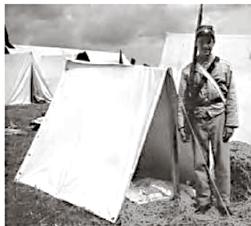
Your $2 cost is refundable with your first order. SEND for copy TODAY
The Best Tents in History P.O. Box 32N Normantown WV 25267 (304) 462-7718
2 Civil War News August 2021 2 Civil War News August 2021
CIVIL WAR AUTOGRAPHS LETTERS • DIARIES • STAMPS • CURRENCY Price List Online • Top Price Paid for Quality Material B. M. GREEN P.O. Box 1816N Kernersville, NC 27285-1816 (336)993-5100 • (336)993-1801 www.shop.bmgcivilwar.net bmgcivilwar@triad.rr.com
to the Editor: Please email: mail@civilwarnews.com Civil War News 520 Folly Road, Suite 25 PMB 379 Charleston, SC 29412
Letters
Joe Bilby
Charleston Gun & Knife Show
Exchange Park Fairgrounds 9850 Highway 78 Ladson, SC 29456
Sept. 11 & 12, 2021
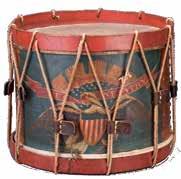

Asheville Gun & Knife Show
WNC Ag Center 1301 Fanning Bridge Road Fletcher, NC
Oct. 2 & 3, 2021
Myrtle Beach Gun & Knife Show
Myrtle Beach Convention Center 2101 North Oak Street Myrtle Beach, SC 29579

Oct. 30 & 31, 2021
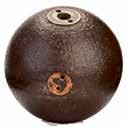
Charleston Gun & Knife Show


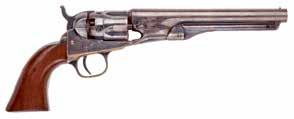
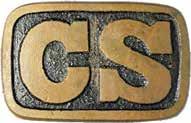

Exchange Park Fairgrounds 9850 Highway 78 Ladson, SC 29456
Nov. 27 & 28, 2021

Mike Kent & Associates, LLC • PO Box 685 • Monroe, GA 30655 770-630-7296 • Mike@MKShows.com • www.MKShows.com Military Collectible & Gun & Knife Shows Presents The Finest
County Ag Expo Park
Lane
Dec. 4
5, 2021 Middle TN (Franklin) Civil War Show Promoters of Quality Shows for Shooters, Collectors, Civil War and Militaria Enthusiasts
Fairgrounds
29202
Williamson
4215 Long
Franklin, TN 37064
&
South Carolina State
1200 Rosewood Drive Columbia, SC
Dec. 11 & 12, 2021
Columbia Gun & Knife Show
Scan for all events

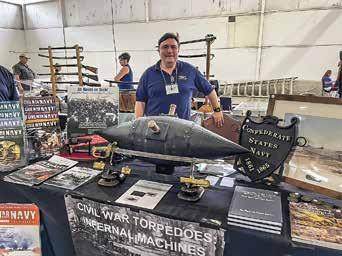
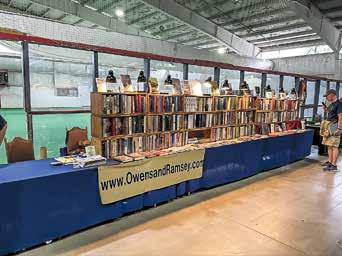
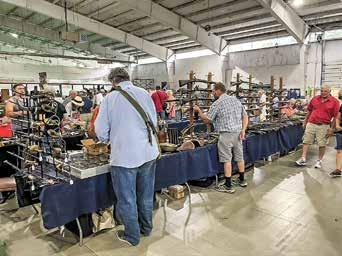
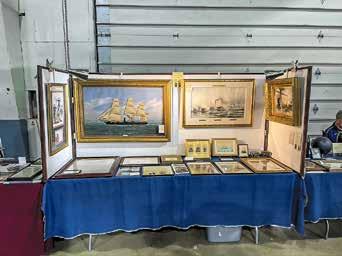




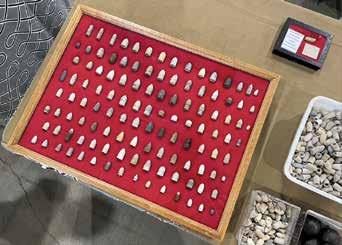


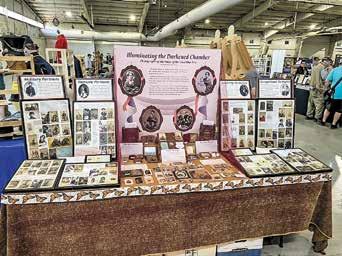


4 Civil War News August 2021 4 Civil War News August 2021 H Gettysburg Show . . . . . . . . . . from page 1
the Gettysburg show
Photo highlights from
Deadlines for Advertising
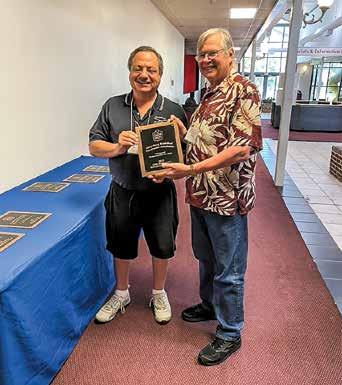





is the 20th of each month.

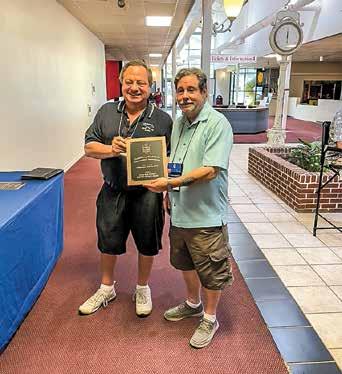


Email: ads@civilwarnews.com

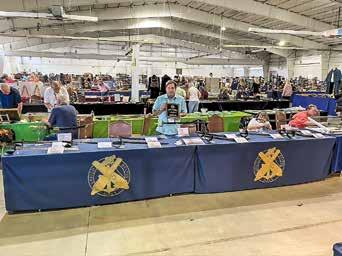
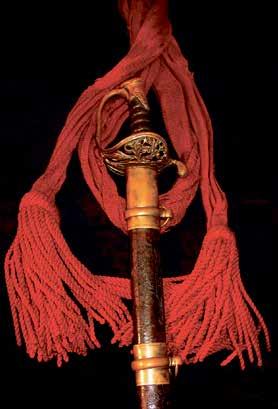



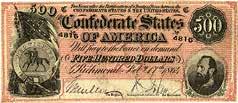






5 August 2021 Civil War News 5 August 2021 Civil War News Greg Ton • P.O. Box 9 • Franklin, TN 37065 901-487-5944 • GTon1@aol.com Greg Ton Buying and Selling the Finest Confederate, Obsolete and Southern States Currency Since 1978 GregTonCurrency.com THE FINEST HISTORICAL ANTIQUE MILITARIA Wallace Markert info@csacquisitions.com 16905 Nash Road • Dewitt, Virginia 23840 804-536-6413 • 804-469-7362 www.csacquisitions.com
Charles Petrillo hands Paul Loane the “Peoples Choice Award” for “Hurray for the Housewives.”
Gerald Roxbury received the “Judges’ Choice” award for his display of “Swords and Cutlasses in the Age of the Fighting Sail.”
The “Best of Show” award went to Elizabeth Topping for her display of photography related artifacts, titled “Illuminating the Darkened Chamber – Photographing the Faces of the Civil War.
Jeff Mattix received an Appreciation award for “Through the Valley of Death.”
Editorial
or
Submissions
The 2021 Gettysburg Civil War Show: Collecting and Displaying the 15th New York Cavalry Regiment

 by James Crane III
by James Crane III
The 15th New York Volunteer Cavalry Regiment was a late addition to the Civil War, but nonetheless experienced an intense sixteen months of service.
Beginning in northern Virginia with the 1864 Shenandoah Valley campaigns, followed by assignment to Major General George Custer’s 3rd Cavalry Division, the regiment had a distinguished record, and ultimately served in the forefront of the Union Army from Five Forks to Appomattox. With a majority of its officer corps consisting of veterans, and veteran noncommissioned officers and junior enlisted troopers in the ranks, the men of the 15th NY Cavalry were aware of the risks of their military service. Whether from first hand combat experience, recollections of family members, tent mates and superiors, their knowledge of the likelihood of death or grievous wounds was sobering. Additionally, newspapers reported battle casualties and burials of the dead, to include the legions of “Unknown” burials. As the November 20th, 1863, Philadelphia Inquirer reported regarding the dedication of the National Cemetery at Gettysburg, “… the number of [dead] whom no clue could be obtained as to name, regiment, etc., being greater than any State, two lots have appropriated to their reception, and classed as ‘Unknown.’”
A Christian burial and a properly marked grave were of high importance to the troops. Dying for one’s country, only to be buried in a mass grave, was repugnant. To provide some degree of insurance that their graves would be properly marked, troopers understood that there must be a means of identifying their bodies. While service members in World War I and afterward received a government issued identification
tags, Civil War era identification devices were privately purchased items. Supplying a measure of assurance to allay the concerns of the troopers, sutlers and jewelers were prepared to capitalize on the demand, offering a variety of identification badges and disks.
The book Identification Disks of Union Soldiers in the Civil War by Larry Maier and Joseph Stahl is a superb reference on the subject. A pre-manufactured brass disk was stamped on request with the trooper’s choice of inscription. Its cost, based on research by Maier and Stahl, was around $2. This service could be performed in austere conditions with minimal skill by a sutler, compared to the more expensive engraving performed by a professional jeweler in his shop. The information typically included on the disk included the trooper’s name, company, regiment, and hometown. Disks had holes punched through them, and could be worn on a chain around the neck, with a suspension pin on the uniform, or sent home as a gift.
Ten identification devices of 15th NY troopers were on display at the June Gettysburg Civil War Show. One was a jeweler-engraved silver shield style badge. One was a pair of silver cufflinks fashioned from U.S. silver dimes. Eight were disks, two plain silver, the other six were Major General George McClellan

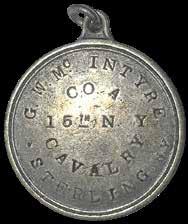
“War of 1861” pre-manufactured brass. Of the six McClellan disks, all were stamped with presentation inscriptions such as “To My Mother,” or “To My Wife.” Perhaps they were intended to be offered as gifts, or given to the recipient posthumously. Apparently, McClellan remained a popular figure in the regiment as he campaigned for the 1864 presidential election.
The excavated items each have interesting stories. Famed relic hunter Wendall Lang recovered
the silver ID shield of Sergeant Henry C. Lewis of Company C, 15th NY Cavalry at Hanover Court House, Va. It is likely that Lewis lost his badge when the pinback broke. This was a rather common occurrence, as a trooper’s brush with vegetation, swinging a sabre, or adjusting accoutrements could easily result in breaking the pin. Based on the regimental history “Red Neck Ties” by Chauncey Norton, Sergeant Lewis almost certainly lost it sometime between March 15 and 25, 1865, as the regiment participated in skirmishes near Ashland and Cold Harbor, Va.
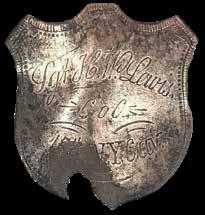
Lynn Routzahn, another accomplished relic hunter, found the silver ID badge of Private Robert M. Sexton, Company B, in Halltown, W.Va. Serving honorably with the regiment throughout its term of service, Private Sexton was briefly captured by Confederates on March 16, 1865, at Hanover Court House and paroled on March 26. Ironically, this is the same battlefield where Sergeant Lewis lost his silver ID shield. Private Sexton was a late war casualty and died at the military hospital in Grafton, W.Va., in August 1865. Halltown, three miles west of Harper’s Ferry, was in the area of the regiment’s mounted patrols during its bivouacs in Sandy Hook, Md., and Harper’s Ferry; he likely lost it in camp or on picket duty. Private George McIntyre of Company A carried a silver disk that is identical in style to Private Sexton’s. Private McIntyre previously served in the 24th NY Infantry Regiment and his battle honors are stamped on the disk:
“2nd Bull Run, So. Mountain, Antietam, Fredericksburg, Chancellorsville.”
Two other interesting identification devices are the brass McClellan disk of Corporal
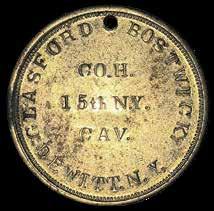
Glassford Bostwick and the silver cufflinks of Private Dewitt C. Tarkett. Corporal Bostwick, Company H, was tall for a cavalryman, standing at six feet, and hailed from Syracuse. He died
of a gunshot wound to the bowels received in the April 1, 1865, battle of Five Forks. He was one of the regiment’s 27 casualties in the engagement known as the “Waterloo of the Confederacy.” Dewitt Tarkett’s cufflinks, professionally engraved with his initials “DCT,” are made from U.S. silver dimes, one dated 1854 and the other 1857. Tarkett was a tentmate of the author’s great great grandfather, who also served in Company K.
James Crane III is a collector and historian of the 15th NY Volunteer Cavalry. He is a retired Army officer and currently a law student at Fordham University in New York City. He can be contacted at 15thnycavalry@gmail.com.
6 Civil War News August 2021 6 Civil War News August 2021
Author and collection James Crane III, poses with his Identification Badges display at the 48th annual Gettysburg Civil War Show. He was awarded an Appreciation award for his display.
Enlargements of each badge with descriptions accompanied the display for better viewing.
McClellan ID disk of Corporal Glassford Bostwick, mortally wounded at the battle of Five Forks, Va.
ID shield of Sergeant Henry W. Lewis, excavated at Hanover Court House, Va.
ID disk of Private George McIntyre, with battle honors from his prior service with the 24th NY Infantry.
100 Significant Civil War Photographs: Atlanta Campaign collection of George Barnard’s camera work. Most of the photographs are from Barnard’s time in Atlanta, mid-September to mid-November 1864, during the Federal occupation of the city. With this volume, Stephen Davis advances the scholarly literature of Barnardiana.

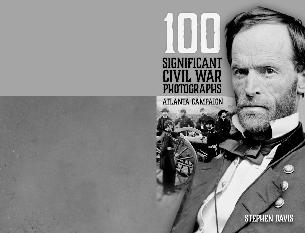
Middle TN (Franklin) Civil War Show
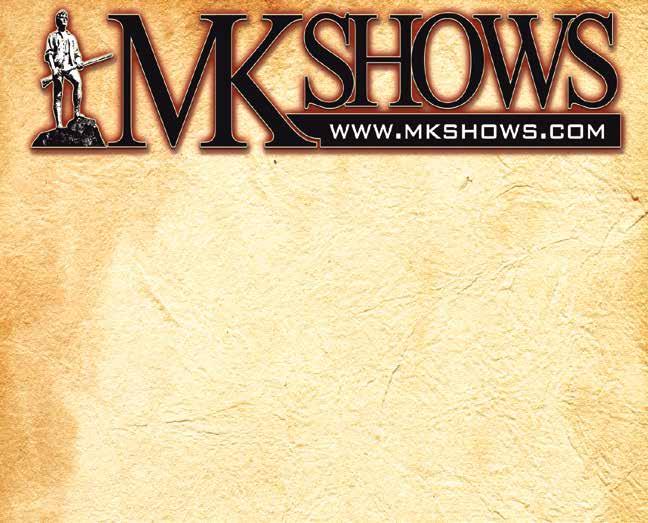
$19.95 + $3.50 shipping 128 pages, photographs, maps, bibliography. $19.95 + $3.50 shipping. Softbound. ISBN: 978-1-61850-151-6. www.HistoricalPubs.com.
Order online at www.HistoricalPubs.com or call 800-777-1862


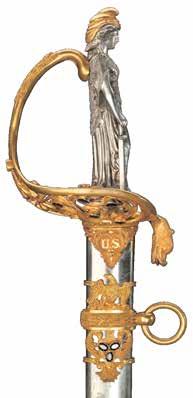

MK Shows presents the 34th Annual Middle Tennessee Civil War Show and Sale at the Williamson County Ag Expo Park, 4215 Long Lane in Franklin. The nation’s largest Civil War show, featuring 800 tables of antique weapons, artifacts and memorabilia from top dealers and collectors around the country and encompassing all eras of military history from the Revolutionary War through World War II.
Appraisers are always on hand to help you identify and value your military collectibles at no cost. Hours are 9-5 on Sat., 9-3 on Sun., parking is free and admission is only $10/adults and children under 12 are free. This will be a sold out show so make your table reservations early.

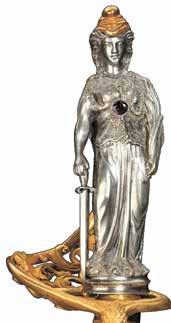
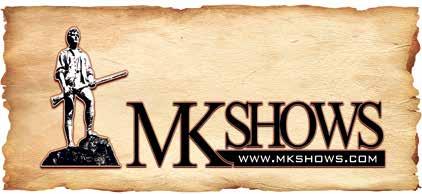
7 August 2021 Civil War News 7 August 2021 Civil War News Mike@MKShows.com • www.MKShows.com Admission Coupon To Any MKShows Event $1 Off 770-630-7296 Publishers: Send your book(s) for review to: Civil War News 520 Folly Road, Suite 25 PMB 379 Charleston, SC 29412 bookreviews@civilwarnews.com Deadlines for Advertising or Editorial Submissions is the 20th of each month. Mike Kent and Associates, LLC • PO Box 685 • Monroe, GA 30655 (770) 630-7296 • Mike@MKShows.com • www.MKShows.com
Buying and Selling The Finest in Americana 11311 S. Indian River Dr. • Fort Pierce, Florida 34982 770-329-4985 • gwjuno@aol.com George Weller Juno
The American Civil War was the first war in which both sides widely used entrenchments, repeating rifles, ironclad warships, and telegraphed communications. It was also the first American War to be extensively photographed. Mathew Brady, Alexander Gardner and Timothy O’Sullivan are famous for having made iconic photographs in the Civil War’s eastern theater. George N. Barnard deserves to be ranked in this top tier for his photographic A civilian photographer hired by Gen. William T. Sherman’s chief engineer to take pictures of fortifications around Atlanta, Barnard took several hundred of them in and around the city in the fall of 1864. His most famous is the site of Union Maj. Gen. James B. McPherson’s death in the battle of Atlanta, July 22, 1864. Thus far, no comprehensive, definitive listing has been made of the photographer’s work. The Library of Congress has 130 images; the U. S. Military Academy at West Point, New York, has at least 98 photographs, donated by Captain Poe’s widow. Other repositories, such as the Gilder Lehrman Institute of American History in New York City, have smaller collections. For this book we have chosen a hundred images we deem “significant,” though other students may wonder at some of our selections. We hope that this work will stimulate further interest in Barnardiana, and that other scholarly volumes are yet to come. The Atlanta Campaign STEPHEN DAVIS 100 SIGNIFICANT CIVIL WAR PHOTOGRAPHS ATLANTA CAMPAIGN
19th Century Spectacles
The question comes up from time to time about 19th century eyeglasses and how commonly they may have been worn by Civil War-era soldiers. The first point to consider is whether the individual was near-sighted, had difficulty seeing at a distance, or far-sighted, had difficulty reading. The most common way of correcting vision problems was by using mounted lenses. In modern times mounted lenses are called eye-glasses, but in 19th century America they were referred to as “spectacles.” During the mid-19th century, the term “eye-glasses” referred to corrective lenses that did not have side pieces and were held on the face by clamping to the top of the nose, and called pince nez.
Among far-sighted civilians of a certain age, reading glasses with wire frames and a half-moon lens were not uncommon and
their cost was quite reasonable. Among the mostly young men in the rank and file, spectacles were not common and the need to correct for far-sightedness with reading glasses would have been practically unknown among younger men. Would a young man, either near-sighted or far-sighted enough to require corrective lens, be exempt from military service depending on the extent of his condition? By way of answering that question, one Northern newspaper noted “near-sighted men instead of finding themselves exempt will observe that they are transferred to the Invalid Corps. Henceforth spectacles and eyeglasses will not be so popular.”
It is worth noting that while most men did not wear them, those who did require spectacles to correct their vision purchased the item on their own. Spectacles were not an item of military issue; later in the Civil War the
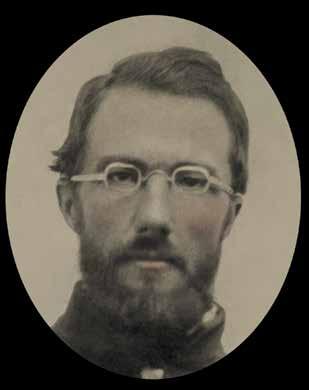
Sanitary Commission made note of distributing a few pairs. What sort of spectacles were commonly available during the time period? According to Alan McBrayer and Thomas Valenza in their monograph History on Your Face (2012), the frames and lens were usually hand-made in the mid-19th century. The most common method of selecting spectacles was to try various pairs until a pair was found that seemed to offer the greatest vision improvement. In cities with a population large enough to support an optician, spectacles could be custom made and fitted for a particular customer.
The parts of spectacles consisted of the lenses, called “optics” or “eyes.” The “eye wire” surrounded the optics; the “bridge” rested on the nose. The “jints” attached the “temples,” or sidearms, to the side of the head.
Former editor Nicky Hughes wrote an article for The Watchdog (Autumn 1995) called A Closer Look. He noted of mid-19th century lens that oval lens were “regularly popular” from the Colonial period through the beginning of the twentieth century. Other popular optic shapes were rectangular, the half-moon reading type, and long octagonal varieties. The main types of spectacle bridges were the arch, crank, x-type, and scroll. The temple pieces did not curve around the ears until the 1880s and were not in common use until the 1890s. Instead, they were straight or featured either round or tear drop shaped open rings or flat solid tips called “beavertails.” The optics or lenses were generally small by modern standards with typical dimensions being “somewhat over an inch wide.” Frames were brass, silver or other metals and the styles “did not seem to vary by the gender of the wearer.”
While not uncommon in photographs of civilians, images showing Civil War soldiers wearing spectacles are very scarce. We do know many pairs of spectacles from the Civil War-era survive today and relics are sometimes dug at known Civil War campsites. Hughes notes some explanations for this including that
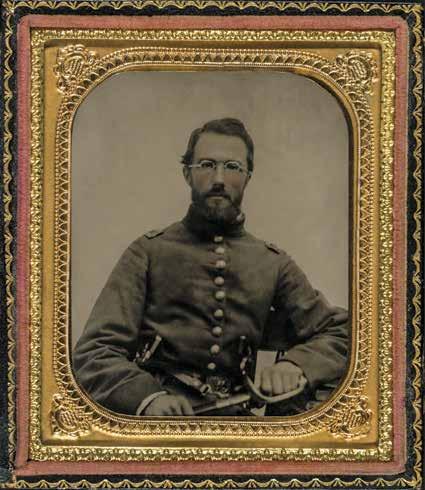
some officers may have been hostile to their use among the rank and file. It may also be possible that a degree of self-conscious vanity played a role in the lack of eyewear in period photographs of soldiers. It may have been considered a sign of weakness or a lack of virility.
There is anecdotal evidence of one New York soldier who was disparagingly called “Four Eyes” and the writer also noted that the man could not see a barn door at ten feet without them. There is also an account of a Confederate soldier who wrote in a letter home dated July 22, 1861, that while fighting at First Manassas he was injured above the forehead while reloading “…and drew off my spectacles and cast them aside.”

This much can be said with certainty, while there are a few period accounts of men wearing spectacles in the ranks, we lack much
photographic evidence of their use among Civil War soldiers.
Craig L. Barry was born in Charlottesville, Va. He holds his BA and Masters degrees from the University of North Carolina (Charlotte). Craig served The Watchdog Civil War Quarterly as Associate Editor and Editor from 2003–2017. The Watchdog published books and columns on 19th-century material and donated all funds from publications to battlefield preservation. He is the author of several books including The Civil War Musket: A Handbook for Historical Accuracy (2006, 2011), The Unfinished Fight: Essays on Confederate Material Culture Vol. I and II (2012, 2013). He has also published four books in the Suppliers to the Confederacy series on English Arms & Accoutrements, Quartermaster stores and other European imports.

8 Civil War News August 2021 8 Civil War News August 2021
Rare image of soldier in spectacles. Liljenquist Family Collection of Civil War Photographs. Library of Congress.
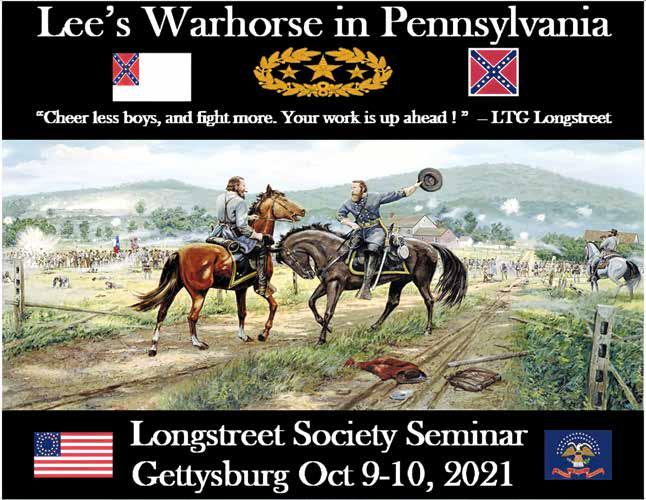
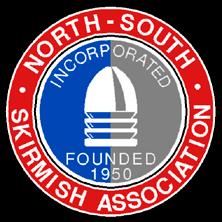
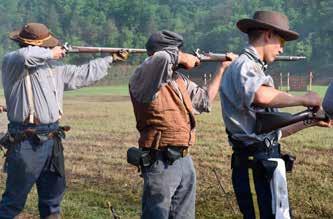
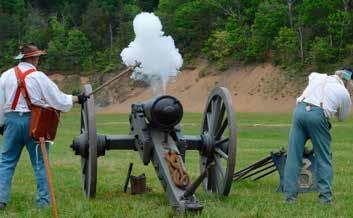


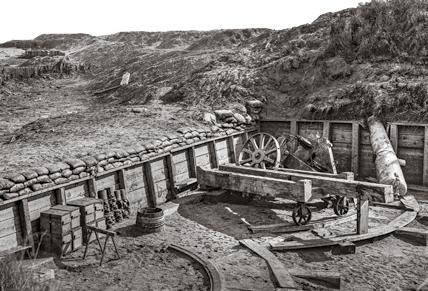


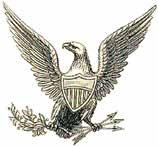
9 August 2021 Civil War News 9 August 2021 Civil War News Deadlines for Advertising or Editorial Submissions is the 20th of each month. Email to: ads@civilwarnews.com The N-SSA is America’s oldest and largest Civil War shooting sports organization. Competitors shoot original or approved reproduction muskets, carbines and revolvers at breakable targets in a timed match. Some units even compete with cannons and mortars. Each team represents a specific Civil War regiment or unit and wears the uniform they wore over 150 years ago. Dedicated to preserving our history, period firearms competition and the camaraderie of team sports with friends and family, the N-SSA may be just right for you. For more information visit us online at www.n-ssa.org. Contact Mike at: 910-617-0333 • mike@admci.com Fort Fisher Items Wanted! Provenance a Must! Fort Fisher Loyal Legion of the Confederacy CSA National Defense Medals & other banned internet items Civil War Recreations WWW.CWMEDALS.COM cwmedals@yahoo.com 1 Smithbridge Rd., Unit 61, Chester Heights, PA 19017 Publishers: Send your book(s) for review to: Civil War News 520 Folly Road, Suite 25 PMB 379 Charleston, SC 29412 19th CENTURY LIVING HISTORY! James Country MERCANTILE 111 N. Main Liberty, MO 64068 816-781-9473 • FAX 816-781-1470 www.jamescountry.com Ladies – Gentlemen Civilian – Military • Books • Buttons • Fabrics • Music • Patterns • Weapons Mens, Ladies and Children’s • Civilian Clothing • Military Clothing • Military Accessories • Accoutrements Everything needed by the Living Historian! Our Clothing is 100% American Made! The home of HOMESPUN PATTERNS©
An Interesting Blend of Fact and Fiction
This month’s column will continue to examine the accounts of women who, in various ways, served, or claimed to serve, the Confederacy and Union during the Civil War. Most examples covered in June and July were one-day stories, told and then forgotten. This month we will look at three of the better-known women who served (claimed to have served); women who achieved some lasting fame and today remain on the margins of history.
We begin with the story of Antonia J. Ford, a young Virginia woman who served the Confederacy as a spy, and was commissioned as an honorary lieutenant and aide-de-camp by Gen. Jeb Stuart in 1861 after she provided intelligence to the Southern forces before the Battle of Manassas.

On April 2, 1863, Atlanta’s Southern Confederacy, relaying information taken from a Baltimore paper, reported on Ford’s activities in the previous month. She was “the principal spy and guide for Capt. Mosby in his recent raid on Fairfax Court House, and aided in the arrest of Gen. Slaughter (sic, the general’s
name was Stoughton), Wyndham and others.” Mosby got away with this embarrassed general, two lower ranking officers, 30 enlisted men, and 58 horses. Ford herself was less fortunate. “She was arrested and brought to the Old Capitol Prison, on Sunday last, with $1,000 Confederate money on her person.”
What makes this story interesting, however, is not the spy angle, but the love angle. The officer who arrested Ford was Major Joseph Willard, a Washingtonian previously acquainted with Ford and her family, and who managed the Old Capitol Prison. While Antonia was Joseph’s prisoner, her jailer became her sweetheart.
The smitten major, 18 years older than Antonia and married, worked to win her release. She was freed in a prisoner exchange but remained under suspicion. Re-arrested and given an ultimatum, take a loyalty oath or remain in prison; Ford relented and swore fealty to the hated Union.
The power of love proved unconquerable. The Montague officer divorced himself from his wife and from the United States Army. The Capulet daughter risked alienating her secessionist family. They married, had three children, and lived in Washington until Antonia died in 1871, her
GEORGIA’S CONFEDERATE MONUMENTS
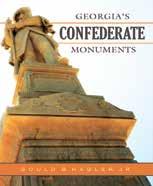
In Honor of a Fallen Nation
Gould B. Hagler, Jr.

This unique work contains a complete photographic record of Georgia’s memorials to the Confederacy, a full transcription of the words engraved upon them, and carefully-researched information about the monuments and the organizations which built them. These works of art and their eloquent inscriptions express a nation’s profound grief, praise the soldiers’ bravery and patriotism, and pay homage to the cause for which they fought.
www.mupress.org
866-895-1472 toll-free
by Federal troops; and her commission, issued by Gen. James Garfield, granting her the “rank and title of Major,” after which she was forever known as Miss Major Pauline Cushman.
or, in at least one case, when she merely passed through town. She died in 1893.
life shortened by the effects of her harsh imprisonment.
We now move to the Federal side and consider the history of Miss Major Pauline Cushman. I won’t attempt to separate fact from fiction and will just relate what was reported about this actress-turned-spy.
Harriet Wood was born in New Orleans in 1833. At a young age she embarked on an acting career under the name Pauline Cushman. She was on stage in Cleveland when the War began, and two years later was performing in Louisville. She was asked by some paroled Confederate officers to ad lib a pro-Confederate toast from the stage. She consulted with the Federal provost marshal and together they concocted a scheme.
“Here’s to Jeff Davis and the Southern Confederacy!” she cried out, “mortifying all loyal persons present and highly delighting their ‘secesh’ neighbors.” She was immediately dismissed for her supposed secesh proclivities. With her pro-South bona fides documented, she embarked on her career as a Union spy. That is the version reported in the Valley Spirit of Chambersburg.
The Detroit Tribune reported that her friendship with the paroled officers and other factors aroused suspicion and led to her arrest. In that version she “indignantly denied” she was a rebel and proved her loyalty by agreeing to enter the U.S. secret service.
If we stick with the Tribune’s account, we learn that Cushman “visited the Rebel lines time after time, and was thoroughly acquainted with all the country and roads in Tennessee, Northern Georgia, Alabama, and Mississippi, in which sections she rendered our armies invaluable service.” Newspapers contain various accounts of our heroine’s derring-do, of her capture, escape, and recapture; her encounters with John Hunt Morgan, Braxton Bragg, and Nathan Bedford Forrest; her trial and death sentence; her liberation
My favorite part of the story is her bold demand of Abraham Lincoln, as reported in the September 1864 Nashville Dispatch. Miss Major Cushman was not one to be put off by officious underlings. When the army denied her claim for five months back pay, she called upon the president himself and pressed her case. Soon after the interview the Paymaster General received a note signed “A. Lincoln,” directing him to pay the lady.
Cushman capitalized on her fame. From 1864 onward she toured the country, appearing on stage in cities large and small, telling of her adventures to paying audiences. Appearances became less frequent as time passed, but news items can be found as late as 1873 announcing her lectures on her wartime exploits. In later years her wartime celebrity earned her occasional mention in the press. It was newsworthy when she “cowhided a young man in San Francisco” who spoke of her in a disrespectful tone; when she opened a hotel in Arizona;
Our last subject this month will be the woman who perhaps is the most famous female to wear the blue or the gray. Let’s take a look at the accounts of this lady’s adventures found in wartime and postwar newspapers, then consider her autobiography, and finally see what a prominent Civil War historian had to say in a recent book about the lady and her claims.
First, what shall I call her? She used ten or so names over the years, and the count easily doubles if we include variations that appeared in print. Her real name is uncertain and she never used it anyway, so I will call her Loreta Velazquez, the name appearing on the cover of her autobiography. Loreta first appeared on the scene in 1861 in Lynchburg. According to the September 26 Lynchburg Republican, she was dressed in Confederate military garb, presented a “gay and dashing appearance,” and attracted much attention as she paraded about. The true sex of this suspicious character was discovered when she was arrested. Loreta called herself Lt. Harry T. Buford. She was sent to Richmond.
10 Civil War News August 2021 10 Civil War News August 2021
Miss Major Pauline Cushman.
Two days later the same paper reported that “Buford” had turned up again. She had returned to Lynchburg, but was preceded by a telegram from Gen. John Winder ordering her re-arrest. She claimed that while in Richmond she had met with the Secretary of War, not once but twice, the first time disguised as Buford and the second in female dress, calling herself Martha Keith. She declared that Secretary Benjamin, thinking that he had met with two individuals, had issued two passes to travel to Memphis, one to the male lieutenant and one to Mrs. Keith. The editor was “inclined to the opinion that there is something suspicious about her movements.” Indeed. And one must also be inclined to the opinion that either (1) she was lying about the passes or (2) the Confederate Secretary of War was extremely easy to fool.

The Richmond Examiner reported on Loreta’s third appearance as Lieutenant Buford in July 1863. Loreta, now identified as Mrs. S.T. Williams, had continued to dress as a Confederate officer and “it was this that got her into trouble with the Richmond authorities.” Under suspicion as a spy, Loreta was kept briefly in Castle Thunder then released. The paper reported on her parentage, her family’s wealth, and her work to aid the Confederacy. In addition to ministering to the wounded, she was “known to lend a helping hand with the musket at several battles in which she participated.” Well, she was not exactly

known to do these things. It was known only that she said she did them. There is a difference.
Loreta was again in the news a few months later, passing through Richmond and stopping to visit the Examiner. She had a new husband and a backlog of adventurous tales to share with the world. Since our last encounter with her, she had joined Bragg’s army in Chattanooga; served on Gen. A.P. Stewart’s staff; was employed by the secret service; helped catch spies; and did various other “very daring things.” Again, so she said.
This is all the wartime news about the famous Lt. Harry T. Buford, but the novel story spread far beyond Richmond and Lynchburg. Papers throughout the Confederacy and the North ran the item, as did papers as far away as Britain and Australia.
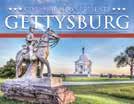
Loreta reappeared soon after the war, with an expanded resume of her tireless work on behalf of the Confederacy. April 1866 newspaper reports summarized her service. In 1861 she had recruited and equipped at her own expense a company of cavalry. By war’s end she had struggled for Southern independence in various ways not only in the Confederacy but also in the North, in Canada, and in Europe.
Some dared to question the veracity of her exploits. Loreta responded by publishing notices that persons who persisted in spreading these slanders “will do so at their personal peril.” As she warned off these skeptics, she toured the South “collecting
Antonia Ford Willard.
subscriptions for three forthcoming works which she is preparing,” one of which was to be entitled “Buford’s Poems.”
The poems were never published. In 1876, however, a work appeared entitled The Woman in Battle. This fantastical account of her wartime and postwar life expands on the adventures described in the various newspaper accounts. She fought and she spied. She went everywhere, traveling in high circles and winning the confidence of Confederate leaders who employed her many talents. While in female attire she was irresistible to men. While in disguise as Buford she won the hearts of women everywhere. She fought, she spied, and she loved, ultimately marrying a Confederate officer who fought side-by-side with Buford and fell in love with Loreta, not knowing until she revealed that the comrade-in-arms and the refined lady were the same person.
“Pure fiction,” in the words of Gen. Jubal Early. How anyone who read it could think otherwise is a mystery.
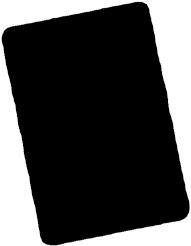
In 2016 William C. Davis’s Inventing Loreta Velasquez was published. Davis’s work revealed the facts about this “Confederate soldier impersonator, media
celebrity and con artist.” The reader learns a great deal about the person behind the façade. To me, the truth is more interesting than the fiction. I won’t attempt to summarize the book, but will simply say this: during the war Loreta spent far more time talking to editors in newspaper offices, serving time in jail for theft, and working in a munitions factory (in the North!) than she did hanging around battlefields. Inventing Loreta Velasquez reports Loreta’s wartime activities but the story does not end there.
After the war Loreta embarked on a decades-long career as a con artist. She was good at attracting attention and was a skillful-enough liar to fool some people and separate some from their money, but she was not successful in her chosen field. Her career in con artistry seldom earned enough money to support her much beyond a subsistence level, and sometimes she was reduced to destitution. She spent the last decade of her life in a hospital for the insane and died in 1923.
Sources and further reading:
• https://www.nps.gov/people/ antonia-ford-willard.htm




• https://www.battlefields. org/learn/biographies/

antonia-ford-willard
• https://www.battlefields. org/learn/biographies/ pauline-cushman
• https://www.battlefields. org/learn/biographies/ loreta-janeta-velazquez
• Betts, Vicki, “Women Soldiers, Spies, and Vivandieres: Articles from Civil War Newspapers” (2016). Special Topics. Paper 28. http://hdl.handle. net/10950/780



• Other newspapers accessed at newspapers.com

• Inventing Loreta Velasquez, William C. Davis
• The Woman in Battle, Loreta Janeta Velazquez
Gould Hagler is a retired lobbyist living in Dunwoody, Ga. He is a past president of the Atlanta Civil War Round Table and the author of Georgia’s Confederate Monuments: In Honor of a Fallen Nation, published by Mercer University Press in 2014. Hagler speaks frequently on this topic and others related to different aspects of the Civil War and has been a regular contributor to CWN since 2016. He can be reached at gould.hagler@gmail.com
11 August 2021 Civil War News 11 August 2021 Civil War News
Historical Publications, LLC Civil War News • 800-777-1862 520 Folly Road, Suite 25 PMB 379 Charleston, SC 29412 www.CIVILWARNEWS.com UP-TO-DATE COVERAGE • PRESERVATION NEWS • BOOK REVIEWS SHOWS, LIVING HISTORY AND REENACTMENTS • HISTORICAL ARTICLES MONTHLY COLUMNS • CALENDAR OF EVENTS STAY INFORMED! Only $41.00/One Year • $71.00/ Two Years THE MONTHLY CURRENT EVENTS NEWSPAPER -FORCIVIL WAR ENTHUSIASTS SINCE 1974 12 ISSUES PER YEAR PRINT & DIGITAL EDITIONS AVAILABLE CALL OR SUBSCRIBE ONLINE TODAY! 2018 CW N Vol. America’s Monthly Newspaper Civil War Enthusiasts Civil and members 48,000 states! County, The Cedar Civil War Trust’s Path to Preservation CW N Vol. 48 2018 $3.50 Civil War News Monthly Newspaper Civil War see page Dancing Inside Bordonaro Many soldiers Penn., cottagetaking sense,would fought. Hotel ballroomspiritspeople be have tavern ghosts These womanwoundeddancing ballroomexcellent toorganizersdinner ball,Gettysburg, Louis, eventSaturdaylargest one, night, story onewhich accompanying photos Gettysburg Dancing the Night Away at the Gettysburg Hotel Master motion Lincoln Scholar Harold Holzer’s Oration at the 154th Anniversary of the Gettysburg AddressEmancipation Proclamation,blessing,African It’sby Frederick time monumentfeature which generations character endorsement looming Critics popmemory. proper hereacknowledgcrisis—now lives out-Wadsworth pedestals, andCausepromise are historians statues.est statues memory age title Lincoln delivers INSIDE EVERY ISSUE
Trust Commemorates 158th Anniversary of Battle of Gettysburg with Bold Initiatives
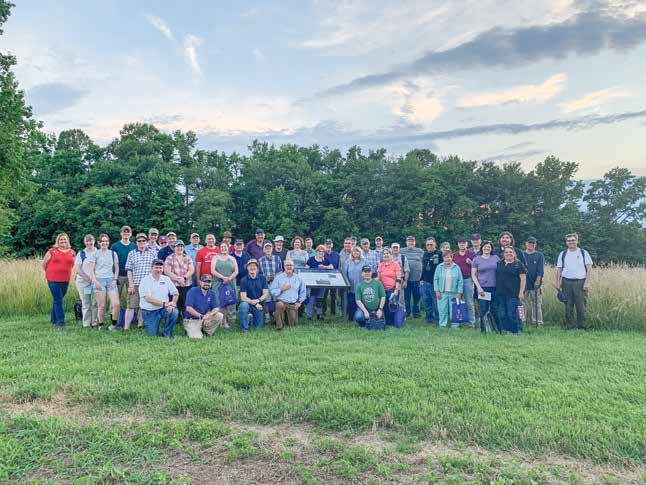

To mark the 158th anniversary of the Battle of Gettysburg, American Battlefield Trust staff ventured into the field July 1-3, for the fifth rendition of “Gettysburg Live,” a series of videos that explore and give context to the battle from a variety of angles. This year, a special focus was placed on the perspective of the soldiers who fought at Gettysburg, as the Trust was joined by Ancestry/ Fold3 to unearth little-known stories, and connect them with primary source documents made easily accessible on the platforms. Interestingly, some stories were inspired by submissions from Trust’s members and followers.
Trekking across the battlefield on its anniversary, the Trust entertained with a plethora of video content shared across Facebook and YouTube. To add even more excitement, the crew was joined by special guests from the Gettysburg Foundation, the Adams County Historical Society, and the National Park Service. In some cases, artifacts from the engagement were returned to the battlefield for the first time since the conflict. From Gettysburg novices to Civil War buffs, there was plenty to learn and see during the three-day adventure to places both familiar and off the beaten path. To view the video series, be sure to check out the Trust’s YouTube channel.
Such a commemoration would be incomplete without the Trust’s efforts to protect integral hallowed ground connected to the Gettysburg Campaign. Our latest initiative targets 158 acres across the Gettysburg and Second Winchester Battlefields. The equivalent of 119 football fields, this precious land is valued at $9.8 million, but with the assistance of government grants, a generous landowner donation, a grant from the HTR Foundation, and the Shenandoah Valley Battlefields Foundation, 96.4% of the total has been obtained,
leaving $350,000 to be raised.
Of the acres eyed for preservation, 154 in Northern Virginia are tied to the June 13-15, 1863, Battle of Second Winchester.

Pitting Confederate Gen. Richard Ewell against the Union’s Gen. Robert Milroy, the fight at Winchester was a decisive victory for the Confederates because it created an opening for Gen. Robert E. Lee’s northward march.
At Gettysburg, the four-acre tract in question is located on the slopes of East Cemetery Hill, abutting the Baltimore Pike and sitting just below the crest of the Union artillery position on Stevens Knoll. It felt the footsteps of tens of thousands of Union troops, as they marched in front of, paused on, passed over, or fought on the land during the second day’s fighting. In the present day, this property is known as the site of the Battlefield Military Museum.
Just last year, the Trust acquired an adjacent property, including the historic James McKnight House from its long-time owners. The organization now has an once-in-a-lifetime opportunity to purchase the property’s remaining four acres for preservation and restoration efforts that will turn back the clock to 1863, so that if Gen. George Meade’s troops were to somehow march up to the site again, they would know exactly where they were.
Victory at Three Western Theater Battlefields Yields Interpretive Opportunities Aplenty
By adding 99 acres of hallowed ground at three Civil War battlefields to its already-robust victory portfolio, the American Battlefield Trust marked several milestones. The feat is especially gratifying for fans of the Western Theater, as it adds more than 22 acres at Shiloh, Tenn., and upwards of 76 acres associated with the Vicksburg Campaign in Mississippi, nearly 44 acres at Raymond and just short of 33 acres at Vicksburg itself. These acres carry a hefty value of approximately $1.5 million, but with essential partners backing
perspectives upon visitors. Just think, the property at Shiloh will create public access to an area that witnessed part of the initial large-scale Confederate assaults against Union camps on the morning of April 6, 1862. A benefit to today’s students, and those to follow, the context engrained in this acreage will paint a fuller, more vibrant picture of life in the Civil War’s vast Western Theater.
www.battlefields.org/preserve/ celebrate-our-victories.
Let Your Adventurous Spirit Lead the Way: Explore America’s Battlefields This Summer!
the organization’s ambitious efforts, the balance needed from Trust members went down to $553,330.
The multi-part victory will enable interpreters to unleash new
These victories were made possible through the support of the American Battlefield Protection Program, the Friends of Raymond, and the Friends of Vicksburg National Military Park. Learn more about the Trust’s latest preservation victories at
Summer is the ideal time for outdoor adventures, and the Trust has turned its attention to battlefield destinations primed for exploration. A wonderful way to interact with these unique landscapes is through battlefield trails that have been precisely paved to navigate stories situated upon the hallowed ground. The Trust itself has 13 trails serving as gateways
12 Civil War News August 2021 12 Civil War News August 2021
Shiloh National Military Park. Harper’s Jefferson (Mississippi) Artillery was mustered at Fayette, Miss., on April 13, 1861, The battery was armed with two 6-pounder cannons and four 12-pounder howitzers. Photo by Mike Talplacido.
Slaughter Pen Farm at Fredericksburg Battlefield. Trust members were thrilled to be back on the field at our first “Twilight Tour.” Photo by American Battlefield Trust.
to the past. On land that the organization has worked tirelessly to protect, these paths bring hikers through the same terrain that Civil War soldiers would have traversed. Engage with these Trust trails at Brandy Station, Cedar Mountain, Chancellorsville, Fredericksburg, Gettysburg, McDowell, Mine Run, Hatcher’s Run, Reams Station, Petersburg, and White Oak Road. Do make sure to pack accordingly, stay on the marked trails, and watch out for creatures big and small. Also remember, the learning experience can go beyond the trails’ interpretive signage, as the Trust has Battle App® guides available at several sites!
You’ll also find the Trust and its members embarking on “Twilight Tours” this summer. After a yearlong lull without in-person gatherings, the organization was excited to return to the fields and offer these unique, evening experiences to its patient preservationist following. With a slew of experts steering the way, 27 tours will take place at Revolutionary War and Civil War battlefields across Virginia, Pennsylvania,
North Carolina, New Jersey, Mississippi, and Kentucky. Donors who live in proximity to selected locations will receive an email with registration instructions. To keep up with the Trust’s latest events, please visit www. battlefields.org/events.



Virtual Reality Series Wins GLAMi Award
The Trust has won a 2021 GLAMi award for its immersive storytelling project Civil War 1864: A Virtual Reality Experience! Short for “Galleries, Libraries, Archives, and Museums Innovation,” the GLAMi’s are coordinated by MuseWeb to recognize and celebrate the most innovative projects in the cultural heritage sector annually.
Civil War 1864 was recognized as “Of Note” in the Interactive and Immersive category, an impressive achievement in a field that featured nominees from 20 countries. The captivating, four-part series was created by the Trust in collaboration with our longtime video partner Wide Awake Films, an Emmy-award-winning
historical media company. When it debuted, the project garnered 300,000 views in its first two weeks on YouTube and has since grown to more than 2.5 million. Plans are in process to create more virtual reality content that brings the past to life.

13 August 2021 Civil War News 13 August 2021 Civil War News
Join the Crew! civilwarnavy.com 1 Year—4 Issues: $37.95 Subscribe Now at civilwarnavy.com Or send a check to: CSA Media, 29 Edenham Court, Brunswick, GA 31523 International subscriptions subject to postage surcharge. 48 E. Patrick St., Frederick, MD. 301-695-1864 / civilwarmed.org Divided by Conflict. United by Compassion. Want To Advertise In Civil War News? Email us at: ads@civilwarnews.com
Fredericksburg, Va., Battlefield visitors embrace the words of the Greek philosopher Pythagoras as they “leave the road, take the trails.” Photo by American Battlefield Trust.
2nd Corps Field Hospital Offered Wounded Soldiers Compassion and Comfort
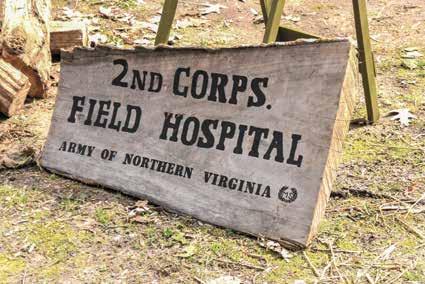 by Bob Ruegsegger
by Bob Ruegsegger
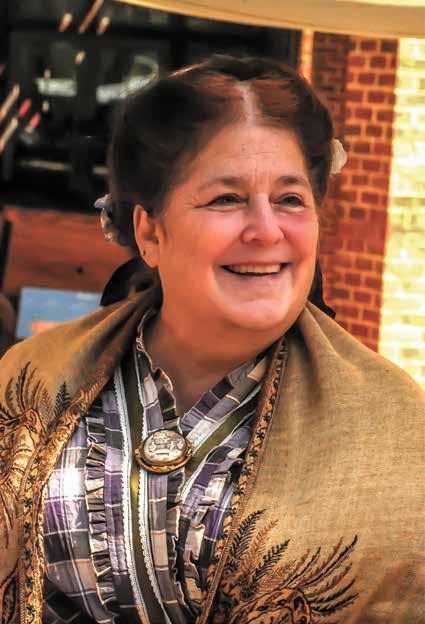
Casualties during battles such as Antietam, Spotsylvania, and Gettysburg were staggering. Although frequently overwhelmed, surgeons at field hospitals regularly treated both Confederate and Union casualties without prejudice. Ambulance drivers, surgeons, and volunteers with Dr. Hunter H. McGuire’s 2nd Corps Army of Northern Virginia Field Hospital saw the suffering of the soldiers and applied their respective trades to putting shattered lives back together.
Ambulance corps members were the first responders on the battlefield. They went out under the direction of an assistant surgeon who had an aid station marked with a flag. Those soldiers with flesh wounds, the walking wounded, would look for the flag and walk to the aid station for help. Ambulance corps members would go out on the field to stabilize the wounded who couldn’t walk, load them onto the ambulances, and take them to the field hospital. Ambulances were equipped with standard medical supplies, splints, bandages of assorted sizes, and field
tourniquets. A pint-sized flask of alcohol was used as a stimulant.
Typical wagons didn’t have a suspension system. Every bump in the road could be felt. Wounded men would feel every move the wagon made. Ambulances had an elaborate spring suspension system that dampened the jolts as the ambulance traveled to the field hospital. Cushions lined the beds of the ambulances.
Field hospitals were seen as temporary and generally located in large homes, churches, or barns. They were filthy places filled with suffering and disease. Infection was the biggest concern due to poor sanitary conditions. Surgeons did not wash their hands or surgical instruments between operations. Surgeons did not understand how disease was spread. Germ theory had not been developed and there were no antibiotics.
“If you were shot in the abdomen your chance of survival wasn’t very good,” said Robert Hester who portrays a member of the ambulance corps. “They knew that your chances of living were probably slim to none. With a chest wound or an abdominal
wound the soldier was probably not going to live.”
Three-quarters of all Civil War surgeries were amputations and often done in a field hospital. Surgeons became so skilled at cutting off limbs that they were nicknamed “sawbones” by the soldiers. While a soldier’s chances of surviving an amputation were good, there was the possibility that an infection could develop into gangrene. “Surgeons applied their skills in these field hospitals. An amputation could be done within ten minutes. The surgeons got really good at amputating,” said Hester. “If it was a hand, one surgeon could be designated to do the job. They could do it for 36 hours,” he said. “Your best surgeons operated on an arm or a leg, a particular limb of the body.”
“Triage really made a huge difference in the survivability of those men as the war progressed,” said Hester. “By the spring of ’62, Dr. McGuire had perfected that system in the Army of Northern Virginia,” said Hester.

If wounded soldiers could be transported to a general hospital for long-term care, the survival
rate for the sick and injured went up dramatically. The triage that was developed in the course of the war also produced a tremendous improvement in the survival rate. Chimborazo Hospital in Richmond was the largest hospital in the South. The survival rate there was 90% which was phenomenal and partially due to it being a clean, well-managed facility.
Harry Sonntag portrays a surgeon in the 2nd Corps Army of
Northern Virginia Field Hospital. Often Sonntag portrays Dr. Hunter H. McGuire. The characterization of Civil War surgeons as “butchers” was inaccurate and patently false according to Sonntag. “These men were very compassionate. They were highly educated. They cared about the sanctity of human life,” said Sonntag. “They used every means possible in their era to try to alleviate pain and suffering. They cared for both sides.
Sonntag’s field hospital impression consists of shelters of several sizes, a fly where amputations are performed, an infirmary tent, and medical instruments and medicines. On a table under the surgical fly, Sonntag points out a bowl of fibrous linen material called sharpy that was used for packing wounds and a brass screw tourniquet. “They used chloroform or ether when they put the wounded soldiers to sleep for a surgical procedure,” said Sonntag. “They felt no pain during the amputations that lasted anywhere from ten to fifteen minutes. A good surgeon could remove an arm or leg in about that time.”
Dr. McGuire was the medical director of the 2nd Corps. He was involved in caring for the wounded after every major engagement. McGuire was responsible for the entire 2nd Corps, some 20,000 men and 30 field hospitals. “He was a remarkable man for his age,” said Sonntag. “He is most well-known during the war for being Stonewall Jackson’s surgeon. He developed several surgical procedures.
After the war, Dr. McGuire distinguished himself by establishing a hospital, nursing school, infirmary, and a nursing home for Confederate veterans in Richmond. Dr. McGuire
14 Civil War News August 2021 14 Civil War News August 2021
The Second Corps, Army of Northern Virginia, Field Hospital was among 30 field hospitals under the direction of Dr. Hunter McGuire.
Carol Porkinghorne offering commentary on how women contributed to the mission of the field hospitals.
Denise Wierzbicki emphasized the sanitary measures that women introduced to the field hospital setting that reduced the recovery time of the soldiers.
also served as the president of the American Heart Association and the American Surgical Association. “All those things led him to become a wellknown, prominent surgeon in the Richmond area during his era,” said Sonntag. “He’s memorialized with a statue on the Virginia Capital grounds, next to Jackson.” Dr. McGuire, his surgeons, and ambulance corps had invaluable help in accomplishing their mission of stabilizing and caring for
sick and wounded soldiers.
Inestimable support came from women who volunteered their service on the battlefield and in field hospitals. Initially, Southern soldiers in the medical field did not want women in hospitals or nursing. They did not feel that women should be exposed to the sights, smells, and sounds of the suffering men. If there was a battle occurring nearby, women would usually wait until the fighting calmed down before they’d
venture forth from their homes to offer succor. They would go out and offer assistance, anything to comfort injured soldiers. They’d often help transport them to the field hospitals,” said Ashley Sonntag, site manager for the Cedar Creek Battlefield Foundation in Middletown, Va.

“In field hospital settings, officially, there were no female nurses, but women volunteers wrote letters and documented what was happening,” Sonntag observed. When women were finally allowed to come in, they introduced sanitary measures such as boiling, cleaning, and washing. Patients got better faster. “Women are clean. They made sure the hospital beds were clean and the sheets sterile,” said Denise Wierzbicki, historic interpreter with the 2nd Corps. “Allowing women to come in to make sure things were clean helped to make the recovery time of soldiers shorter,” she noted. “Southern women were very devoted to the cause. They were more devout, sometimes, than Southern soldiers. They did anything they could do to help.“
“The main role for women at the hospitals was providing comfort, changing bandages, and things of that nature.” Women often read the Bible to the wounded men in the field hospitals. They brewed herbal teas and concocted herbal remedies that offered comfort. They often cooked meals to feed the wounded and ill soldiers who had been left behind.
Women documented the names of the dead and wounded. “They would write letters home, sometimes the last letter,” said Carol Porkinghorne, living history interpreter with the 2nd Corps Field Hospital. “These women took care of their families and
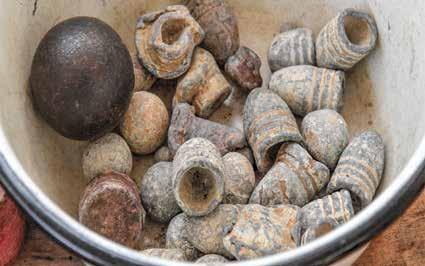
they took care of the soldiers too. They hoped women on the other side would do the same,” she said. “The women really took care of the men, doing as much as they could do”
Bob Ruegsegger is an American by birth and a Virginian. His assignments frequently take him to historic sites throughout
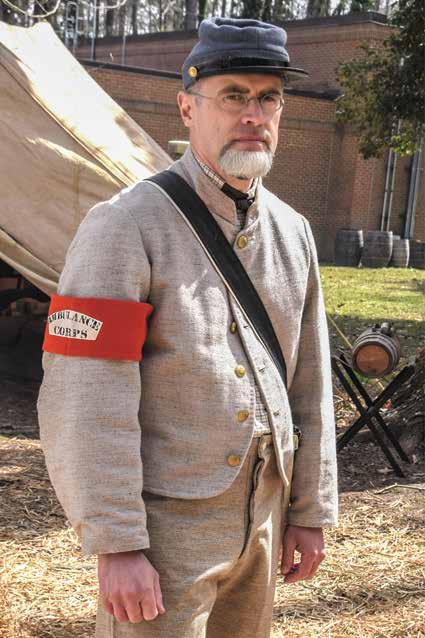
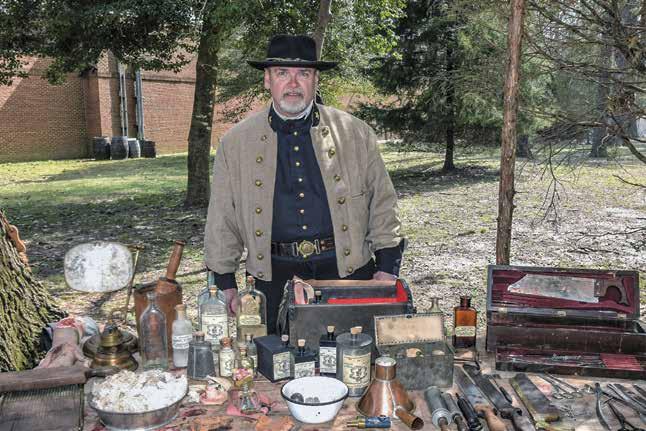
Virginia, the Mid-Atlantic, and the Southeast. His favorite haunts include sites within Virginia’s Historic Triangle—Jamestown, Yorktown, and Williamsburg. Bob served briefly in the U.S. Navy. He is a retired educator and has been an active newspaper journalist for the last twenty years.

15 August 2021 Civil War News 15 August 2021 Civil War News
The impact from large caliber bullets often shattered bones so badly that amputation was frequently the only practical resolution to an arm or leg injury.
Harry Sonntag discussing the use of surgical instruments and medicines with visitors to the 2nd Corps Field Hospital.
Ambulance Corps personnel were the first responders. “If you could get men to a general hospital for long-term care, the survival rate went up,” said Robert Hester.
After surgery, often an amputation, soldiers were sheltered in an infirmary tent while they recovered from the procedure.
Introducing the Antietam Institute

A group dedicated to studying the Battle of Antietam and the 1862 Maryland Campaign have organized the Antietam Institute, a member-based 501(c) (3) non-profit educational and philanthropic organization dedicated to providing and supporting a wide range of educational and scholarly endeavors.

The Institute will provide many educational experiences, such as a fall conference, spring symposium, publications, and other events. The Institute’s first official event, the First Annual Fall Conference, will be held on weekend of October 15–17, 2021, and feature several presentations, three battlefield excursions, a panel discussion, and keynote address by a prominent authority on the battle and campaign. In addition, the first one-day Annual Spring Symposium will be held April 23, 2022, and will showcase a variety of presentations and discussions about the 1862 Maryland Campaign. Plans are also being made for leadership forums and teacher programs.
The Institute will also publish a number of works relating to the Maryland Campaign, including a bi-annual publication of the Antietam Journal. Its first edition will be available just before
the Houston Civil War Round Table (HCWRT) announces that it has awarded the Frank E. Vandiver Award of Merit to Dr. Donald S. Frazier.
The Vandiver Award recognizes outstanding contributions to Civil War scholarship or preservation efforts by an individual or an institution. Presented annually, the award honors the memory of Dr. Frank Everson Vandiver (1925–2005), a renowned Civil War historian and one of the earliest members of HCWRT.
HCWRT selected Dr. Frazier for this year’s award based on his contributions to the historiography of the Trans-Mississippi Theater of the Civil War as well as his service as a Civil War tour guide, speaker, and preservationist over a career spanning more than three decades.
HCWRT Communications Chair membership@houstoncivilwar.com
C. Michael Harrington
HCWRT President president@houstoncivilwar.com
713-899-3726
Newly renovated Wilson’s Creek National Battlefield Visitor Center and Museum now open
New exhibits showcase more artifacts from the museum collection
will also see new displays of the park’s impressive collection of edged weapons and firearms, including a rare Model 1860 Henry repeating rifle, recently donated to the park by the Wilson’s Creek National Battlefield Foundation. The museum provides several interactive and accessible audio-visual displays and virtual displays, making it possible for people to view historic weapons demonstrations and digitally view fragile artifacts and other items in storage.
the 159th anniversary of the 1862 Maryland Campaign. The Institute will also serve as a publishing house for other research and scholarship, including The Brigades of Antietam (2021), and The Artillery Units of Antietam (2022).
The Antietam Institute will house a Historical Research Center (HRC), an online locus for collecting, preserving, and disseminating in digital form, historical information related to the 1862 Maryland Campaign. Institute members will have direct access to these unique source materials.
The Institute intends to make donations to battlefield parks, local preservation groups, and other historical organizations that share the Institute’s goals of promoting the 1862 Maryland Campaign.
Individuals with an interest in the 1862 Maryland Campaign are encouraged to visit the Institute’s website (antietaminstitute.org) or email info@antietaminstitute. org.
Donald S. Frazier
Receives Houston Civil War Round Table’s
“Frank E. Vandiver Award of Merit”
HOUSTON, Texas—May 23. Continuing a 39-year tradition,
A native Texan, Don Frazier did his undergraduate work at the University of Texas at Arlington; and he received a Ph.D. in history from Texas Christian University where he began his long association with the late Grady McWhiney. A history professor at McMurry University in Abilene for many years, Dr. Frazier is currently the Director of The Texas Center at Schreiner University in Kerrville, Texas. A prolific writer on the Civil War in the West, Dr. Frazier is especially noted for his four books on the war in Louisiana and Texas. He is at work on an addition to his Louisiana Quadrille, a book chronicling the Red River Campaign.
In announcing the award to Dr. Frazier, President Mike Harrington commented: “It is a real privilege to honor yet another outstanding member of the Civil War community, especially one who has extended Civil War historiography to beyond the Mississippi River.”
An oversized wooden Minié ball symbolizing the award was presented to Dr. Frazier at the monthly meeting of HCWRT on May 20, 2021.
Lynda Crist, a long-time member of HCWRT and editor of the Jefferson Davis Papers at Rice University, was the first Vandiver Award recipient in 1982. Other past winners include Gary Gallagher, Ed Bearss, Richard Sommers, William
C. “Jack” Davis, Ed Cotham, Frank O’Reilly, Don Troiani, James “Bud” Robertson, Eric Jacobson, Gordon Rhea, James McPherson, Wilson Greene, and Brian Steel Wills. The addition of Don Frazier to this distinguished group of Vandiver Award winners only adds to its luster.
Contacts:
T. Scott Wilkey
Republic, Mo.—National Park Service officials were joined by Senator Roy Blunt, Congressman Billy Long, and members of the Wilson’s Creek National Battlefield Foundation at a ribbon-cutting ceremony May 28, 2021, to mark completion of the 18-month, $3.5 million renovation project and welcome visitors back to Wilson’s Creek National Battlefield Visitor Center and Museum. NPS staff and volunteers in period uniforms celebrated with a special artillery firing.
Administered by the National Park Service, Wilson’s Creek National Battlefield preserves the site of the first major battle of the Civil War in the West. The Confederate victory on August 10, 1861, focused greater national attention on the war in Missouri, leading to greater Federal military action. The park features a significant museum collection and substantial research library in addition to a well-preserved battlefield, 5-mile tour road, historic structures including the 1852 Ray House, a preserved section of the historic Wire Road, and hiking and horseback riding trails.
“It is my honor to bring this project to a successful conclusion and welcome visitors, near and far, to once again learn more about this significant historical event and experience the new exhibits,” said Wilson’s Creek National Battlefield Superintendent Sarah Cunningham. “We could not have accomplished this substantial improvement to the visitor experience and protection of the collection without the strong partnership of the Wilson’s Creek National Battlefield Foundation, the work of many dedicated employees and volunteers, and the support of the National Park Foundation.”
The renovation added approximately 1,800 square feet of new museum exhibit space, enabling visitors to view the park’s extensive collection of Civil War artifacts. It features the original “Lyon bed,” where the body of Union General Nathaniel Lyon was laid after his death during the battle of Wilson’s Creek. Visitors
Improvements also include a redesign of the bookstore, information desk and bathrooms, added curatorial storage and employee workspaces, and a new HVAC system to ensure long-term preservation of museum artifacts and visitor comfort. All the renovations, including expansion of the museum, were kept within the existing footprint of the Visitor Center complex. The John K. and Ruth Hulston Civil War Research Library also will also be reopened to the public starting Saturday, May 29.
Wilson’s Creek National Battlefield Foundation President Garin Ferguson commented, “Our Foundation is pleased to have played a significant role in completing the visitor center renovation project by providing a portion of the funding, purchasing important artifacts, and contributing to the funding of stateof-the-art video interpretations.
The new museum exhibits will enhance the experience of more than 200,000 visitors who come to Wilson’s Creek each year. We are confident that this project exemplifies our mission of preserving and protecting Wilson’s Creek National Battlefield.”
“The renovated Wilson’s Creek National Battlefield Visitor Center and Museum will put historical interpretation at the fingertips of park visitors, connecting more people to the heritage we share,” said National Park Foundation President and CEO Will Shafroth. “The National Park Foundation is grateful for the innovative, public-private partnership funding model that helped bring this project to life, matching $500,000 in philanthropic support from the Wilson’s Creek National Battlefield Foundation with $500,000 in federal funding authorized and appropriated for NPF under the National Park Service Centennial Act.”
Beginning today, the Wilson’s Creek National Battlefield Visitor Center and Museum is open seven days a week from 8 a.m. to 5 p.m. Entrance fees will resume on Saturday, May 29. Details on park hours, fees and passes are available on the park’s website
16 Civil War News August 2021 16 Civil War News August 2021
and the new NPS app.
Consistent with CDC recommendations, people who are not fully vaccinated must continue to wear masks indoors and in crowded outdoor spaces. Masks are required for everyone on all forms of public transportation. Additional details are available at www.nps.gov/coronavirus. As conditions are subject to change, visitors should check the park’s website and social media channels for details on operations before they visit.
Awards for Excellence in U.S. Army History
Writing
FORT BELVOIR, Virginia —
The Army Historical Foundation is pleased to announce the winners of the 2020 Army Historical Foundation Distinguished Writing Awards. The 2020 awards honor books and articles published in 2020.
Book Awards
Biography
Courage Above All Things: General John Ellis Wool and the U.S. Military, 1812–1863, by Harwood P. Hinton and Jerry Thompson (University of Oklahoma Press)
Operational/Battle History
The US Volunteers in the Southern Philippines: Counterinsurgency, Pacification, and Collaboration, 1899–1901, by John Scott Reed (University Press of Kansas)
Institutional/Functional History
Civil War Supply and Strategy: Feeding Men and Moving Armies, by Earl J. Hess (Louisiana State University Press)
Journals, Memoirs, and Letters
Rangers Led the Way: WWII Army Rangers in Their Own Words, by Chris Ketcherside and George Despotis, MD (Schiffer Military)
Unit History
To the Last Man: A National Guard Regiment in the Great War, 1917–1919, by Jonathan D. Bratten (Army University Press)
Reference and Compilation
Civil War Flags of Tennessee, by Stephen D. Cox (University of Tennessee Press)
Article Awards
Academic Journals
“‘Our Army will hut this Winter at Valley Forge’: George
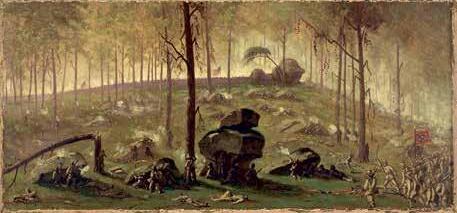
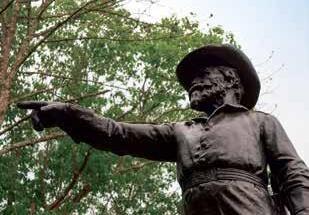
Washington, Decision Making, and the Councils of War,” by Ricardo A. Herrera. Army History, Fall 2020.
Journals and Magazines
“‘Ernie Was One of Us’”, by Roy Morris Jr. MHQ–The Quarterly Journal of Military History, Autumn 2020.
The book award winners receive a plaque honoring the book and a $1,000 cash award. The article award winners also received a plaque and a $250 cash award.
The Army Historical Foundation, a non-profit, tax-exempt organization, is dedicated to preserving the history and heritage of the American soldier. Its goal is to promote greater public appreciation for the contributions that America’s Army — Regular, Reserve, and National Guard — has made to the nation in 244 years of service. The Foundation is the principal fundraiser for the National Museum of the United States Army at Fort Belvoir, Va., which opened to the public on November 11, 2020.
In addition to fundraising for the National Museum of the United States Army, the Foundation’s projects and activities include refurbishment of historical Army buildings; acquisition and
conservation of historical art, artifacts, and documents; support of Army history education programs; historical research; publication of historical materials on the American soldier; and providing counsel and support to private and governmental organizations committed to the same goals as the Foundation.
The AHF Distinguished Writing Awards program was established in 1997 to recognize authors who make a significant contribution to the literature on U.S.





Army history. Each year nominations are submitted to the Awards Committee by publishers and journal editors. A small group of finalists are selected, and a final judging is made. The winners are announced in the spring.
Thank you to all the book publishers and journals/magazines who submitted nominees for this year’s awards.

For more information on the Foundation and its activities, please view the AHF website at www.armyhistory.org.

17 August 2021 Civil War News 17 August 2021 Civil War News
Join us in the rehabilitation of Culp’s Hill. Improved sightlines, more visitor access and additional interpretive signage will help provide visitors with insights into the key battle site on Culp’s Hill, July 2–3, 1863. To learn more and donate to the Culp’s Hill Rehabilitation Project, visit GettysburgFoundation.org/Culps. 866-889-1243 | GettysburgFoundation.org
— U
” “
These rocks and trees offered good cover for marksmen. The surface was very steep on our left, diminishing to a gentle slope on our right.
NION B RIGADIER G ENERAL G EORGE S EARS G REENE ON C ULP ’ S H ILL .
– MAKER –LEATHER WORKS (845) 339-4916 or email sales@dellsleatherworks.com WWW. DELLSLEATHERWORKS.COM
The First Unconditional Surrender
“A private concern would be ruined by conducting business as it is carried on here.” – Gustavus Vasa Fox, U.S. Asst. Sec. of the Navy
On April 19, 1861, President Abraham Lincoln, proclaimed a blockade of Southern ports. To enforce the blockade, Lincoln would oversee the Navy’s growth and development from 42 steam and sailing ships to hundreds of armed fast steamships. Lincoln, who would admit to Gideon Wells, Sec. of the Navy that “I know little about ships,” would build the largest naval force in size and number of ships until the start of the world wars.
Welles had to energize the stagnant government office naval officers considered “the most rickety and stupid of all.” The staff of seventy-four worked a six-hour day and were sticklers for “forms and red tape.” Welles added 20 clerks, an additional work hour, barred unofficial visitors, unexcused absences, and “behindhand” clerks could not leave before normal work was completed.
To counter the Union blockade, Confederate President Jefferson Davis issued letters of marque, authorizing Confederate privateers. The Winslow, a side wheel steamboat sporting one gun, was capturing prizes and taking them into Hatteras Inlet, N.C. The inlet made it possible to bring goods through the Dismal Swamp Canal to Chesapeake Bay and on to Richmond, Va.
Two earthworks, Fort Hatteras mounting twelve 32-pdrs. and a 10-inch columbiad and Fort Clark with five 32-pdrs. and two 8-inch howitzers, were built to protect the narrow channel inlet, which had a shoal across the entrance and a water depth of about seven and a half feet. Defended by about 350 men, the chief engineer of the coastal defenses, “… consider[ed] this inlet secure against any attempt of the enemy to enter it.”
U.S. Gen. Benjamin Butler conceived a plan to seize the Hatteras Inlet forts. Butler would lead 860 men from the 20th N.Y.,
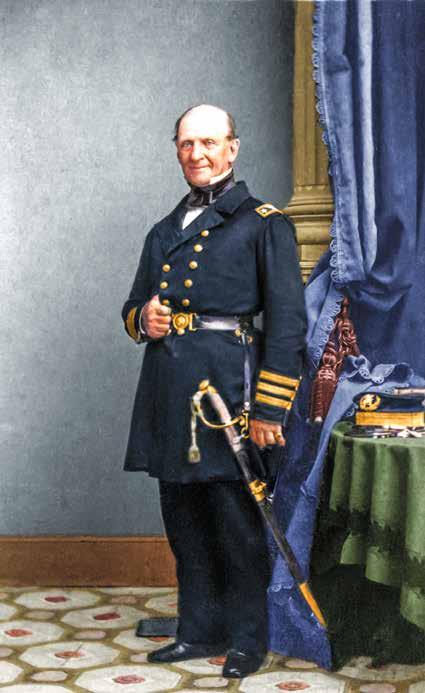
9th N.Y. Zouaves, U. S. Coast Guard, and 2nd U.S. Artillery.
Silas H. Stringham, Cmdr. of the Atlantic Blockading Squadron, would command warships carrying 141 guns and two troop transports. The plan was swiftly put together and approved. The adage that one gun in a shore fortification was worth four on shipboard was about to be tested.
On August 25, the troops were ordered to get ready to depart with ten days of rations and 140 rounds of ammunition. On the 26th, the ships arrived off Hatteras. On the 28th, three warships were assigned to cover and assist men going ashore about three miles north of the inlet. When landing boats sent through the turbulent waves broke up in the surf, two hulks filled with troops, were allowed to drift through the breakers to reach the shore by using a windlass and cable. About 318 men landed soaked to the shoulders, with wet ammunition, without food and, with the addition of
high winds in the late afternoon, serious concerns whether they could be rescued off the beach.
The Battle of Hatteras Inlet began at 10 a.m., with Stringham’s bombardment of Fort Clark. He used the innovative tactic of steaming in a circle to generate moving targets. The Minnesota (42 guns) and Wabash (23 guns) fired their Dahlgren cannon with shot and shells weighing from 68 to 120 lbs. The sailing frigate Cumberland, undertow by the Wabash, fired its 22 9-inch Dahlgrens and was later joined by the Susquehana with 15 more guns.
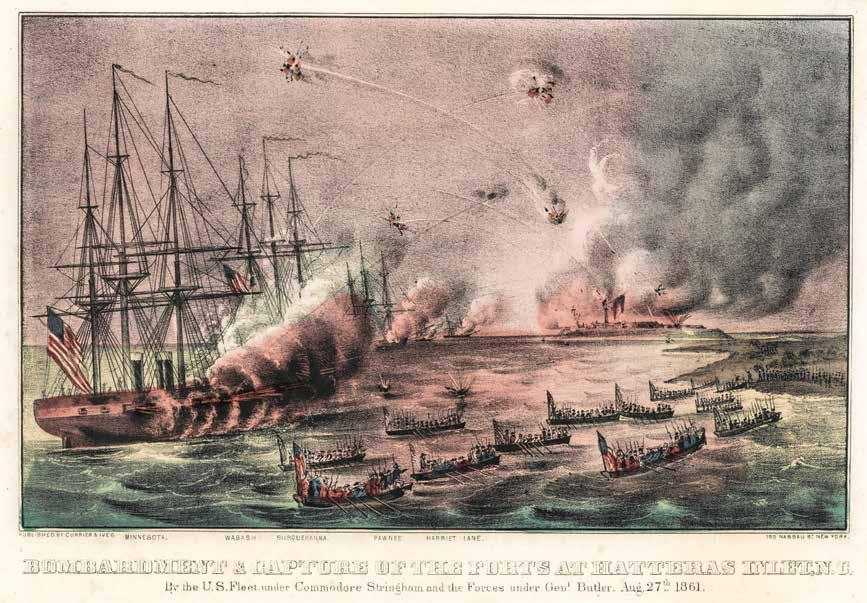
It was a one-sided bombardment. Fort Clark’s seven guns were outranged but continued to return fire until out of powder. The guns were then spiked and the fort evacuated. At 12:25 p.m. the flags of both forts’ were lowered. Men could be seen running from Fort Clark to Hatteras.
About 4 p.m., Stringham ordered the shallow hulled



18 Civil War News August 2021 18 Civil War News August 2021
Capture of the Forts at Cape Hatteras inlet – First day, fleet opening fire and troops landing in the surf. Library of Congress.
Admiral Silas H. Stringham, Colorization © 2021 civilwarincolor. com. Courtesy civilwarincolor.com/cwn. Library of Congress.
Monticello to reconnoiter past the inlet. Seizing the opportunity, C.S. Col. Wm. F. Martin, 7th N.C. Volunteers, ordered cannon to open fire, hitting the Monticello repeatedly. Stringham’s guns returned fire; after two hours, the ships ceased firing, and except for the ships covering men ashore, hauled off for the night.
Overnight, C.S. Capt. Samuel Barron arrived with reinforcements. William Seward, U.S. Sec. of State had hoped that Barron would help keep Virginia in the Union. Instead, he resigned and in July, had been appointed Cmdr. of coastal defenses of Virginia and North Carolina. Barron took over the defense of the inlet’s forts.
On August 29, Stringham resumed the bombardment of the Hatteras forts. “It was terrible to watch the large shells as they came down on the fort bursting almost as they struck, scatter sand and tents, dismounting guns and tearing everything but the bombproof covers to pieces,” wrote Lt. Roswell H. Lamson, commanding the 10-inch forward pivot gun on the Wabash. “For a long time we fired a shell every three minutes from the forward gun, and it was nothing but a continual bursting of shells around, over, and among them.”
Again, the Confederates were outranged and ordered to protect themselves until reinforcements came. One officer counted 28 shells falling per minute. The magazine was set on fire, four men had been killed and about 30 men were seriously wounded.
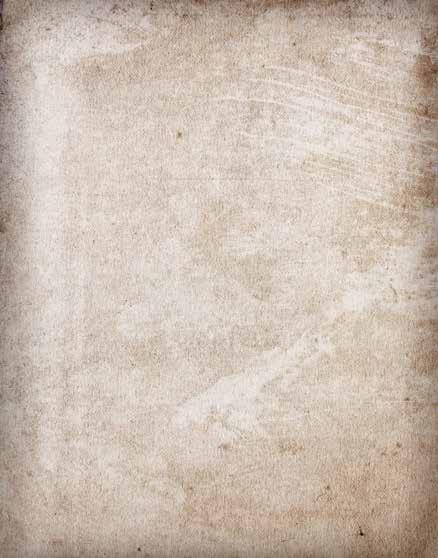

About noon the white flag was raised.
Stringham and Butler rushed back with news of their victory.
After the July 21, 1861, defeat at the Battle of First Manassas, Va., Hatteras Inlet was a huge morale booster. Gustavus Vasa Fox, described it as “… of national importance besides useful for our naval credit.”

During the summer, Congress enacted legislation that authorized the army and navy to disregard the principal of seniority if it was “for the good for the service.” Welles had been critical of Stringham so swiftly returning without attacking other forts in the Hatteras area. He later acknowledged that Stringham’s return was appropriate as he lacked rations for the men and shallow draft ships, had taken some 700 Confederate POWS, and left the 9th and 20th N.Y. at Hatteras to maintain a Federal presence.

In September, 64-year-old Stringham submitted his resignation. In acknowledgment


of his past service, he was promoted to rear Admiral, retired. As he suspected, the position of Cmdr. of the Atlantic Blockading Squadron would be given to two subsequently younger men. Welles was succeeding in pro moting more lively officers.
Still, six months before U.S. Gen. Ulysses Grant demanded “unconditional surrender” at Fort Donelson, Tenn.; it was required at Hatteras Inlet. Barron refused to surrender to Butler, whose men had basically done nothing. He insisted he would only “surren der to the men who had whipped him” and presented his sword to Stringham.
Sources:

Operations In North Carolina,” Battles And Leader Of The Civil War Vol. 1: The Century Company, 1884
Stephanie Hagiwara is the editor

CHARLESTON IN THE WAR
CHARLESTON IN THE WAR
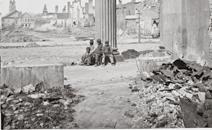

• McPherson, James M., on the Waters, The Union & Confederate Navies, 1861–1865: The University of North Carolina Press, 2012
• Symonds, Craig L., Lincoln And His Admirals: Oxford University Press Inc., 2008

• Anderson, Ben., The Naval History of the Civil War: Alfred A. Knopf, Inc. 1962
• Hoogenboom, Ari, Gustavus Vasa Fox of the Union Navy: A Biography: John Hopkins University Press, 2008
• Hawkins, Rush C., “Early Coast
War in 3D.com. She also writes a column for History in Full Color. com that covers stories of photographs of historical interest from the 1850’s to the present. Her articles can be found on Facebook, Tumblr and Pinterest.
19 August 2021 Civil War News 19 August 2021 Civil War News
100 Signi cant Civil War Photographs: Charleston in the War features newly restored images of scenes in the famed city, taken 1860–1865. e cameramen include the better-known, such as George N. Barnard and George S. Cook, as well as some lesser-known ones: Samuel Cooley, Charles Quinby, the partners Haas & Peale, Osborn & Durbec. Text by Stephen Davis and Jack Melton accompanies each featured photograph, describing the pictured scenes and the history surrounding them. e selected images depict a variety of settings: that portion of Charleston known as e Battery, the “Burnt District” (the area of the city destroyed by the Great Fire of December 1861), the Charleston Arsenal, and the many churches that allow Charlestonians to call theirs “the Holy City.” Special sections of this book are devoted to the huge Blakely guns imported from England by the Confederates and close-ups of Barnard’s views. e history of Civil War Charleston goes back to e Defense of Charleston Harbor (1890) by John Johnson, Confederate major of engineers, and to Reminiscences of Forts Sumter and Moultrie in 1860-’61 (1876) by Capt. Abner Doubleday, Federal second-in-command. Since then Charlestonians have contributed to the history of their city, notably Robert N. Rosen and Richard W. Hatcher III. e historical text surrounding 100 Signi cant Photographs draws on these and other works. A unique feature is its reliance upon the writings of actual participants, such as Augustine T. Smythe (1842–1914) and Emma Edwards Holmes (1838–1910). As a contribution to this literature, 100 Signi cant Civil War Photographs: Charleston in the War o ers rewards for all readers, from the casual novice to the serious student.
DAVIS & MELTON 100 SIGNIFICANT CIVIL WAR PHOTOGRAPHS : CHARLESTON IN THE WAR 100 Signi cant Civil War Photographs: Charleston in the War features newly restored images of scenes in the famed city, taken 1860–1865. The cameramen include the better-known, such as George N. Barnard and George S. Cook, as well as some lesser-known ones: Samuel Cooley, Charles Quinby, the partners Haas & Peale, Osborn & Durbec. Text by Stephen Davis and Jack Melton accompanies each featured photograph, describing the pictured scenes and the history surrounding them. The selected images depict a variety of settings: that portion of Charleston known as The Battery, the “Burnt District” (the area of the city destroyed by the Great Fire of December 1861), the Charleston Arsenal, and the many churches that allow Charlestonians to call theirs “the Holy City.” Special sections of this book are devoted to the huge Blakely guns imported from England by the Confederates and close-ups of Barnard’s views. The history of Civil War Charleston goes back to The Defense of Charleston Harbor (1890) by John Johnson, Confederate major of engineers, and to Reminiscences of Forts Sumter and Moultrie in 1860-’61 (1876) by Capt. Abner Doubleday, Federal second-in-command. Since then Charlestonians have contributed to the history of their city, notably Robert N. Rosen and Richard W. Hatcher III. The historical text surrounding 100 Signi cant Photographs draws on these and other works. A unique feature is its reliance upon the writings of actual participants, such as Augustine T. Smythe (1842–1914) and Emma Edwards Holmes (1838–1910). As a contribution to this literature, 100 Signi cant Civil War Photographs: Charleston in the War o ers rewards for all readers, from the casual novice to the serious student. Stephen Davis JACK W. MELTON JR.
160 pages, Over 100 Photos, Maps, Index, Bibliography, Softcover. ISBN: 978-1-61850-167-7 $19.95 + 3.50 S&H Order online at www.HistoricalPubs.com or call 800-777-1862
Dyer’s Compendium: Part II Chronological Record of the Campaigns, Battles, Engagements, Actions, Combats, Sieges, Skirmishes, Etc.
The column for this month draws from a general overview of Dyer’s Compendium, as detailed in the August 2016 edition of The Source. This time, a focus on part two of the series will assist readers in quickly locating the dates of particular engagements and determining the Federal units involved in the action.
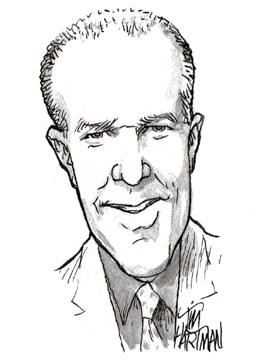
First, a brief recap from 2016. Frederick H. Dyer’s A Compendium of the War of the Rebellion focused almost exclusively on Federal units; little to no Confederate records were included. Dyer, a veteran of the 7th Connecticut Infantry Regiment, began amassing various resource materials soon after the war. He spent 40 years scouring the country, collecting regimental reports, gleaning newspaper accounts, consulting the Official Records, and talking with other veterans.
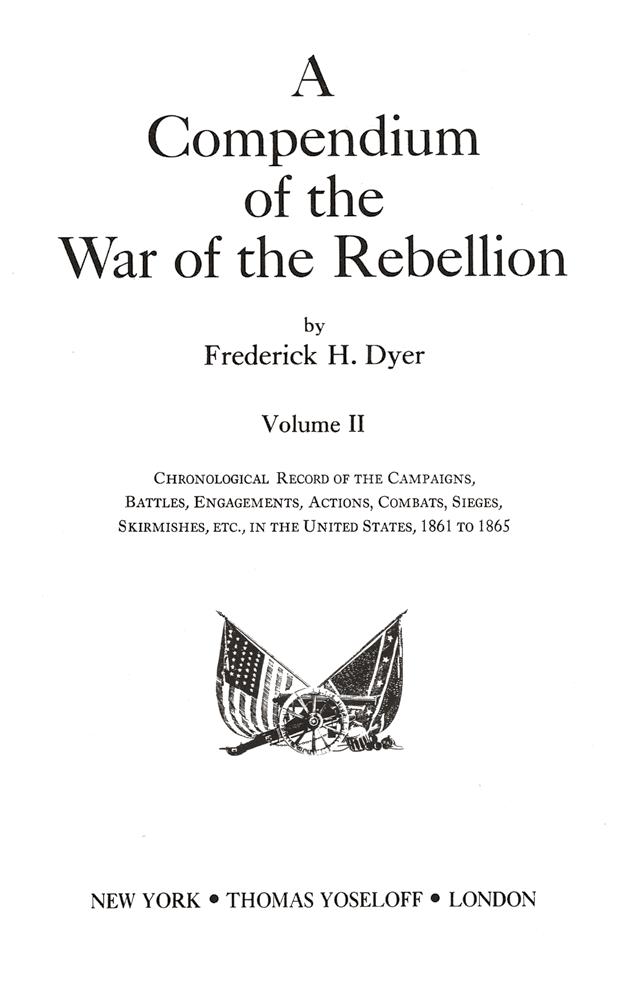
Initially published in 1909, a three-volume reprint under the guidance of Bell Wiley emerged just before the centennial. Morningside published another edition in 1978. This article references the 1959 version but remains applicable to any of the three versions in print.
Volume two opens with a most useful index of military actions

Dyer’s Compendium cover page.
listed alphabetically. In keeping with the cover date of this issue of CWN, this writer opted to search for a battle from August and, using the various indices within this volume, selected the August 5-7,
1864 Battle of Utoy Creek (see image shown). Next, the location of the main entry for this battle provides a listing of the Federal units present.
Researchers can consult the
Index showing Utoy Creek.
index at the end of volume three to find information from all the volumes. Remember to check WorldCat http://www.worldcat. org/ for help in finding this work in a local library. Search: ‘Dyer’s Compendium’ to locate this valuable source! Continued luck in your research!
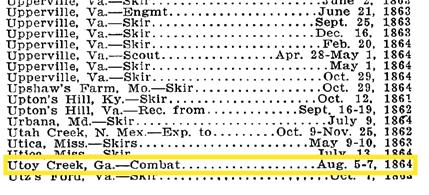
Michael K. Shaffer is a Civil War historian, author, lecturer, and
instructor, who remains a member of the Society of Civil War Historians, Historians of the Civil War Western Theater, and the Georgia Association of Historians. Readers may contact him at mkscdr11@gmail.com or request speaking engagements via his website www.civilwarhistorian.net. Follow Michael on Facebook www.facebook.com/michael.k.shaffer, and Twitter @michaelkshaffer.

20 Civil War News August 2021 20 Civil War News August 2021 Want to Advertise in Civil War News? Email us at: ads@civilwarnews.com
Federal Units at Utoy Creek.
Parker’s Crossroads Memorial Day Ceremony
by Professor Earnest Veritas Special Correspondent to Civil War News Western Theater
Memorial Day was solemnly observed in West Tennessee on the Parker’s Crossroads Battlefield May 31st, instant. With restrictions prohibiting the program being held in the West Tennessee Veteran’s Cemetery, the ceremonies were moved to the hallowed ground of Parker’s Crossroads battlefield nearby.
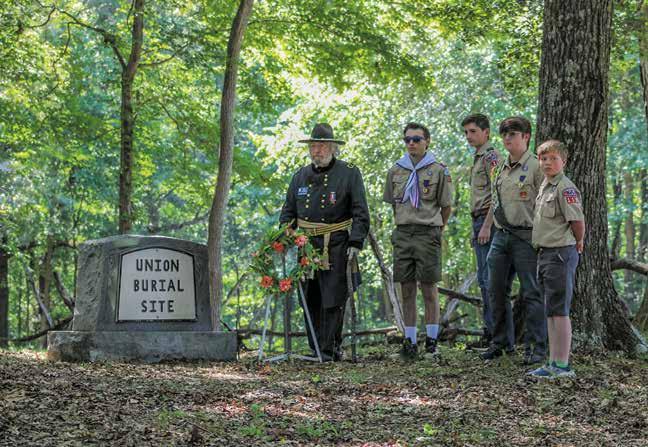
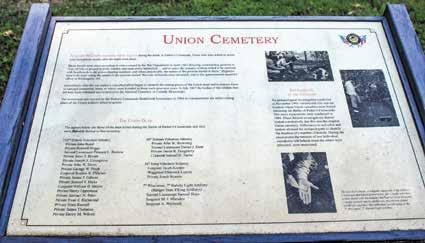

The Dec. 31, 1862, Battle of Parker’s Crossroads took place during General Nathan Bedford Forrest’s First West Tennessee Raid. Confederate forces led by Forrest met Union forces led by Gen. Jeremiah C. Sullivan on Dec. 31, 1862. It was significant for Forrest’s unique use of artillery against infantry and famous for its Confederate commander’s brazen maneuvering resulting in his famous command, “charge them both ways!”
Like many other similar ceremonies, the Memorial Day observation was well-attended and carried out with great dignity. Artillery units fired the salutes, Honor Guards posted colors, and General George Thomas (portrayed by Dr. Clyde J. Getman), with the assistance of the Boy Scouts, placed a memorial wreath at the marker where 29 Federal
soldiers killed in the fierce fighting, were buried. In July 1867, they were moved to the Corinth, Miss., National Cemetery. Only six bodies were identified. General Grant (portrayed by Dr. Curt Fields) uttered words appropriate for the occasion. The General talked of the first Memorial Day ceremony held at Arlington National Cemetery on May 30, 1868, over which he presided. He then read Major General John L. Logan’s, May 5, 1868, General Order No. 11 for the Grand Army of the Republic. That General Order officially established Memorial Day ceremonies nationally.
Noteworthy, however, for this
particular observation was the Honor Bell ceremony. The sad sounds of a tolling bell echoed across the battlefield and the crowd gathered there, poignantly adding to the reverence of those there and for the occasion. The procedure and meaning of each of the seven tolls of the bell are of great interest. They serve to remind us that each step taken within the ceremonies has significant import. Just as each fold of the flag has specific meaning, so do the seven tolls of the Honor Bell.
Honor Bell Ceremony For Veterans
At interment ceremonies, the Honor Bell is guarded and tolled by the Bell Guard. Tolling is the deliberate slow ringing of a bell to elicit sorrow and show respect. While many bells are rung for joy, one tolls a bell for sorrow.
Rendering bell honors is performed in a tradition known as the “ancient tolling method,” a perfect complement to the beauty of military rites. After the folded flag of the United States of America is presented to the next of kin, the Bell Guard provides a tribute of dignity, honor, and respect with the Seven Solemn Tolls of the Honor Bell. After the rendering of Bell Honors, the Bell is not tolled again until the next Bell Honors mission. At each funeral or memorial service for a veteran, the Bell Guard tolls the Honor Bell seven times, with seven seconds between each toll. These tolls represent the many stages in a veteran’s life. Each toll has a specific meaning:
Toll One: The Choice to Serve: This toll represents the veteran’s willingness to sacrifice their life for their country; a dedication to which few are called.
Toll Two: Camaraderie: The second toll represents the friendships, family, and unity that bond all service members together.
Toll Three: Patriotism: The third toll represents the veteran’s pride in their country, a duty to protect it, and the joy in celebrating the freedoms enshrined in our Constitution.
Toll Four: Respect: The fourth toll represents the respect given to a veteran by their community, earned by them and owed by us, for their service.
Toll Five: Dignity: The fifth toll represents the dignity with which a veteran’s community treats their fallen hero.
Toll Six: Honor: The sixth toll represents the honor that is due to a veteran when they have
died, given by their fellow service members and community.
Toll Seven: The Value of Life: The seventh toll represents the ultimate sacrifice that the veteran has made. Whether killed in action, or after long years of quiet service, the value of a veteran cannot be adequately described by words alone.
The battlefield is located at the intersection of I-40 & Hwy. 22, at Exit 108, mid-way between Memphis and Nashville, approximately 10 miles north of Lexington, Tenn.
Professor Veritas would like to thank Mr. Keith Hair for his valuable help in providing the Honor Bell ceremony steps and meaning.
Contact Information: Parker’s Crossroads pcvc@att.net Phone: 731-968-1191 www.parkerscrossroads.org.

21 August 2021
21 August 2021 Civil War News
Civil War News
Ulysses S. Grant, portrayed by E.C. Fields Jr. was one of the speakers at the Memorial Day event.
Union cemetery marker. All photos by Dana Wiley Ball.
Wreath laying at the Union burial site with members from Boy Scout Troop 119.
Bell Guard ringing one of the seven tolls.
The US Model 1843 Hall Carbine
The U.S. Model 1843 Hall carbine was one of the more colorful long arms of the American Civil War era because roughly half the production run was involved in the infamous “Fremont Affair,” sometimes referred to as the “Hall Carbine Affair.” This scandal was partially responsible for removing General John C. Fremont, the “Pathfinder,” from command of United States forces in the Department of the West during the early part of the Civil War. At the time of his appointment as commander, The Department of the West consisted of the area from the Appalachian Mountains west to the Mississippi River.
The U.S. Model 1843 HallNorth breech loading percussion carbine was produced by Simeon North of Middleton, Conn., from 1844 through 1853, with a total of 10,500 being manufactured.
The carbine utilized the same rising block, breech-loading system incorporated in earlier Hall breech loading-weapons. The Model 1843, however, used a new side-mounted lever to open and close the breech instead of the various bottom mounted releases used on all previous Hall models. The carbine had a 21-inch long .52-caliber smooth bore barrel secured with two flat, spring retained barrel bands finished with the usual lacquer brown finish on the barrel and most of the furniture.
The breech block and hammer were casehardened as on preceding Hall models. Like other Hall patent firearms, the casehardened breech blocks did not have the brilliant, mottled colors often associated with this metal hardening process, but were rather more muted and often had a deep bluish black color with little mottling or bright color. Many small
parts, like the screws, breech block wedges, and operating lever were fire blued as a result of the tempering and drawing processes during production; other parts like the sling bar and ramrod were polished bright. A sling bar was attached to the reverse of the receiver with a sliding ring that could be attached to a carbine sling’s snap hook.
The standard breech block marking was five lines and read U.S. / S. NORTH / MIDLTN / CONN / (date of production). The left angled flat of the chamber was marked with a set of sub-inspector initials. The black walnut stock had an inspection cartouche applied by the arsenal sub-inspector to the left rear of the stock flat, while a final inspection cartouche from an Ordnance Department officer was sometimes applied to the right side of the rear flat as well.

Sights consisted of a simple fixed rear sight and a blade front sight, both of which were offset due to the presence of the hammer on top of the breech block, in the line of the sight. A threaded, buttonhead “ramrod” was included in the channel under the stock, to serve as both a cleaning and clearing rod and for emergency use as a ramrod should the block become seized and unopenable.
The Model 1843 was the primary long arm of the 1st and 2nd US Dragoons through the period of the Mexican American War, and many of these guns saw extensive use during the Civil War as well. The most famous, and in some ways notorious, of these carbines were those involved in the “Hall Carbine Affair” that involved Fremont as well as a number of somewhat unscrupulous East Coast arms dealers and financiers. The story is somewhat convoluted, but the essential details are as follows.
With the commencement of the Civil War, the U.S. Government quickly came to the realization that war would be a longer than anticipated, and more small arms were going to be needed than originally thought. Seeing the opportunity to make a quick dollar, numerous arms dealers and speculators jumped into this market
and procured arms from whatever sources were available for resale to the U.S. Government, and in some cases to the various state governments as well.
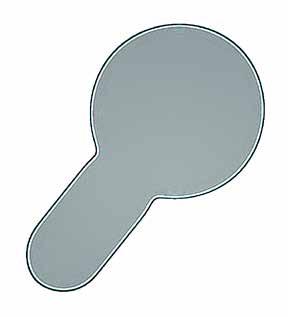
In June 1861, Arthur Eastman of Manchester, NH, offered 5,000 “altered” Hall M 1843 Carbines for sale. He proposed to have their .52 caliber smooth bores rifled with six grooves, and to have the chambers enlarged to accept .58 caliber ammunition. The bores of the guns were not enlarged to .58 caliber, as the description of these carbines in Flayderman’s leads one to believe; only the breechblock’s chamber was enlarged, from a nominal .564-inches to a nominal .590-inches. The theory was that the larger chamber feeding into a substantially smaller barrel would help reduce the gas leak problem that had hampered the Hall design since the very beginning of production.
Eastman successfully arranged to purchase the 5,000 carbines from the U.S. Ordnance Department in May and June 1861, paying $3.50 each and taking them from stores held at the Governor’s Island Arsenal in New York, and from Frankford Arsenal in Philadelphia. Eastman arranged to sell the carbines to a Simon Stevens who agreed to pay Eastman $12.50 each for them in their newly altered, rifled state. Simon proceeded to contact Major General John C. Freemont in Saint Louis, Mo., on 5 August 1861, and offered the carbines for sale to him. His initial letter read:
56 Broadway, New York, August 5, 1861
I have five thousand Hall’s rifled cast-steel carbines, breechloading, new, at twenty-two dollars, government standard, fifty-eight. Can I hear from you?

SIMON STEVENS
Freemont responded the very next day via telegram, saying in part:

“I will take the whole five thousand carbines. See agents, Adams Express, and send by express not fast freight. I will pay all extra charges. Send also ammunition. Devote yourself solely to that business to-day.”



The most scandalous part of the deal was that Eastman did not even obtain the carbines from the Ordnance Department until August 7, 1861. Since Stevens did not have the money necessary to pay Eastman, he arranged financing through JP Morgan. The alteration of the carbines did not take place until later in the month, with most of the work being performed by the WW Marston
Company and the Taunton Locomotive Manufacturing Company. The first of the altered carbines arrived in St. Louis by the end of August with the balance arriving by mid-September. The guns were being issued to the troops in the field by the end of September 1861.
By September 1861, Colonel J.W. Ripley of the Ordnance Department had seen the initial documents relating to the purchase of the carbines at $22.00 each, and immediately realized that these were the same guns he had authorized selling out of inventory at $3.50 each! The story hit the newspapers, and in a very short time a Congressional inquiry was convened. By November 2, 1861, Freemont had been relieved of command. Although his removal has often been seen as the result of this purchasing debacle, in the greater scheme of things his inept leadership and the fact that he ran the Department of the West as his own private fiefdom had much more to do with his loss of command than the arms scandal. This very public embarrassment was certainly one of the final straws that resulted in his removal from command by President Lincoln.
The rifled M1843 carbines were issued to several Western Theater and Trans-Mississippi cavalry units, including the 4th Arkansas, 2nd, 3rd, 9th & 10th Illinois, the 1st Indiana, 4th & 5th Iowa, 2nd & 5th Kansas, 2nd Battalion Militia, 6th Militia, 10th Militia, 2nd, 3rd, 6th, 7th & 10th Missouri, 8th & 9th New York, 3rd & 4th US and 2nd Wisconsin Cavalry. Many altered carbines remained in service through the majority of the war; as such they tend to be encountered in rather rough and heavily used condition. The smoothbore carbines saw use for a more limited amount of time, but like their rifled brethren, a service life of some two decades means that surviving examples tend to be well used and crisp, high condition examples are quite scarce in collections today.
Tim Prince is a full-time dealer in fine and collectible military arms from the Colonial Period through WWII. He operates College Hill Arsenal, a web-based antique arms retail site. A long time collector and researcher. Tim has been a contributing author to two major book projects about Civil War era arms including The English Connection and a book on southern retailer marked and Confederate used shotguns. Tim is also a featured Arms & Militaria appraiser on the PBS Series Antiques Roadshow.

22 Civil War News August 2021 22 Civil War News August 2021 www.CollegeHillArsenal.com Tim Prince College Hill Arsenal PO Box 178204 Nashville, TN 37217 615-972-2418
Hall-North receiver with the breech block closed, showing the side-mounted action operating lever. Note that no Ordnance Officer’s final acceptance cartouche was applied to this carbine, which is not uncommon on these arms. Note the fire blued operating lever that is toning towards straw with age and handling.

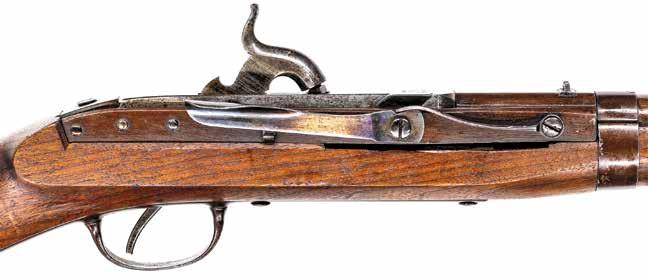




Below right: Rifled bore of one of the “Fremont” Hall carbines. Externally there is no indication of whether a M1843 Hall is in its original smoothbore configuration or if it has been modified. Only examining the bore for rifling and measuring the diameter of the chamber can confirm whether it is a modified gun or not.
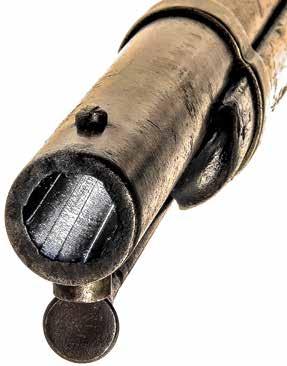

23 August 2021 Civil War News 23 August 2021 Civil War News
Overall reverse view of a Model 1843 Hall-North carbine.
Overall obverse view of a Model 1843 Hall-North carbine. All photos by Tim Prince.
Close up of the standard 1843 Hall-North carbine breechblock markings.
Right: Smooth bore of the 1843 Hall-North carbine showing the guns as originally produced.
Hall M1843 breechblock opened for loading.
Reverse of the receiver showing the sling bar and ring. The inset shows the script NWP cartouche of arsenal sub-inspector Nahum W. Patch.
by George Franks
Falling Waters. The first question is always “which one”? The 1861 Battle of Falling Waters was fought in Virginia, now West Virginia, and is also known as the Battle of Hoke’s Run. The July 14, 1863, Battle of Falling Waters took place in Maryland nearly five miles from Williamsport.
The Battle f Falling Waters 1863 Foundation, Inc., (BOFW1863), is a 501(c)3 nonprofit organization incorporated in Maryland during 2014. Their mission is to save, preserve, and interpret the site of the Gettysburg Campaign’s final battle in Maryland.
Past
BOFW1863F has worked with numerous organizations to save 3.5 acres of prime battlefield land from residential development. The organization partnered with the American Battlefield Trust, American Battlefield Preservation Program, Visit Hagerstown, the town’s convention and visitors bureau, Heart of the Civil War Heritage Area, local officials, and other partner organizations to save the most historic land from further development.
Additionally, the organization has held educational events to commemorate battle anniversaries in 2018 and 2019; due to the global pandemic, there was no 2020 event. These events included battlefield tours, demonstrations, educational displays, logo merchandise, books, and refreshments.
During the 2016–2018 period, the organization worked with the late Edwin C. “Ed” Bearss and other historians, authors, and preservationists to encourage the American Battlefield Trust to purchase an additional 16 acres of pristine battlefield, plus the 1823 Daniel Donnelly House that was the centerpiece of the battle. The Donnelly House can be seen in the famous Edwin Forbes sketch
Saving the July 14, 1863, Falling Waters Battlefield


project is interpretive signage.
of the battle. Unfortunately, the lobbying effort did not come to fruition. The Donnelly House remains in private hands and will remain private property for the foreseeable future.
Current
Three projects have been the focus of the preservation organization’s board, members, supporters, and volunteers over the past two years. The first
BOFW1863F is working with Civil War Trails and Heart of the Civil War Heritage Area to place the first of what will be several interpretive signs on the saved and preserved 3.5 acres of battlefield. The second project is a modest guest parking area adjoining the battlefield’s preserved 3.5 acres. It will accommodate a tour bus and several cars including designated handicapped parking.
BOFW1863F partnered with Heart of the Civil War Heritage Area and Maryland Heritage Areas Authority to help fund this essential project.
The third and current project is an extensive study of the battlefield funded and managed by Preservation Maryland. That organization has led and managed the study of many factors regarding the physical battlefield, potential community impacts and
The handwriting reads: “Gallant charge by two companies of the 6th Michigan on Tuesday morning on the rebel rearguard, near Falling Waters, where part of the rebel army crossed the Potomac. This charge was really a very brilliant and dashing affair. The cavalry numbering not more than fifty or sixty men, charged up a steep hill in the face of a terrific fire, went over the breast works and captured nearly the intire [sic] force of the enemy with two or three regimental battle flags. Our boys were at least two thirds of the men engaged killed and wounded, quite a number of the dead were lying inside the works. This charge deserves an illustration, as it is without exception the most brilliant charge that has been made. July 14th.” Edwin Forbes, artist. Library of Congress.

24 Civil War News August 2021 24 Civil War News August 2021
George Franks leading a tour of Falling Waters.
support, plans, and recommendations. The study’s output will serve in part as a roadmap for future projects.
One goal since the preservation organization’s inception has been to open access to Gen. Robert E. Lee’s pontoon bridge crossing site on the Maryland side of the Potomac River. Currently it is only accessible by walking or cycling nearly five miles down the National Park Service C&O Canal towpath from Williamsport. The end of Falling Waters Road in Maryland is closed; the alternative access is a private fish and game club property. Questions about gaining access are frequent.
Future
Near term, BOFW1863F hopes to host a small commemorative event near the anniversary of the battle in July 2021. Visit our website and Facebook page for updates on the event.

Additionally, we are planning to use technology for virtual and self-guided tours of the entire July 14, 1863, battlefield.

Finally, we plan to expand our educational outreach with tours designed for school age children to augment their study of the American Civil War, Maryland history, and the Gettysburg Campaign.
We have been honored to host tours, including those organized by the Smithsonian Institution, various Civil War authors and historians, including the late Ted Alexander and Ed Bearss, plus local, regional, and national organizations.
To learn more about how you can join or otherwise support the mission of the Battle of Falling Waters 1863 Foundation, visit our Facebook page (Save Falling Waters 1863 Battlefield) or contact us at fallingwatersmd1863@ gmail.com.
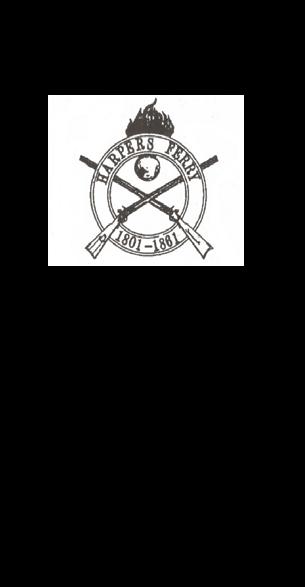
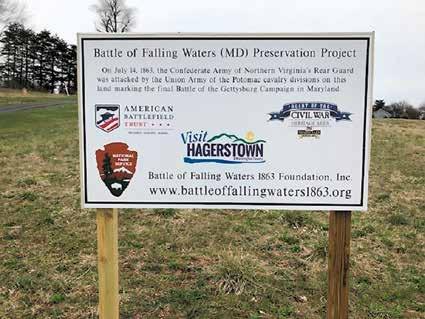
25 August 2021 Civil War News 25 August 2021 Civil War News
Official Records Atlas, Plate 42, Map of Hagerstown, Williamsport, and Falling Waters.
Charge of the 6th Michigan cavalry over the rebel earthworks near Falling Waters. Alfred Waud, artist. Library of Congress.
Battle of Falling Waters 1863 Foundation Preserves Portion of “Retreat from Gettysburg” Battlefield in Maryland.
Union Volunteer Saloon
The Graphic War highlights prints and printmakers from the Civil War discussing their meaning and the print maker or artist’s goals.
The Union Volunteer Saloon in Philadelphia is visually one
of the more dramatic scenes captured by lithographers during the Civil War. Artistically it is centered on the American flagpole proudly waving in the midst of bustling activity below. In fact, the viewer can count six U.S. flags and another banner, possibly the Pennsylvania state flag. As the Library of Congress
describes the scene, Union troops have just disembarked “from ferries in Philadelphia, having been transported across the Delaware River from New Jersey. They march in formation toward the Union Volunteer Refreshment Saloon, located at the southwest corner of Swanson and Washington avenues, cheered
on by Philadelphians, who have lined up to watch.” These fresh faces occupy the left-hand side of the print while on the right side, troops who have been “refreshed,” tramp toward the “cars” of the Philadelphia, Wilmington, and Baltimore Railroad to take them to the front.
Lower right, in their bright, colorful red uniforms, a military band augments the cheering crowd of civilians to its left. The print is another example of the naïve understanding of the horrors of war at an early time, 1861, when most Americans were eager for a quick, decisive war and everyone could go home a hero. In that regard, this print is an excellent piece of documentary evidence of the misplaced enthusiasm for a brutal war no one anticipated. The regiments are in lock step, flags are flying, civilians are cheering as if at a football game, and the band lends a festive air to the entire scene.
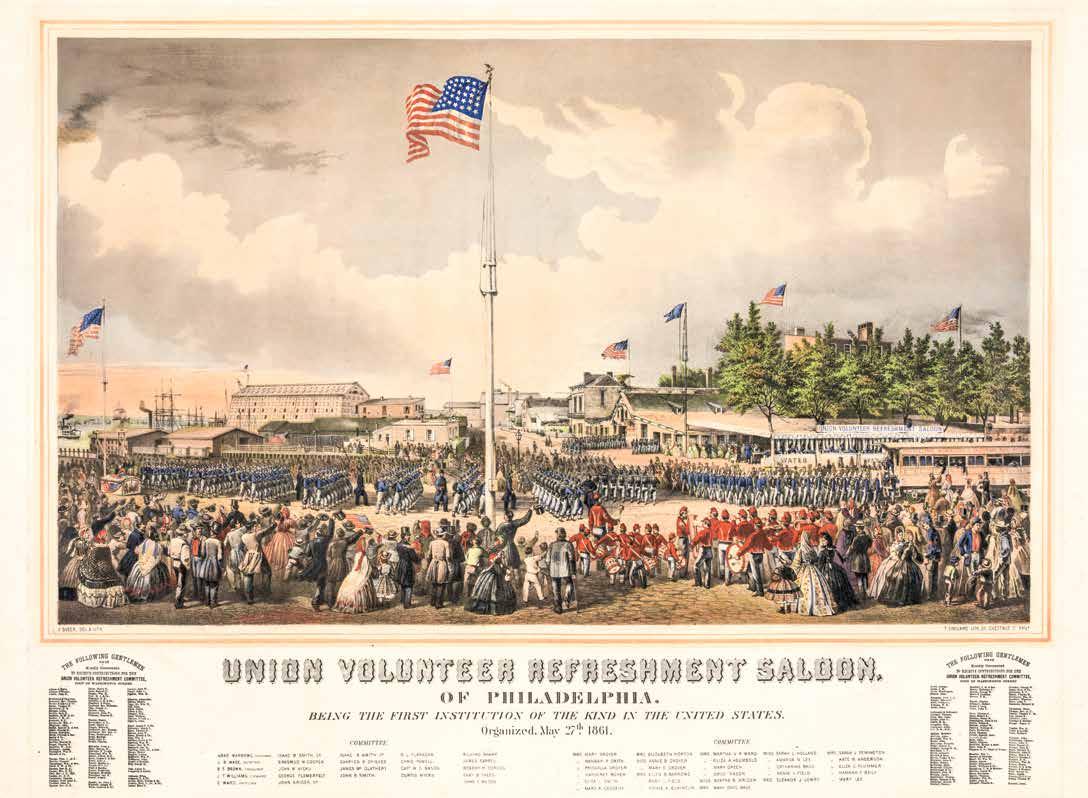
“The slant-roofed building just

behind the train station is the Refreshment Saloon itself, which offered both food and drink (note the ‘water’ sign visible at right). Over the next four years, the saloon—the forerunner of the USO canteens of World War II— served 600,000 meals and provided space for thousands of soldiers to write letters home.”1
The Saloon was the brainchild of the South Philadelphia grocer, Barzilla S. Brown who “began informally distributing food to Union troops traveling through Philadelphia, an important rail and steamer hub.”2 Beyond food and drink, Brown offered stamps and writing materials. No sooner had the war deteriorated into the blood bath it became, than Brown added a hospital for the sick and wounded. Up until that time, the care of casualties fell to the Sanitary Fairs that sprung up throughout the north. “The saloon supported itself through donations of food, clothing, cash, and later through an admission fee to
Print shows Union troops during the American Civil War disembarking from ferries in Philadelphia, having been transported across the Delaware River from New Jersey. They march in formation toward the Union Volunteer Refreshment Saloon, located at the southwest corner of Swanson and Washington avenues, cheered on by Philadelphians, who have lined up to watch. Troops that have eaten, board the “Philadelphia, Wilmington & Baltimore Railroad” to fight in the war. Barzilia S. Brown, a local grocer, organized the Saloon in 1861. Library of Congress.
26 Civil War News August 2021 26 Civil War News August 2021
view the Confederate navy vessel Ram that had been captured in 1863. After providing social and medical services for four years, the saloon closed in late 1865.”3 In the title margin, the artist has included the hundreds of names of committee members and contributors to the cause.
The Library of Congress lists this print as published in May 1861; however another source puts the first publication in 1863, having been “commissioned by the volunteer organization’s Picture Fund Committee” and reprinted throughout the war.4 It was published by the Philadelphia lithographic firm of Thomas Sinclair, whose work print author and expert Harry Peters described having “a certain crisp touch that raises it above many.”5 The print generated “more than $1,100” (about $15,000) today. Artist James Queen’s original drawing was “larger than two square feet,” cost “$75 and showed the ‘true exterior view of the institution,’ as described by the committee for their annual report.” Sinclair printed 1,600 copies averaging 40 cents each. The view was “reprinted four times until August 1865, with a total of 3,500 impressions being taken.”6 Of course, the market for all these prints was the thousands of soldiers and their families who trooped through Philadelphia on
their way to the front.
Philadelphia printer and publisher Peter Duval, who worked on several prints with Queen, called him “one of the best artists in the country. He is very useful to us and we have more work for him than he can do.”7 According to another, “his view of the ‘Union Volunteer Refreshment Saloon’ is one of [his] most complex works and perhaps the one for which he is best known.”8
In 1862, as the war provided Queen with a myriad of subjects, he produced a watercolor of the Citizens Volunteer Hospital in Philadelphia that Duval published. In the center, surrounded by interior vignettes of ten various rooms, Queen depicted another view of the saloon’s exterior. In 1864 he sketched the U.S. Sanitary Fair in Philadelphia.9
Queen enjoyed a long, successful career and, unlike other artists, amassed a comfortable life for himself and his family. He died in 1886 of multiple sclerosis.
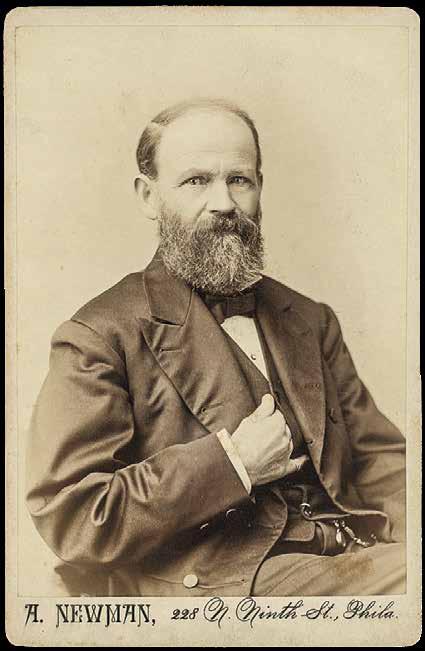
Endnotes:

1. Harold Holzer, Mark E. Neely, Jr. The Union Image: Popular Prints of the Civil War North, Chapel Hill: The University of North Carolina Press, 2000, p. 6.
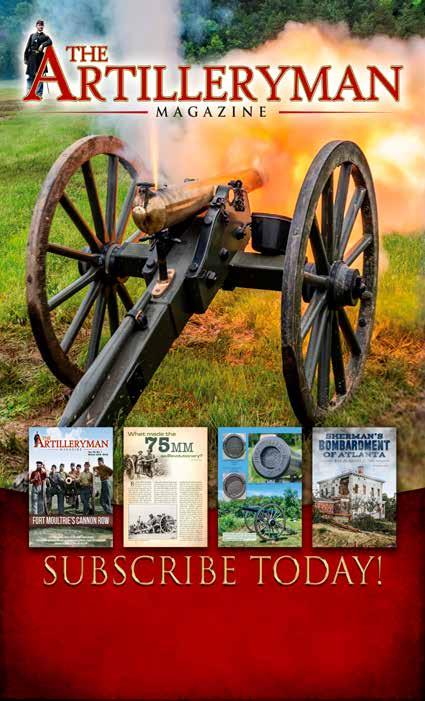
2. Seth Kaller, website product description. https://tinyurl. com/4fz9hvwn
3. Ibid.
4. Erika Piola, ed. Philadelphia on Stone: Commercial Lithography in Philadelphia, 1828–1878. University Park: The Pennsylvania State University Press, 2012, p. 28.
5. Harry Peters. America On Stone: The Other Printmakers to the American People. New York: Doubleday & Co., 1931, p. 369.
6. Piola, p. 28
7. Ibid., p. 90.
8. Kaller.
9. https://www.loc.gov/ item/2012645623.
After 43 years in the museum field, Salvatore Cilella devotes his time collecting American prints and maps and writing. His last professional position was President and CEO of the Atlanta History Center. His most recent books are Upton’s Regulars: A History of the 121st New York Volunteers in the Civil War (U. Press Kansas, 2009). His two-volume Correspondence of Major General Emory Upton, (U. of Tennessee Press, 2017), received the 2017–2018 American Civil War Museum’s Founders Award for outstanding editing of primary source materials. His latest book “Till Death Do Us Part,” an edit of Upton’s letters to his wife 1868–70, was published in 2020 by the Oklahoma University Press.
27 August 2021 Civil War News 27 August 2021 Civil War News
James Queen.
e
520 Folly Road, Suite 25 PMB 379, Charleston, SC 29412 • 800-777-1862 • mail@artillerymanmagazine.com www.ArtillerymanMagazine.com The Artilleryman Magazine FOUR INCREDIBLE ISSUES A YEAR
Artilleryman is a quarterly magazine founded in 1979 for enthusiasts who collect and shoot cannons and mortars primarily from the Revolutionary War, Civil War to World War II. Now expanded and fully illustrated in rich color throughout the entire magazine.
Lawrence County, Missouri, Grist Mills and Distilleries
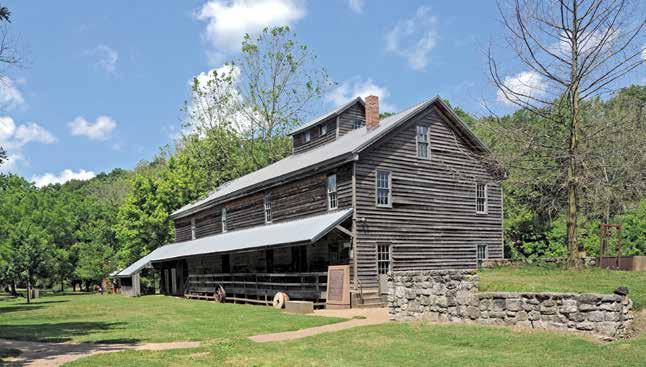 by J. Dale West, P.E.
by J. Dale West, P.E.
Grist mills provided flour and cornmeal, essential commodities to households, prior to the modern era. As Lawrence County was settled beginning in the 1830’s grist mills soon followed along the continuously flowing streams as the growing population could support these commercial enterprises. The flowing water provided the power to turn the mill buhrstones prior to the general availability of steam or internal combustion engines or water turbines.1 Dams were normally constructed to form a pond that released water through a millrace, or canal, thereby increasing the kinetic energy, or head, available to turn the water wheel beyond that of the natural, free-flowing stream. Water-powered mills proliferated along Spring River, Turnback, and their tributaries.
The production of whiskey was a natural, value-added extension of milling grains, and many grist mills included this complementary process. To make whiskey, milled grain is treated and fermented to produce a “beer” that is distilled in multiple steps to purify and concentrate the ethyl alcohol (hereinafter termed alcohol).2 In Missouri and other midwest states including Kentucky and Tennessee, corn meal was the
primary feed material to the fermentation process. Corn and other grains, however, are primarily starches that do not ferment. They must be converted to sugars to produce alcohol by fermentation.
Extensive research has not uncovered a detailed description of the fermentation and distillation steps employed to produce whiskey in the Lawrence County or other distilleries. The author has pieced together the most likely process employed considering the fermentation chemistry and distillation techniques of the mid19th Century period. Information on the reconstruction of George Washington’s distillery at his Mount Vernon, Va., plantation that began operation in 1798 was helpful.3 Illegal moonshine still operations in Appalachia and other locations in more recent years probably crudely approximate the commercial fermentation and distillation steps of 150 years ago.
Conversion of corn starch begins by adding cornmeal to very hot water in a copper cooker vessel that is maintained at an elevated temperature. The high temperature causes the starches to break down into sugars allowing the fermentation reaction to begin.4 With initiation of fermentation by natural yeasts in
Jolly Mill was built by Thomas Isbell and his son John in 1848 to serve as a whiskey distillery on Capps Creek at Jollification, Newton County, Mo. Thomas Isbell and his son John to serve as a whiskey distillery. Jolly Mill was named for the local Jolly family. When the Confederates burned the town in October 1862, the mill was left untouched because they did not want to destroy a source of whiskey. The mill is less than a mile from the Lawrence County line. Courtesy Wikimedia, photographer Keith Snyder.
the environment to produce ethyl alcohol, a co-product, carbon dioxide, is released. Some of the carbon dioxide is dissolved in the mash water as carbonic acid. This acid further promotes the starch conversion. The sour mash fermentation process normally continues for ten or more days until the reaction ceases due to the
Gun Works, Inc.
Where
“Hard-to-Find” becomes easy.
For generations, re-enactors, modern hunters and competitive shooters have looked to the DIXIE GUN WORKS’ catalog for the hardest to find blackpowder items. Our all new 2021 catalog continues the tradition with the world’s largest selection of blackpowder replica arms, accessories, antique parts, muzzleloader hunting and sport shooting equipment.

SERVICE AND
PROFESSIONAL
alcohol killing the yeast or consumption of the sugar.5 Direct firing of the mash kettle is required to maintain the elevated mash temperature throughout the fermentation period. This fermentation product, called beer, contains alcohol in the seven to ten percent by volume range. Cessation of carbon dioxide bubbles from the mash indicates completion of the fermentation process.
DIXIE GUN WORKS, INC.
1412 W. Reelfoot Avenue PO Box 130 Dept. 17 Union City, TN 38281 INFO PHONE: (731) 885-0700 FAX: (731) 885-0440
EMAIL: info@dixiegunworks.com
After fermentation has ended, the beer is transferred to the bottom of a specially designed distillation vessel, also constructed of copper. This single stage still is heated by direct firing to recover the alcohol. Since the alcohol volatility is greater than that of water the overhead distillate vapor is of significantly higher alcohol concentration than in the beer. The vapor exits the still by an overhead pipe to the condenser coil that is cooled by water from the mill pond or stream. The initial condensed distillate is over 40% by volume alcohol but diminishes as the alcohol concentration is depleted in the beer. This initial distillate contains a small amount of highly poisonous methyl alcohol (methanol) and other undesirable components formed in the fermentation reaction.6 This initial whiskey cut is discarded. Distillation continues until the overhead distillate contains only about 10% alcohol by volume indicated by it no longer being flammable.
The still is then cleaned by removing the mash solids and remaining dilute alcohol liquid. Mash solids are fed to cattle and hogs, and the liquid residue is
transferred to the mash cooker vessel for the next fermentation cycle to conserve the residual alcohol. After cleaning, the retained whiskey distillate is charged to the still base and a second batch distillation performed. This removes the mash solids carried over in the first distillation and further concentrates the alcohol. The blended alcohol concentration is about 40% (80 proof) for the final whiskey product. This was the normal product from distilleries of that period. Additional distillation of this whiskey raises the alcohol concentration and the product cost and was not often done.
Site storage of cornmeal, flour, and whiskey products was in oak barrels of varying sizes produced by a local or regional cooper. For whiskey the most common barrel size was about 31 gallons. Whiskey of that era was not aged and treated by storage in charred barrels. The products were sold or bartered at the mill and distillery or were shipped to general mercantile stores and saloons in the local area or beyond.
Cashless bartering at the mill and distillery was common. My grandfather Frank West once related how, as a young boy of eight or nine, his father sent him on horseback to a nearby grist mill and distillery in Breckinridge County, Ky., with shelled corn in two gunny sacks tied together and hung over the horse’s withers. Sometimes he also carried an empty stoneware jug. He returned home with a measure of cornmeal and a gallon or so of whiskey in the jug.
28 Civil War News August 2021 28 Civil War News August 2021
EXPERTISE GUARANTEED ORDER TODAY! STILL
VIEW ITEMS AND ORDER ONLINE! www.dixiegunworks.com Major credit cards accepted FOR ORDERS ONLY (800) 238-6785 $5.00
ONLY
Built in 1771, George Washington’s gristmill (not his distillery) was 32 feet by 46 feet, according to an 1803 insurance document. In 1783, Washington described the mill in one of his letters, “two pair of Stones, one pair of which are French-burr, employed in the merchant business. The Mill house is of Stone, large and commodious, the dwelling house, which is convenient, is within 30 yards of it; and has a garden enclosed adjoining. A Cooper’s Shop is also near, and the whole convenient to tide water.” Library of Congress.
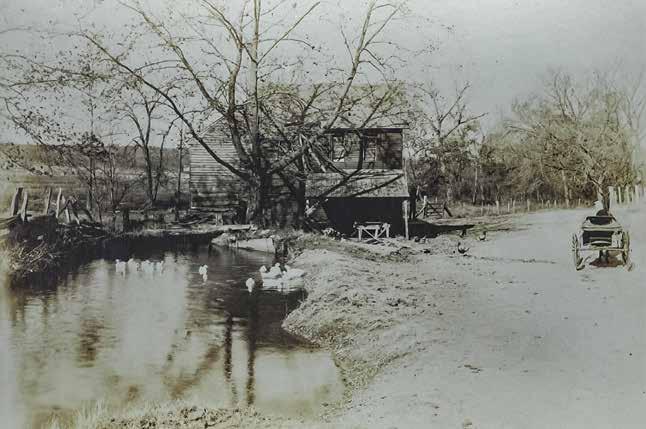
 By Lawrence E. Babits
By Lawrence E. Babits
Civil War
Alphabet Quiz – P as in... August
1. He picked up 8th Infantry colors when Longstreet was WIA at Chapultepec
2. He led CS forces in Oklahoma and wrote Southern words for Dixie
3. “Last land battle of the Civil War”
4. Union artillery forced this brick and masonry fort to surrender in less than two days
5. General who “didn’t know his headquarters from his hindquarters”
6. Ironclad that helped break Union blockade at Charleston

7. He led defense at Shiloh’s “Hornet’s Nest”
8. US cannon designer and manufacturer who operated West Point Foundry.
9. “Farthest west land battle of the Civil War”
10. Key component of portable, floating bridge
Answers found on page 47.
100 Significant Civil War Photographs:

Atlanta Campaign collection of George Barnard’s camera work. Most of the photographs are from Barnard’s time in Atlanta, mid-September to mid-November 1864, during the Federal occupation of the city. With this volume, Stephen Davis advances the scholarly literature of Barnardiana.
Several Lawrence County mills and distilleries were burned during the Civil War. Some were rebuilt after the war; some were not. Additional mills were constructed as the population increased and the economy recovered from the wartime devastation. Beginning about the turn of the new century, improved mechanical milling technology and steam and internal combustion engines made the water-power mills obsolete and increasingly uneconomical. The few remaining water-power mills closed by 1930.
Endnotes:
1. Buhrstone is a siliceous rock used for mill grinding stones. It was commonly quarried in France and imported.
2. Ethyl alcohol is the primary product of natural fermentation reactions. It is also termed ethanol and sometimes methyl carbinol by a less-common nomenclature system.
3. George Washington’s Distillery FAQs (https://www.mountvernon. org/the-estate-gardens/distillery/ ten-facts-about-the-distillery/). The Commonwealth of Virginia purchased the Washington
gristmill and distillery site property in 1932 and reconstructed the gristmill sometime before 1961. Based on extensive archaeological research the distillery reconstruction was completed in 2007 and is currently a working distillery.
4. This is termed a “sour mash” process due to the acidity. Starches comprised of connected six-carbon/oxygen rings split into multiple molecules of six-carbon/oxygen ring sugars.

5. With added yeast, fermentation requires about 3 days.
6. Mostly bitter tasting aldehydes and ketones.
J. Dale West is a fifth-generation native of southwest Missouri and a student of Civil War history of that region. He is the author of Murder And Mayhem: The Civil War In Lawrence County Missouri (2011) and several related articles published by the Lawrence County [Missouri] Historical Society. West holds degrees in Chemical Engineering from Missouri University of Science
+ $3.50 shipping
pages, photographs, maps, bibliography. $19.95 + $3.50 shipping. Softbound. ISBN: 978-1-61850-151-6. www.HistoricalPubs.com.
and Technology and Texas A&M University, served in the U.S. Army Corps of Engineers and was employed by Eastman Chemical Company at Longview, Texas, in development and operations management. Following retirement from Eastman he was an adjunct Professor of Engineering at LeTourneau University, Longview. He is a licensed professional engineer in Texas.
29 August 2021 Civil War News 29 August 2021 Civil War News
Red Mill photographed in 1905. Photo by J.G. Hillhouse. Part of Lawrence County Historical Society’s Hazel Hillhouse Estate Collection.
The American Civil War was the first war in which both sides widely used entrenchments, repeating rifles, ironclad warships, and telegraphed communications. It was also the first American War to be extensively photographed. Mathew Brady, Alexander Gardner and Timothy O’Sullivan are famous for having made iconic photographs in the Civil War’s eastern theater. George N. Barnard deserves to be ranked in this top tier for his photographic A civilian photographer hired by Gen. William T. Sherman’s chief engineer to take pictures of fortifications around Atlanta, Barnard took several hundred of them in and around the city in the fall of 1864. His most famous is the site of Union Maj. Gen. James B. McPherson’s death in the battle of Atlanta, July 22, Thus far, no comprehensive, definitive listing has been made of the photographer’s work. The Library of Congress has 130 images; the U. S. Military Academy at West Point, New York, has at least 98 photographs, donated by Captain Poe’s widow. Other repositories, such as the Gilder Lehrman Institute of American History in New York City, have smaller collections. For this book we have chosen hundred images we deem “significant,” though other students may wonder at some of our selections. We hope that this work will stimulate further interest in Barnardiana, and that other scholarly volumes are yet to come. The Atlanta Campaign STEPHEN DAVIS 100 SIGNIFICANT CIVIL WAR PHOTOGRAPHS ATLANTA CAMPAIGN $19.95
128
Order online at www.HistoricalPubs.com or call 800-777-1862
The Return Of The Tuscarora: Company D, 132nd New York Infantry And The Civil War In Eastern North Carolina
by Donald Collins
In March 2013, 140 Tuscarora Indians traveled from their reservation near Niagara Falls, New York, to eastern North Carolina, the land from which their ancestors had been exiled 300 years earlier. The Civil War gave a number of their descendants a different opportunity to return to their former homeland 150 years earlier. In 1711, the tribe initiated a war in retaliation for the loss of lands and sale of tribal members into slavery. That war ended in capture, enslavement, and forced removal from their traditional home in North Carolina to New York, where they became the sixth nation of the Iroquois Confederacy, along with the Seneca, Mohawk, Oneida, Onondaga, and Cayuga. Tuscarora memory runs deep, even today the exiled tribe regards North Carolina as its true “home.”
Their return would not be easy. During their lifetime, or those of their parents, the Tuscarora and their Iroquois relatives had experienced more forced removals by the Federal government and discrimination by state government
and the public. In 1861, when the Civil War began, New York, unlike neighboring Pennsylvania, forbade military service by Native Americans. The Iroquois Confederation in New York had to fight for the right to serve.
Much of the success in their campaign to gain acceptance for military service was due to Cornelius Cusick and, to a lesser extent, Isaac Newton Parker, both leading members of Iroquois tribes; Parker was Seneca, and Cusick, a Tuscarora. Parker would serve in Cusick’s company as a third sergeant and color bearer. His brother Ely gained more fame as a brevet brigadier general on the staff of Ulysses S. Grant. Ely was present at Appomattox Court House; he wrote the surrender document signed by Confederate General Robert E. Lee.
Cornelius Cusick was a sachem, or chief, of the Tuscarora tribe. He and his family were among the tribe’s educated, intellectual, and military elite. His grandfather Nichol Cusick had served as a bodyguard and interpreter for General Marquis de Lafayette during the American Revolution;
an uncle, David Cusick was author of Sketches of Ancient History of the Six Nations, published in 1828. Following the Civil War, Cornelius would serve as a captain fighting against Indians in the West. For that he would be denied burial on the Tuscarora reservation. An educated man who spoke eight Indian languages, he was appointed special assistant in the Department of American Archaeology and Ethnology at the Columbian Exposition in Chicago.
Although his Civil War service was as a first lieutenant of Company D, 132nd New York Infantry, he was at times referred to as its actual leader because of his recruitment activities and leadership. Because of this, Company D was often called the Tuscarora Company, and occasionally as Cusick’s Company.1
Despite its reputation as an Indian company, Native Americans were in fact a minority within the unit. In addition to 25 men from the Iroquois reservations of western New York, it included native-born Americans and naturalized citizens of German birth recruited
Capt. Cornelius C. Cusick (1835–1904), was promoted after the Civil War while serving as an Regular Army officer under Gen. Nelson Miles. As 1st Lt. of Co. D, 132nd New York State Volunteer Infantry during the Civil War, he was leader of the “Tuscarora Company.”

at Buffalo, Brooklyn, Lewiston, Manhattan, and Syracuse. After receiving assurances of a $25 bounty, a $2 premium, and a month’s pay of $13 for enlisting, the 25 Indians of Company D, and their regiment, were sent to Camp Scrogg in New York City where they received training during the summer of 1862.
“Battle of Bachelor’s Creek NC. Fought Feb. 1st 1864. On Spot’s Farm. Drawn by Cornelius C. Cusick (Indian Lieut Co. D 132nd Regt. NY Infantry). Description written by Hitchcock in his scrapbook:

“The above battle was fought by the 132d Regiment of New York Infantry 700 men. 1 Company 99 NY 65 men. A Company of the 1st North Carolina Union troops 40 men. A squadron of 12 NY Cavalry. 120 men with two howitzers and a section of the 3d NY Artillery 20 men. Commanded by Lieut Col and Brevet Brig Genl Geo. H. Hitchcock.
The Confederates made an assault on our out posts 15,000 strong under Gen. Picket at 2 o’clock AM Feby 1st 64 and were held in check until 11 o’clock AM. a sufficient time to make the woods any disposition of our forces to repel him at every point. Our loss was 84 all told. That of the Confederates being 1500 in killed, wounded, and captured including Col Shaw of North Carolina and Major Rhett of South Carolina. The 132d NY were ordered to place the name of the battled on its colors.” Collections of East Carolina University.
On Sept. 28, 1862, the 132nd NY Infantry was sent to Washington, D.C., where it was mustered into service for three years. Sent to Camp Hoffman, in Suffolk, Va., they constructed defensive works, conducted reconnaissance, and did outpost duty during October 1862. The regiment saw limited action at Zuni, where it was in reserve; at Franklin, and on an over-night reconnaissance to the Blackwater River.2 Despite the minor role played in those engagements, the Tuscarora took pride in their first armed contacts with the enemy. John Titus, an Indian member of the Tuscarora Company, wrote “I hope [we] will take another good fight before the month [is] up. I’ll fight the Rebels as long as I live
In late December 1862, the regiment marched 55 miles to the Chowan River and boarded transports for New Bern, a North Carolina town captured by General Ambrose Burnside in March 1862. Ironically, the Iroquois soldiers now found themselves in the precise area
from which the Tuscarora had been exiled 150 years earlier. A nearby settlement west of New Bern was even named Tuscarora. Service in New Bern had a pleasant side. The camp included a bowling alley and theater, and military activities were occasionally broken up by parties and other entertainment. Whiskey rations, referred to as an “army gallon,” were dispensed to the troops.4
Until the final months of the war, much of eastern North Carolina remained contested territory where the countryside was effectively controlled by neither Federal nor Confederate forces. As a result, the 132nd was called upon to participate in reconnaissance missions deep into the contested zone. Years later, in 1896, Colonel P.J. Claassen recalled one such mission. Although he failed to disclose the location or date of the incident, it is evident that it took place during the regiment’s sojourn in New Bern.
The 132nd, accompanied by a detachment of cavalry, was ordered to march and cross a certain creek. Upon arrival at the stream, they found it swollen by heavy rains, and a masked Confederate battery on the opposite side made it impossible improvise a bridge by felling trees without receiving unacceptable casualties. Claassen ordered Lt. Cusick to send out an Indian scout, known only as “Big Ike, who was known as a “famous
30 Civil War News August 2021 30 Civil War News August 2021
. . . .”3
shot.” With his telescopic rifle, Ike picked off every man who showed himself until the Rebel force was so depleted they could not man their guns. This “unusual slaughter of brave foes,” enabled the 132nd to cross and continue their reconnaissance.5 An unsubstantiated rumor of scalping appeared soon after completing the expedition.
Portions of a letter from a Union officer in New Bern appeared in the June 1863 New York Church Journal. Included was the statement, “There are two companies of Indians in Colonel [Peter J.] Claassen’s Regiment, and every Rebel they caught yesterday was killed and scalped, and it served the devils right.” The colonel angrily denied the allegation in a letter to the Journal, and demanded that the writer be sought out and punished. No further action appears to have been taken, and the affair quietly disappeared.6
The
Bachelor’s Creek Outpost:
The comforts of New Bern’s camp life were replaced in May 1863 by transfer to outpost duty eight miles west along Bachelor’s Creek, the western-most defensive line of the Federal occupation force. Beyond the creek was a no man’s land where elements of both opposing armies operated freely. Until then, the outpost between Union-occupied New Bern and Confederate-held Kinston some thirty miles farther west had been performed by the 58th Pennsylvania Volunteer Infantry Regiment under Colonel John Richter Jones.
Shifting the 132nd to outpost duty was the result of a successful May 22nd raid on a Southern outpost at Gum Swamp, a few miles

east of Kinston. Jones’ poorly conducted return to New Bern cost him his life. A Confederate force under General Daniel H. Hill followed and caught the Federals unaware of any pursuit at the Neuse Road Bridge. While rallying his men, Jones was shot through the heart by a Southern rifleman. On May 23rd, the 132nd, with a battery of the 3rd New York Artillery and a 3rd New York Cavalry squadron, was ordered to support the 58th Pennsylvania.
The Tuscarora Company, along with Company I and a half-section of artillery, was ordered to keep communications with New Bern open while the remainder of the relief force continued to the Neuse Road Bridge. Before Claassen and the 132nd reached them, the 58th Penn. Inf. retreated but were ordered back to the bridge.
When within easy supporting distance of the 58th, Claassen encamped for the night, but on receiving information of enemy movements, companies C and G were ordered to the bridge crossing. Arriving at one a.m., the two companies occupied rifle pits guarding the bridge, but found nothing of interest. Next morning, 16 men reconnoitered beyond the creek for three miles and learned the Rebels had withdrawn and took three prisoners. During the return march to Bachelor’s Creek, news reached Claassen that Colonel Jones had been killed. This placed him in command.7 The 132nd New York was then ordered to replace the 58th Pennsylvania on the Bachelor’s Creek line.
The New Yorkers arrived on May 26, 1863. As the westernmost defensive line for Union New Bern, the 132nd was to keep
artillery can’t come in, and hard for infantry to penetrate in so on the whole we are right well fortified by the country itself.”
Although not mentioned by Parker, the most formidable obstacle to attackers was Bachelor’s Creek itself, which is why it formed the base line for the outer Federal defenses. According to one 132nd soldier, the creek “is a narrow, marshy bordered and some places impassable little stream . . .. For one party or the other to cross in small bodies is most certain capture or death. Along the outer banks of the creek our pickets are posted.”9
Terry’s Brigades, were ordered to advance through Pollocksville south of the Trent River, interdict communications with Beaufort, and construct batteries along the Neuse River below its junction with the Trent. Pickett himself joined the six thousand-man center column, under the immediate command of General Robert Hoke, that would move directly east between the two rivers toward New Bern. The only thing that stood between the Confederates capturing New Bern was the thinly stretched line of the 132nd New York Infantry along Bachelor’s Creek.12
an eye on any Confederate activity that might threaten the town, a duty they kept up for the next two years. Picket, reconnaissance, and scouting became the primary duties of the New York regiment. Another duty involved intercepting Confederate deserters and retrieving their families.
On one occasion, the Tuscarora Company took part in an expedition to nearby Trenton and retrieved four families of Southern deserters. These men often enlisted in the First and Second North Carolina Union regiments.
In December 1863, Company F, Second NC (Union) joined the 132nd on picket duty at Beech Grove, the northernmost post on the Bachelor’s Creek line.
Sergeant Isaac Newton “Newt” Parker, a Seneca Indian in the Tuscarora Company, described the outpost in an August 15, 1863, letter to his sister-in-law:
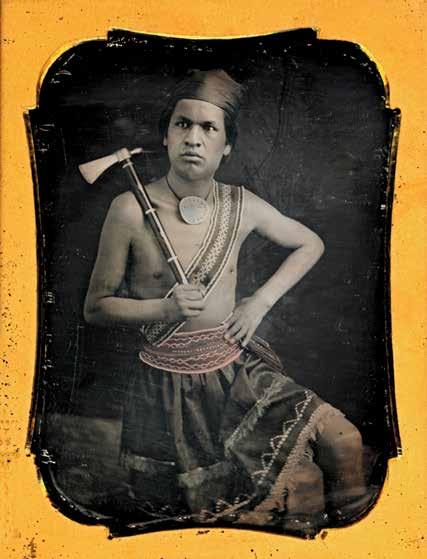
“We hold a front here of nigh seven miles running at right angles to the R. R. and the R. R. being the center of our line. Then there are three miles upon each flank that are picketed by cavalry. But in the two recent expeditions from here, the cavalry were drawn off and then we picketed those six miles, making nigh 13 miles of front and me, not having now 600 effective men . . ..”8
Parker, in the same letter, expressed confidence that the nature of the land made an attack by the enemy on the outpost difficult, if not nearly impossible.
“We are considered bold by holding so large a front — and lively will be the time whenever we will be attacked, but that is rather doubtful, for it is difficult of access to our camp or fort, being much surrounded by swamps and heavy pine wood lands for miles around, so much so that heavy
This feeling, plus “eight months of uninterrupted quiet . . . , lulled the department into a full-spirit of security.”10 There was little reason to expect any assault on New Bern, an attack that came early on January 31, after “our usual scouting party had returned with the information: no enemy, and we all had laid ourselves down to sleep,” only to be awakened “when on the air [came] the boom of cannon and cracking.”11 What the letter-writer heard was the opening salvo of the Battle of Bachelor’s Creek and the commencement of a full-scale attack on New Bern by an army of fifteen thousand men under General George Pickett.
Pickett’s plan to retake New Bern called for a three-pronged attack. Colonel James Dearing’s Brigade was ordered to move on Fort Anderson across the Neuse from New Bern; while General Seth Barton, with Ransom’s and
To maintain the element of surprise, Hoke’s column camped without fires two miles from Bachelor’s Creek. At one o’clock a.m. the Southerners awakened and began moving along the

31 August 2021 Civil War News 31 August 2021 Civil War News
Beech Grove blockhouse.
Isaac Newton Parker, Sgt. 132nd NY.
Isaac Newton Parker after war.
Neuse Road toward Bachelor’s Creek, which, if crossed successfully, would put them at New Bern before sunrise. At 2:30 a.m., the first 132nd New York pickets were quietly taken. Pickets at a third outpost, however, opened fire and escaped over the bridge in time to warn the tiny nine-man reserve post stationed there. The warning enabled them to remove seventy-five feet of bridge flooring, already loosely placed to slow any crossing.13
The small Federal outpost under Lieut. Abram Haring consisted of a blockhouse with breastworks on both sides of the road where it crossed the bridge. Aiding the Union garrison was a drizzling rain, darkness, and later a dense morning fog that kept Hoke ignorant of the number of men holding the bridge. Initially, the Confederates attempted to charge across the floorless bridge three times, each attack being repulsed by Haring’s men. A number of Hoke’s men, wounded on the bridge, were seen falling into the creek. Failing to move his men over the bridge, Hoke placed more men along the creek to keep up a steady fire on the defenders.14
The situation remained static for an hour and a half. Captain Charles G. Smith, the regiment’s officer of the day, was sent by Claassen to learn the situation.
Smith noted the Confederates were “yelling like devils,” and, “feeling conscious of their strength, had advanced to the edge of the creek in considerable numbers, in front and on the right, and were trying to hit wherever they saw a head or heard a noise.” The rebel fire was severe, and four Napoleons added their shell and canister. The four 12pdrs had the range but generally fired too high.15 Federal sharpshooters, firing from the blockhouse, forced the rebel artillery to move several times.
As Haring’s men fired their last ammunition, Company D arrived. They immediately “took position at the breastworks and deployed along the creek to the left, firing with great spirit, holding the enemy in check, and apparently doing considerable execution, as the rebel fire slackened for a few minutes.” The North Carolina Times, the Union army’s New Bern newspaper, stressed the role Native Americans played in relating details of the fight. “The company numbers in its ranks thirty Indians of the Tuscarora tribe, with Lt. Cusick, himself a chief of the Tuscaroras.” “The native impetuosity of the red man, in all it’s wouted [sic] violence burst forth, in well nigh uncontrollable fury. Onward they pressed amid a deluge of bullets
… gallant [company commander Thomas B.] Green urging [them] . . . on with dauntless bravery, twice were they driven back by the surging columns of the enemy and twice did they advance again to the attack. As if impelled by super human energy they charged upon the rebel ranks, and again were compelled to retire, the voice of Green ringing loud above the clash of battle in appeals to his men with undiminished courage and heroism.”16
The Tuscarora Company was followed by companies E and G, under Capt. Peter S. Geraty and First Lieut. Joseph A. Gearing. Their men were immediately deployed across the road and to the right of the bridge. At 5 a.m., Major John B. Honstain was sent by Claassen to assume command. The Federals were suffering heavy losses. Lieut. William Ryan of Company G fell seriously wounded attempting to “dislodge an enemy body from an advantageous point the enemy had gained.” Lieut. Gearing received a serious wound on the side of his face fracturing his jaw. Around nine a.m., Lieut. Arnold Zenetti was killed, shot in the forehead while passing out ammunition.17
By this time, the bridge defenders had frustrated the move toward New Bern for six hours. The delay came to an end when the General Hoke sent his men across the creek using fallen trees as make-shift bridges. Two regiments under Colonel John T. Mercer of the 21st Georgia crossed the stream and moved against the Federal flank and rear, while Hoke repaired the bridge under fire and then sent the remainder of his command across.18
These moves were accomplished by nine a.m. Hoke then moved his men down the road and along the railroad tracks. With Confederates pressing on three sides, Claassen ordered a general retreat. He ordered the outpost burned, including both military and personal possessions. Claassen himself remained until he saw Confederate bayonets in the woods.19
The battle and retreat from Bachelor’s Creek cost the outpost defenders heavily: 326 killed, wounded, or captured. Companies C, D, and G, which had carried the brunt of the battle at the Neuse Road Bridge suffered two killed, three wounded, and thirty-two missing. When the 132nd New York reassembled behind the New Bern breastworks, the Tuscarora Company had lost five men at the bridge and during the retreat. All would die as prisoners of war. The defense at the bridge had delayed Pickett and Hoke by six hours.
The Confederates waited outside New Bern until February 4 then withdrew without taking the town. In all likelihood, the failure to take New Bern was the six hours lost by the 132nd’s defense at the Neuse Road Bridge. But for that, the Confederates would have surprised the Union forces, giving them little time in which to ready their defense against the superior Confederate numbers.
Mine Disaster, May 26, 1864:
The 132nd returned to outpost duty at Bachelor’s Creek on February 5, 1864, where it experienced a temporary rest period. The calm was broken by an accidental explosion that brought more casualties in a split second than the regiment experienced during any single combat action. On May 29, 1864, Lieut. and Tuscarora chief Cornelius Cusick wrote the Niagara County Intelligencer of an accident in which “35 [men] were instantly killed and 32 mortally injured.”
The incident Cusick described took place on May 26, when the four p.m. military train from New Bern rolled up to the Bachelor’s Creek outpost adjacent to the 132nd New York’s camp. The platform was crowded with Negro contrabands and soldiers from the 132nd, 12th New York Cavalry, and 158th New York. Some were waiting to unload the train and others to hear news from the outside world. All were ignorant of the fact that four wooden barrels, each filled with 250 pounds of powder, were on board. They were the last of thirteen torpedoes, or mines, sent from New Bern to be placed in the Neuse River for protection against a Confederate ironclad known to be under construction in Kinston.
When the train arrived, a Lieutenant Jones, commander of the unloading detail, failed to inform his men of the barrels’ contents, and carelessly left them unguarded. The regimental quartermaster-sergeant assumed the barrels were supplies and ordered them removed from the train. He personally rolled the first one safely onto the platform. When the second was unloaded, a trigger was tripped detonating the four torpedoes almost simultaneously. The concussion was heard 20 miles away in Kinston.20
In that instant, the commissary building, the one hundred feet long loading platform, and a ninety feet tall signal tower were blown into splinters. The train was covered with “blood and gore,” but otherwise undamaged. “Heads, bodies, and limbs were
scattered for a quarter of a mile around, and in many instances it was found impossible to recognize the remains of the victims.”
Many of those killed were so mutilated and dismembered as to be “unrecognizable to their dearest friends.” The quartermaster sergeant who unloaded the first barrel was identified by a ring on his dismembered arm. Forty wounded were taken to New Bern on a platform car covered with straw.21
Estimates of the dead and wounded varied. Some were listed simply as missing, as their remains were unidentifiable. The 132nd New York suffered the most. Lt. Cusick reported 35 killed instantly and 32 mortally injured; the New Bern paper estimated 40 killed and 17 wounded. Casualties were also suffered by the 158th New York Infantry, the 12th New York Cavalry, and the Second North Carolina (white) Union Infantry. In addition to military deaths, 20 to 25 contrabands were estimated to have been among the dead and wounded. These figures do not include those that later died of their wounds.22
The Fight At Jackson’s Mills, July 1864
On June 20, Claassen received orders to move with a portion of his command against Confederates outposts at Jackson’s Mills and Wyse’s Forks, outside Kinston. If the outposts were taken, they were to move on the rebel town itself and destroy the ironclad CSS Neuse being completed. For the expedition, he selected men from the132nd NY, the 15th Conn., two batteries with four 3-inch guns from the 3rd NY Artillery, and two companies from the 12th NY Cavalry, a total of approximately 900 men.
Claassen’s tactics called for a three-pronged attack. The Tuscarora and two other companies (I and K) of the 132nd, under Capt. Thomas Green, were to move early and take back-roads to avoid detection. They were to take the Confederate outpost at Jackson’s Mills where a bridge crossed Southwest Creek. This attack was expected to cut off any retreat when the main column under Claassen attacked Wyse’s Forks via the Dover Road, and another column attacked along the Neuse Road. All three columns were to attack at precisely ten p.m. on June 21, 1864. The largest force was devoted to the works at Wise’s Forks, as it was believed to be the stronger objective. Once reunited, the three Union units would determine the feasibility of moving on to take
Kinston.
The plan to take Wyse’s Forks and Jackson’s Mills worked to perfection. On June 20, at five p.m., Capt. Green left the Bachelor’s Creek camp guided by a local Unionist who took them via back-roads and swamps to a point near Jackson’s Mill where they hid until the attack. Cusick, the highly literate Tuscaroran, described this tortuous aspect of the affair in great detail in an August 16, 1896, article for the Albany (NY) Argus:23
“The march to this point was a most laborious one—being over tortuous by-paths, through thick jungles, interlaced with brier-wood vines, and frequently having to wade waist-deep through many swamps, the water of which was covered with green and black sticky scum, and infested by snakes and other poisonous reptiles...”
Reaching the point from where the objective would be assaulted, Green’s column remained hidden in a cornfield to await the designated hour.
The other two columns waited until five a.m., June 21, to leave Bachelor’s Creek since their march took more direct roads to Wyse’s Fork. Both met unexpectedly light resistance. Claassen first encountered Rebel pickets on the Dover Road 14 miles from Kinston, while Hitchcock met them nine miles out along the Neuse road. The attacks on the pickets began at precisely ten o’clock p.m. as previously arranged and a running skirmish took place. On the Neuse Road, rebel cavalry withdrew in front of Hitchcock’s men. Succeeding posts were taken with little difficulty, causing little delay in moving toward the main target at Wyse’s Fork. On the Dover Road, when Claassen attacked the works at Wise’s Forks, the enemy broke and fled in such haste they left behind muskets and meal “to be destroyed or gobbled up by the audacious Yankees.”24
Two hours before the main column attacked Wyse’s Fork, Green struck at Jackson’s Mills. Cusick described the event in his Albany Argus article:
A flanking position having been taken, the captain (Green) awaited signal shots from the main center column, which had been designed to attack the enemy’s outpost camp. Hearing none, and the hour for his continued march in the direction of the… the cornfield was left. . . . . .
After a march of half an hour, the column found itself within 200 yards from the Mills, where it was halted, Captain Green, in an undertone, his voice just above a whisper, said, “Corneal,”
32 Civil War News August 2021 32 Civil War News August 2021
meaning Lieutenant Cusick, “you continue in full charge of our company, as you have been during the day; proceed with it as vanguard about 50 yards in advance of the other two companies; fix bayonets; advance quickly, but quietly; if challenged, halt, and reply, ‘friends!’” threaten the sentinel with instant death if he gives an alarm, or makes any noise.
A few moment’s (sic) march brought the vanguard … [to] a soldier … nearly 200 yards from the main guard, which occupied works 100 yards beyond the mills. The sentinel was approached…the instructions of Captain Green were fully, successfully and happily carried out. Capt. Green’s flanking column completely surprised the main guard at Jackson’s Mills … not a shot was fired, all quietly and peaceably surrendered.
The works found were in the character of entrenchments and rifle-pits and were speedily manned … the Tuscarora or Iroquois company under Lt. Cusick posted several yards in the rear of the works and in the direction of Kinston. Shortly after these dispositions were made a mounted courier came dashing along from Kinston. The company stationed on the roadside in the rear of the works permitted him to approach and quietly gathered him in, horse, bag, countersign and letter of instructions, etc. He was a bearer of a dispatch from Gen. Foulk [sic Colonel Nathaniel Folk, 65th Inf., NC State Troops], commanding forces and defenses of Kinston …The letter captured contained instructions to withdraw at once from the outpost and occupy the intrenchments at Jackson’s Mills, and that the enemy was approaching his outpost in force, by road to his camp and by roads to the right and left of it. A half-hour passed, when another courier bearing similar message to the first, was also taken prisoner. Gen. Foulk, not hearing from Major Scann, concluded something was wrong at the [Wyse’s Forks] outpost. In this he was mistaken, as the whole trouble was at Jackson’s Mills… at the very gate and door of the inner defenses of Kinston.
Still another half hour passed, when the commanding officer himself, with his post adjutant-general, came riding furiously down from headquarters at Kinston to learn what had become of his couriers. They were permitted to approach the Tuscarora company within five yards, when its commander, in a clear and steady voice, commanded, “Halt!” dismount and surrender!” The general was angered that he
should be thus delayed and answered back, “Men, I am General Foulk. You all know me.”
“Yes, we all know you, and the second time I order you to dismount and surrender.” By this time the general and his aid [sic aide] were well surrounded by the dusky soldiers. He was greatly mortified when he realized his delicate plight and instantly dismounted from his horse, followed by his adjutant. To the second challenge, “Do you surrender?” he answered, “Certainly I do; this is a bad box; there is no help for it. I am your prisoner — I only wish this was your experience instead of mine.” He then offered his side arms to the lieutenant, with whom he had the parley — the writer [Cornelius Cusick] — who declined to receive them, but at the same time said, “Captain T. B. Green, who is in command, will receive them instead of me.”
The captain promptly appeared and received the side arms
At 10:40 p.m. came the distinct report of musketry in the direction of the Confederate outpost at Wise’s [sic Wyse] Forks. First, a single shot, quickly followed by another — evidently alarm shots from a sentinel. Only a minute’s time intervened when a perfect fusillade of musketry was heard.
Col. Claassen had reached and surprised the rebel outpost, it being only two miles away from Jackson’s Mills. A moment later the sound of horse hoofs could be heard — then faint yells from the throats of Union infantry and cavalry. It was deep-toned, quite unlike the shrill rebel sound. Five minutes later rapid firing ceased and became desultory.
The pounding and clatter of horse hoofs; the deep rumbling of wagons in flight toward Jackson’s Mills, both in concert became louder and louder than ever; soon curses and cracks of whip lashes became decidedly distinct, indicating and attesting the work of Claassen as being fully accomplished — and in a sweeping and resistless manner, for the enemy was in full flight and only to reach a point where death, captivity and wounds awaited them, for Captain Green and his devoted little band were in possession of the intrenchments [sic] at Jackson’s Mills.
At 11:30 p.m., the retreating rebels fleeing by the Jackson’s Mills Road were first sighted in the shape of a baggage wagon, that came rumbling down to the bridge in charge of a Lieutenant Brothers, of the Sixty-seventh N.C. regiment. The lieutenant, outstripping the lightest and headmost wagon in his eager flight, on reaching and discovering the dismantled bridge, became wild
with rage, and burst out with curses. He yelled and bawled out to some person he faintly saw on the opposite of the stream, a hundred yards away, “Who ordered that bridge up?” The “some person” on the other side answered that he ordered it up to stop the infernal Yankees from crossing, adding: “But, come over, and if you want to get the wagons across, we will put the planking down.” Over comes the lieutenant on one of the stringers, cursing at the same time incessantly at the stupid fool who ordered up that bridge. He was no sooner across than a revolver was pointed into his face, and he was commanded to surrender instantly. The lieutenant was badly frightened as well as astonished. As he gave up his arms he remarked: “No one but a Yankee could play me such a clever trick as that.” Following this brief episode came the arrival of the retreating Confederate infantry. It was properly challenged and a prompt answer given by the officer in command. He little expected that the challenge was made by an adversary, and that the position was under Federal occupation. He was requested in a low and meek tone of voice to cross the creek by the stringer of the dismantled bridge, and form his command on the immediate grounds as the men crossed over. Captain Green, in a loud, sharp and distinct tone of voice, demanded the instant surrender of the Confederate command. The situation was still not understood by the Confederate commander, as he replied by giving his rank and name, and said that the Yankees were approaching rapidly, and would be here “right, smart, soon.” Another demand was made by Captain Green for the surrender, supplementing the demand this time with these words, “and damn quick at that.” The reply given was, “To whom?” Captain Green promptly answered, “To Federal troops of the One Hundred and Thirty-second New York.” The last and only words expressed by the Confederate commander were, “Surrender yourselves you __ Yankee sons of __.” These words were instantly followed by the clicking of musket triggers of the Confederates, and following quickly, the firing of a volley at the men in the intrenchments (sic). The fire was aimed too high, for not a man was hit. Captain Green and his officers simultaneously and as one voice ordered, “Fire, and fire low!” It was instantly obeyed, and one volley fired from ninety Belgium muskets accomplished its work — it was a bloody execution, … After the volley was fired not a
man could be seen standing, and it was followed by heart-rending moans and groans of the dying and wounded enemy. The road was actually blockaded by them.
In less than two hours time five officers and forty-one non-commissioned officers and privates fell into Captain Green’s hands. His [Green’s] position was at last discovered by the enemy and his capture of General Foulk was found out. He fought hard to defend his breastworks and keep well secured his prisoners. Shortly after midnight a troop of the Sixth N. C. cavalary [sic] made a desperate attempt to rescue their general. The troop made a furious and reckless charge, but was speedily repulsed, leaving behind it nine killed, including two officers and fourteen wounded. Among the killed was the young and brave Lieutenant De Hart who led the charge, and refused when commanded (by Lieutenant Cusick, the writer) to surrender. In less than two hours, Green’s three companies had the outpost at Jackson’s Mills fully under control. During that time, they had killed or wounded twenty to twenty-five of the enemy, captured five officers, including the commander of Kinston, fifty-one enlisted men, forty horses and mules, and a wagon-train loaded with commissary stores, officers’ private baggage, arms, ammunition, etc. All the while losing only one killed and one wounded. The outcome of this affair was still unknown to the main body at Wyse’s Forks. Claassen became aware of the fact when he joined eight companies of his own men who had advanced to within three quarters of a mile of Southwest Creek.
With Wyse’s Forks and Jackson’s Mills safely in hand, Claassen’s next move was to determine the practicality of attacking Kinston. A reconnaissance found the road to Kinston strongly fortified and garrisoned by infantry, cavalry, and twelve pieces of field artillery. Claassen determined his force was too small to attack Kinston after scouts reported the Confederate position was too strong. As a result, he ordered Jackson’s Mills evacuated and all bridges destroyed. By dawn, the expedition returned to Bachelor’s Creek with a loss of
only one killed, no wounded, and three missing. They had marched and fought from 5 a.m. June 21, till 5 a.m. June 23, 1864, having covered a distance of sixty-five miles.
Expedition To Kinston, December 1864:
The several months following the return from Kinston were relatively uneventful, with the regiment occupied mainly in picket and scouting duty. Camp routine was broken in December by another expedition to Jackson’s Mills and Kinston. On Dec. 9, 1864, orders were issued for an advance on Kinston to feel out the enemy, and if possible, capture the town. The expedition was composed of the 132nd NY Inf., the 12th NY Cav., the 15th Conn. Inf., and detachments of the 5th RI and 2nd Mass. Heavy Arty., under command of Colonel Charles L. Upham of the Connecticut regiment.25
The 132nd and 12th moved out for Core Creek, where they rendezvoused with the 15th Connecticut, and the Rhode Island and Massachusetts heavy artillery. Weather hampered the expedition from the very beginning. Once the 15th Conn. Inf. and the RI artillery arrived at the rendezvous, the weather caused another day’s delay. This provided time for the enemy to prepare for the attack.26
The next morning, Sunday, Dec. 11, it was still raining, but the command marched at 8 o’clock with the 12th NY in advance. At 10 o’clock the Federals struck the rebel outpost at Wyse’s Forks. The Southerners were driven back under a scattering fire until the Southwest Creek Bridge at Jackson’s Mills was reached about 4 p.m. The cavalry and artillery crossed the creek that night but were compelled to retreat by Confederate cavalry and artillery.
The next morning, there was a spirited twenty-minute skirmish at the bridge. The 132nd’s Tuscarora and B companies were unable to take the bridge and rebel breastworks. The mission as a whole was a failure; the expedition began a return to New Bern and Bachelor’s Creek.27 En route, they were subjected to enemy fire at various points. Official reports deny failure, although little had been accomplished. The men complained that it had been “the most disagreeable and fruitless expedition the regiment ever undertook, and that the men were “tired and footsore after the sixty mile cold and rain-soaked march.”28
The Tuscarora Company and
33 August 2021 Civil War News 33 August 2021 Civil War News Subscribe online at CivilWarNews.com
their fellow New Yorkers went back to Bachelor’s Creek. Three more months of reconnaissance and scouting duty were followed by success as the Tuscarora Company and the 132nd assumed a leading role in the move to take Kinston en route to joining General Sherman’s armies.
The Battle Of Wise’s (Wyse’s) Forks, March 8 - 10, 1865
By early March 1865, the war’s end was in sight. Lee’s Army of Northern Virginia was under siege in Petersburg, Va.; General Sherman had completed his march through Georgia and South Carolina, and was advancing through North Carolina to join Grant. The last supply line to the Confederates in Virginia had been closed with the losses of Fort Fisher and Wilmington. Federal troops around New Bern were ordered to open the railroad through Kinston as a supply line for Sherman’s army as it neared Goldsboro. Major General Jacob D. Cox, who had moved his force from Fort Fisher, assumed command of the Federal troops in New Bern. The 132nd New York was placed in Brigadier General Innis N. Palmer’s Division of Cox’s Provisional Corps.
With an army of 12,000 men, Cox expected little serious opposition around Kinston, which had been lightly defended throughout the war. Unknown to him, Confederate General Braxton Bragg had gathered a force of 8,000 men that he lined up at Southwest Creek to block his advance.
Cox selected the railroad crossing at Core Creek, nine miles west of Bachelor’s Creek, as the assembly point for his troops. At Core Creek, Claassen was given command of a brigade consisting of his 132nd NY, the Second Brigade of General Meagher’s Division, and Battery D, 3rd NY Arty. The 132nd New York, being intimately familiar with the area, was given the honor of leading the advance on Kinston.
On March 5, Claassen ordered Captain Green, with his Tuscarora Company and companies K, C, and E, to move ahead and seize the Dover Road railroad crossing at Gum Swamp, seven miles beyond Core Creek. Aided by darkness, they marched west, unmolested, along the railroad, where they successfully occupied the abandoned Confederate works guarding the crossing. The next morning, Claassen arrived with the remainder of the regiment, making the new position secure. They were joined at Gum Swamp by two more brigades under
General Harland and Colonel Boughton.29
MARCH 6: At 2:30 p.m. on the sixth, the 132nd, with Graham’s mountain howitzers, and Company L, 1st NC Union Volunteers, began moving along the Dover Road toward Wyse’s Forks. At Tracy’s Swamp, where the railroad crossed the road, they encountered a strong Rebel position. Graham’s cannon, and the two companies, the Yankee Carolinians and Green’s Tuscaroras of the 132nd New York, drove them from position to position until Wyse’s Forks was reached approximately 4:30 that afternoon.30 A Confederate deserter taken at Wye’s Forks, reported that General Robert Hoke’s Division had joined General Braxton Bragg at Kinston.31
MARCH 7:
The next day, March 7, Claassen noticed the enemy’s skirmishers fell back regularly and steadily. He saw this as indicating the Confederates had reserve forces either across the creek or on his side so he sent three hundred men under Captain Green west toward Jackson’s Mills, where a bridge crossed the creek. Interestingly, the Company D Tuscaroras found themselves on the site of their July 1864 victory.32 When the Federals encountered a Confederate skirmish line, a hot exchange developed, during which Sergeant Foster J. Hudson, a Seneca Indian of the Tuscarora Company, received a severe wound in the knee. The Confederates captured him and relieved him of his watch. When Green’s force counterattacked, the Southerners withdrew, allowing the New Yorkers to rescue their comrade. As the Southerners fell back to the creek, Confederate artillery behind Jackson’s Mills opened fire on Green’s position, preventing any farther advance.33 Green rejoined Claassen at Wyse’s Forks. This was the last time the Tuscarora Company operated independently of the regiment.
MARCH 7 - 8:
With the Confederates strongly entrenched all along the Kinston side of Southwest Creek, General Cox formed a defensive line, with Claassen’s brigade on the extreme right where it encamped for the night as a reserve. At noon, March 8, heavy firing was heard on the left toward Wyse’s Forks. Claassen’s brigade was ordered under arms and took a position in the battle line north of the railroad. At one p.m., the brigade moved out on the road toward Jackson’s Mills, but after proceeding half a mile, encountered
Confederates moving in force down the Dover Road. It being evident the enemy’s purpose was to get in the Union rear, a retreat was made in good order back to the British Road, which now became the main Union defense line.34
Claassen was only partially established when the Rebels attacked with artillery and infantry. The Confederate assault was repulsed but Lieut. Abram Haring, who had been awarded a Medal of Honor for his defense of the Neuse Road Bridge during Hoke’s February 1, 1864, New Bern attack, was seriously wounded. The brigade maintained its position until night, when it was moved farther left. Earthworks were thrown up and a skirmish line advanced in conjunction with the brigade to their left.35
MARCH 9 - 10:
On March 9, Claassen’s position remained unchanged, with nothing of significance taking place except for occasional brisk skirmish line firing. At noon on March 10, Claassen was ordered to send part of his brigade to the extreme left, which was under heavy attack. This left the 132nd New York regiment to defend a position once held by the entire brigade. Within half an hour, the enemy made a heavy demonstration, repulsed by the aid of the Fifth Illinois Independent Battery, that did not even succeed in driving back the regiment’s skirmish line. Claassen reported that “the fire of the enemy’s sharpshooters was very annoying and destructive in this engagement, and resulted in numerous casualties to the men of [my] command.” Toward evening the enemy gained possession of a portion of the skirmish line, but the line was re-enforced by fifty men from the 132nd, and speedily restored under the protection of the artillery fire.36 That evening, the Federal lines remained intact.
March 10th ended combat for the 132nd New York and its Tuscarora Company. Bragg, unable to prevent the fall of Kinston, withdrew across the Neuse River, and left the route open for Cox to join Sherman at Goldsboro. On March 11, reconnoitering parties were sent toward Kinston that showed only a rearguard remained in town and that it could be occupied with ease. On the fourteenth, the Federals occupied the town for use as an advanced depot for the stores en route to Sherman. Cox’s little army, including the 132nd New York, remained in Kinston until March 20, when they departed for Goldsboro. Just before
arriving, they could hear the sounds of battle at Bentonville between Sherman’s Federals and Confederates under General Joseph E. Johnston
The fighting was over for the 132nd New York and the Tuscarora Company. After joining Sherman’s army in Goldsboro, the regiment marched to Raleigh, where it was when Gen. Johnston surrendered all Confederate forces in North Carolina at Bennett’s Farm. From Raleigh, the regiment moved to Salisbury, N.C., in May, and was discharged there on June 29, 1865.
During its time in service, it had fought two battles and at least three significant skirmishes. First Lieutenant Cusick would go on to a long and distinguished career in government and the military. Nonetheless, on his death in 1904, he was denied burial on the tribal reservation because of his service in the western Indian Wars.
In summation, the Tuscarora of Company D returned to fight on their ancestral lands; in a sense, they avenged their ancestors who had been defeated by North and South Carolinians in 1715 and then forced into exile.
Endnotes:
1. Laurence M. Hauptman, Between Two Fires; American Indians in the Civil War (New York: Free Press, 1995), pp. 166-167.
2. Ibid, pp. 166-168.
3. New York State Military Museum and Veterans Research Center. 132nd Infantry Regiment, NY Volunteer Infantry. Civil War Newspaper Clippings. “Letter from an Indian Volunteer.” https://dmna. ny.gov/historic/reghist/civil/infantry/132ndInf/132ndInfMain.htm (Hereafter cited as: 132nd New York Infantry Newspaper Clippings.)
4. Hauptman, Between Two Fires, pp. 169-70.
5. New York State Historian. Annual Report. (Albany and New York: State Printers, 1897), Vol. 2, pp. 129-130. (Hereafter cited as: State Historian.)
6. Ibid, p. 129.
7. Supplement to the Official Records of the Union and Confederate Armies; Part II, Records of Events (Wilmington, NC: Broadfoot Publishing Co., 1994–2001), Vol. 46, pp. 716, 740, 743. (Hereafter cited as Records of Events.)
8. Laurence M. Hauptman, ed., A Seneca Indian in the Union Army; the Civil War Letters of Sergeant Isaac Newton Parker, 1861–1865 (Bird Street Press, 1995), p. 81.
9. 132nd New York Infantry Newspaper Clippings.
10. Ibid.
11. Ibid.
12. Lee W. Sherrill, Jr., The 21st North Carolina Infantry; A Civil War
History, with a Roster of Officers (Jefferson, NC: McFarland and Company, 2015), pp. 296-297.
13. Ibid., 298.
14. Ibid.
15. U.S. War Department, The War of the Rebellion: A Compilation of the Official Records of the Union and Confederate Armies. 128 vols. (Washington: Government Printing Office, 1880–1901), Series 1, Volume 33, p. 74. (Hereafter cited as OR.)
16. New Bern [NC] Times article, undated, in scrapbook. In: William Howard Hooker Collection: George H. Hitchcock Papers (#472006), East Carolina Manuscript Collection, J.Y. Joyner Library, East Carolina University, Greenville, NC. (Hereafter cited as Scrapbook, Hooker Collection.)
17. Ibid.; Worman, Ed, “132nd New York Casualties at Bachelor’s Creek, North Carolina on February 1, 1864.” 2016. 14 pages.
18. Sherrill, 21st North Carolina, pp. 298-299.
19. OR, Series 1, volume 33, p. 63.
20. Derby, W. P., Bearing Arms in the Twenty-Seventh Massachusetts Regiment of Volunteer Infantry During the Civil War, 1861–1865 (Boston: Wright & Potter Printing Company, 1883), pp. 436-37.
21. 132nd New York Infantry Newspaper Clippings; Scrapbook, Hooker Collection.
22. Derby, Bearing Arms, p. 436.
23. Albany [NY] Argus, clipping dated August 16, 1896. In: Scrapbook, Hooker Collection.
24. North Carolina Times, undated article, in: Scrapbook, Hooker Collection.
25. Thorpe, Sheldon B., History of the Fifteenth Connecticut Volunteers in the War for the Defense of the Union 1861–1865, (New Haven, CT: Price, Lee, and Adkins Co., 1893), 80-81.
26. Ibid.
27. Record of Events, p. 734.
28. Thorpe, Fifteenth Connecticut, p. 81.
29. OR 47, pt. 1, pp. 980-983; Sokolosky, Wade, and Mark A. Smith, “To Prepare for Sherman’s Coming,” The Battle of Wise’s Forks March 1865, (El Dorado Hills, CA: Savas Beatie LLC, 2015), p. 70.
30. OR 47. pt. 1. 988.
31. Newbern Times, March 9, 1865, reprinted in the New York Times, March 1, 1865.
32. OR 47. pt. 1, pp. 988-989.
33. Sokolsky, “To Prepare for Sherman,” pp. 78-80)
34. OR 47. pt. 1, p. 990.
35. Ibid.
36. Ibid.
34 Civil War News August 2021 34 Civil War News August 2021 Deadline for submissions is the 20th of each month. Email: ads@civilwarnews.com
Eric Powell Engages Youth in Battlefield Preservation & Looks For New Experiences
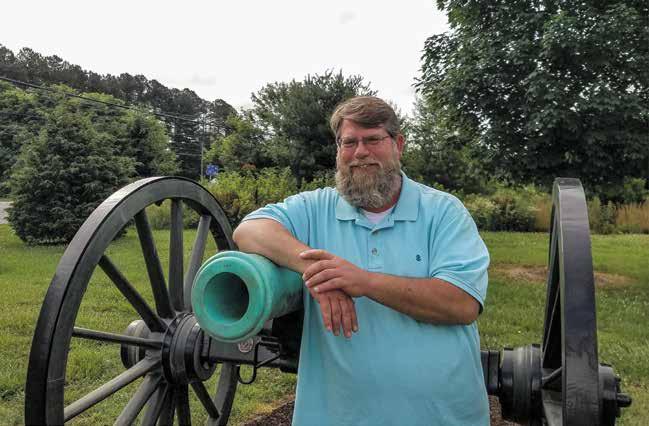
The cedar trees have grown, Eric Powell thought as he recently drove by Pelham’s Corner — a tract of Fredericksburg battlefield preserved and maintained by Central Virginia Battlefields Trust. He remembered the day nearly two years ago when students came from local high schools to clean Pelham’s Corner, plant small cedars, and learn about the site’s history. On that day, Eric had encouraged students to take pride in their volunteerism and work, telling them that as the years passed they will see the trees’ growth and perhaps even bring their own children there someday.
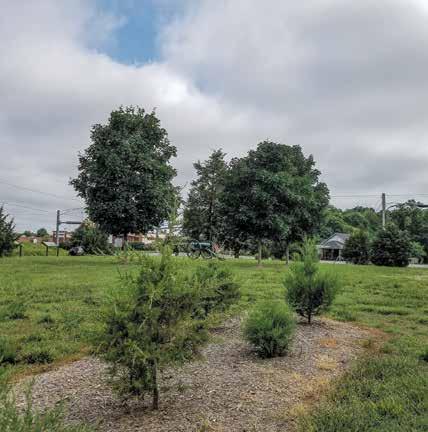
Helping students explore and connect with history is a life-long commitment for Eric. He has spent 31 years in education, after graduating from Radford University with a bachelor’s degree in social sciences and later adding two master degrees, one in history and one in educational leadership from Virginia Commonwealth University. He has taught in Stafford High School’s classrooms and now serves as a Social Studies Specialist for Stafford County Schools. Through his
career, Eric has received numerous awards, including Stafford County Teacher of the Year, the 1998 Region III Virginia Teacher of the Year, and the Brenton S. Halsey Award for Excellence in Teaching from the Virginia Historical Society in 2001.
Inquiry and exploration are words and concepts at the core of Eric’s teaching and planning philosophy. “I want to get kids excited about learning and give them opportunities to explore our past with all its impacts and causes. That’s what helps us understand the challenges today,” he explained. One of the ways that he has been directly fostering and implementing this principle is by helping school districts and classroom teachers make shifts from test preparation to engaging students, particularly helping students make connections with the history in their local community.
Eric brings his skills and passion to the Central Virginia Battlefields Trust board of directors as the Secretary and Education Director and has volunteered with this preservation organization since 2013. Some of his education initiatives include helping create historical videos, a project supported with a grant from the Duff McDuff Community Fund. The (usually) annual Youth Community Service Day is hosted at a battlefield site that needs a little extra love and care. The kids assist with clean up, planting or other light outdoor activities for a few hours and then spend the rest of the excursion learning about the site’s history and how they can be advocates for historic preservation and greenspace. Eric reaches out to teachers and students in civics classes and the Rho Kappa Social
Studies Honor Society to engage in action and community service directly on the battlefields. Once on the land, students are in an open-air classroom and able to consider the history that happened, ask questions, and consider what that history means to them personally.
As Eric pointed out, “When we preserve battlefield land, it is saving a piece of history for us to explore. It’s a place to ask questions: how do you feel about what happened here? Whether the student’s answers start with immediate inspiration or a negative view, it’s a way to engage in conversation about the past and bring historical perspectives and facts into the teaching moment. When students look at the past, I want them to see that our nation has gone through lots of challenges. It hasn’t always been good. That’s learning and life, and we all have the opportunity to go forward and continue this experiment in self-government.”
Eric Powell goes beyond helping to create teaching moments and preserving outdoor classrooms. He regularly engages in his own adventures to explore the past. As a member of the 47th Virginia Infantry, Co. I, “The Stafford Guard,” Eric participates in living history events and programs throughout the region. These activities are closely connected to his own first introduction to Civil War history and exploration: playing soldier at age five. He reconnected with “playing soldier” years later when a student invited him to a reenactment, when Eric remembered his deep interest in Civil War studies and the lives of the common soldiers.
Since 1992, he has been
Cedars planted in 2019 during the Youth Community Service Day at Pelham’s Corner (Fredericksburg) are growing well. make connections within the community and consider the lessons, challenges, and triumphs of the past,” Eric explained. “It’s also how we can build the next generation of grassroots, local preservationists who appreciate the stories of the past held in the land that is right here in the community, and maybe even their backyard.”
putting on a wool uniform, going on marches, demonstrating skills and drill of a Civil War soldier, and going where invited in communities across Virginia to share pieces of the past “come to life.” Some of his most memorable experiences in the field were at Gettysburg, Appomattox, an 8-mile march near Manassas, organizing the 150th reenactment of the Battle of Fredericksburg, and a freezing night of picket duty along the Rappahannock River.
The 47th Virginia Infantry unit actively encourages research and study, hosting staff rides and special tactical events for their members. Members value education and are especially pleased to support battlefield preservation through volunteer work days or financial assistance. In 2019, The 47th Virginia Infantry received the Dr. Michael P. Stevens Preservation Award from Central Virginia Battlefields Trust in recognition of their continuous support of preservation and quality education in the local community.
While 2020’s Covid-19 restrictions limited the living history events and options for bringing students on volunteer or field trip days, Eric Powell continued to work behind the scenes at CVBT, planning new resources and adventures connected to Fredericksburg, Chancellorsville, The Wilderness, and Spotsylvania Court House. He has been particularly working on finding ways to bring local history from this area into the state-approved curriculums and helping teachers find ways to connect their students with the local stories. “Finding ways to tie local history to teaching and curriculum is so important. That’s how we help students
As Central Virginia Battlefields Trust celebrates 25 years of preserving land at Fredericksburg, Chancellorsville, The Wilderness, and Spotsylvania Court House, Eric Powell is looking forward to the years ahead, feeling excited about finding new opportunities to connect kids and communities to the ever-growing conversations about the past. Stepping out of the classroom and onto a preserved piece of Civil War battlefield may create different experiences for each student, but those are moments that Eric wants them to explore and learn and they look at the past and build a brighter future.
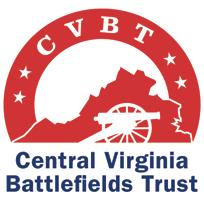
35 August 2021 Civil War News 35 August 2021 Civil War News
Eric Powell serves as the Secretary and the Education Director on the CVBT Board, bringing his expertise and career experience to create meaningful learning moments on the battlefields.
Deadlines for Advertising or Editorial Submissions is the 20th of each month. ads@civilwarnews.com Subscribe online at CivilWarNews.com
From the Editor
One of the best things I love about writing for a blog is that the feedback from readers is immediate. It’s like giving a tour or speaking to a roundtable: questions and conversations ensue, which are always a lot of fun. Sometimes people like to play “stump the historian,” and sometimes people can disagree quite vehemently with an idea or perspective. I have to be quick on my feet; I have to know my material, and I have to be able to defend my position publicly and immediately. That’s part of what make public history so invigorating!
If there’s a downside to writing for a blog, it’s the impermanent feeling a piece often has.
Yes, as the old saying goes, once something’s on the internet, it’s there forever, but nothing quite beats the satisfying feeling you get when you hold a tangible
document in your hand.
For ECW’s tenth anniversary this year, we get to have the best of both worlds.
As I was trying to think of an appropriate way to celebrate our milestone, publisher Ted Savas suggested we round up some of the best pieces from the blog and put them into book form, and he didn’t want to stop with just one. Think “series,” he told me.Thus, the ECW 10th Anniversary Series was born!
Our first two books, published by Savas Beatie and due in June and July, stand in conversation with each other: The Summer of ’63: Gettysburg, and The Summer of ’63: Vicksburg and Tullahoma Dan Welch and I co-edited the volumes, which feature the work of dozens of our ECW colleagues.
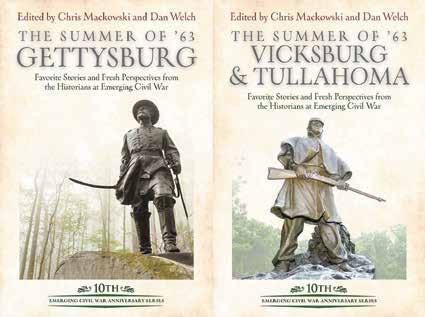
We gathered our best blog posts on those topics and updated them with footnotes and new information. We included edited transcript from a few symposium presentations and podcasts. We commissioned a few original pieces, and then we threw in some new maps and a bunch of photos.
We have a few more volumes in the works which we’ll sprinkle out over the course of the rest of our anniversary year, with Grant vs. Lee next on deck. This has been a rewarding experience for both Dan and me, particularly because we’ve had the pleasure to work with so many talented writers and historians. The books have also served as fun reminders of just how far ECW has grown in its first ten years, thanks, in large part, to readers like you.
Thanks for your ongoing
support. We hope you’re as excited about our anniversary as we are!
– Chris Mackowski, Ph.D. Editor-in-Chief

ECW Symposium
We’re less than two months away from our August 7-9 ECW Symposium at Stevenson Ridge and only a handful of tickets remain available. With a theme of “Fallen Leaders,” this year’s symposium includes two tours, nine speakers, and the camaraderie that only ECW can deliver. More information, including a link to purchase tickets, is available here: https://emergingcivilwar.com/2021-symposium/. We can’t wait to see everyone!
ECW Bookshelf
The Bermuda Hundred Campaign constituted an important part of Ulysses S. Grant’s 1864 overall grand strategy for the war when he set the North’s armies into motion all at once in an attempt to tie down the Confederacy from shifting reinforcements from one theater to another. The plan for Bermuda Hundred was especially important for Grant because it served to run interference for Grant himself as he moved overland from the Rapidan River through Virginia’s interior. It also pitted two of the war’s most colorful characters against one another, Maj. Gen. Benjamin Butler and Gen. P. G. T. Beauregard.
Sean Chick’s Grant’s Left Hook: The Bermuda Hundred Campaign, May 5-June 7, 1864, the latest offering from the Emerging Civil War Series, tells the story of this oft-overlooked phase of Grant’s plan. Find out more from publisher Savas Beatie: https://www.savasbeatie. com/grants-left-hook-the-bermuda-hundred-campaign-may-5june-7-1864/.

ECW News & Notes
Sarah Kay Bierle was caught wearing the ECW logo in Colorado’s Garden of the Gods during a family visit. She later bribed her family to drive through the estate of a Civil War general so she could get photos and write a blog post about the veteran and his castle later this summer!
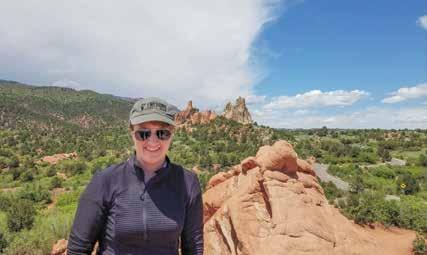
The Midwest Book Review offered a strong endorsement of Diana Dretske’s recent contribution to the Engaging the Civil War Series: “A welcome and original contribution to the growing body of American Civil War histories and biographies, The Bonds of War: A Story of Immigrants and Esprit de Corps in Company C, 96th Illinois Volunteer Infantry is a meticulous and informative study . . . [that] will have immense appeal and value for both scholars and non-specialist general readers.”
Bert Dunkerly has been exploring gaps: Keys Gap, Snickers Gap, Ashby’s Gap, and Manassas Gap, as well as hiking the Appalachian Trail. He has also joined the ECW Social Media Team, at least until he messes up and Paige, our social media manager, kicks him off.

Meg Groeling says she’s “hanging in there and trying to be a good patient. After her health problems this spring, she is trying to use her walker more, and she is also writing more. “Some days are better than others,” she says, “but I am very grateful for all of my ECW friends. Thanks for the cards and good wishes.”
From Chris Kolakowski: The Wisconsin Veterans Museum will reopen to the public July 1. I’ve also signed a contract with Casemate Publishers for Nations In The Balance: The India-Burma Campaigns, December 1943 –August 1944. It is expected to be released in spring 2022.”
Chris Mackowski and Kris White conducted a tour of the Slaughter Pen Farm on the Fredericksburg battlefield for the American Battlefield Trust on Friday, June 18. It was the first of a series of “Twilight Tours” the Trust will be offering this summer, featuring land they’ve helped preserve. ECW’s Kevin Pawlak and alum Dan Davis will be among those presenting tours later this summer, along with a White/Mackowski tour at Payne’s Farm on the Mine Run battlefield in July. For details, check out: https://emergingcivilwar.
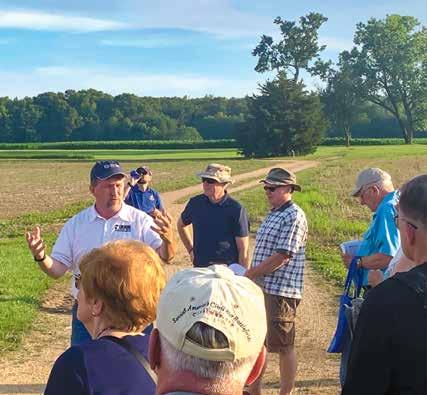
36 Civil War News August 2021 36 Civil War News August 2021 www.emergingcivilwar.com
Chris Mackowski
The latest ECW Series book looks at the Bermuda Hundred Campaign.
The ECW 10th Anniversary Series kicks off with a pair of hardcovers about the pivotal summer of 1863.
Chris Mackowski (white shirt, left) gesticulates wildly; behind him, Kris White takes a swig of water while on tour in Fredericksburg.
Sarah Kay Bierle visits the Garden of the Gods in Colorado.
com/2021/06/16/join-us-on-thebattlefield-this-summer/.
On June 7 Derek Maxfield gave a book talk about his work HELLMIRA: The Union’s Most Infamous Civil War Prison Camp – Elmira, NY for the New Jersey Civil War Roundtable. On June 16, he gave the same talk to the Genesee Valley Civil War Roundtable in Pavilion, NY.
From Terry Rensel: “As more things open up, I continue getting out on the road. I went on a tour of the North Anna Battlefield Park conducted by Gordon Rhea put on by the Hanover Tavern Foundation. I also visited Appomattox Court House and the D-Day National Memorial with young Maxwell Mackowski and his dad.”
10 Questions . . . with Sean Michael Chick
Sean Michael Chick, writing from New Orleans, is the author of the newest book in the Emerging Civil War Series, Grant’s Left Hook: The Bermuda Hundred Campaign. He was first profiled in the July 2018 ECW newsletter (https://conta.cc/ 2JVpQQz). You can read his full ECW bio here: https://emergingcivilwar.com/author-biographies/ authors/sean-m-chick/.

certainly made their stamps on New Orleans. How do you think those two men changed over the course of the war, from their time in New Orleans to the time when they locked horns in Virginia?
Butler spent 1863 scheming to undermine Lincoln and get his New Orleans command back. By 1864, it was obvious the war was coming to an end, and he needed to play a role to get any glory. Beauregard, meanwhile, had become a bit more realistic in his tactical plans by 1864.
You have an Emerging Civil War Series biography about Beauregard coming out later this year. Can you tell us a little about that?
There has not been a Beauregard biography since the 1950s, so it felt time to give him a fresh look. Also, being from New Orleans, I felt I had some insights into his personality that other authors dismissed.
What else do you have in the hopper?
The Maps of Shiloh. I am working on the April 7 fighting right now.
Lightning Round (short answers with a one-sentence explanation)
What is your favorite primary source? Liddell’s Record. It was not written for publication, so it is very honest.
Favorite Civil War-related monument? Hazen Brigade Monument at Stones River. An impressive piece of work, particularly considering it was made during the war.
Favorite unsung hero of the Civil War era? David Stuart. He led his brigade ably at Shiloh and was going to be promoted but political rivals blocked his advancement, much to Sherman’s disgust.
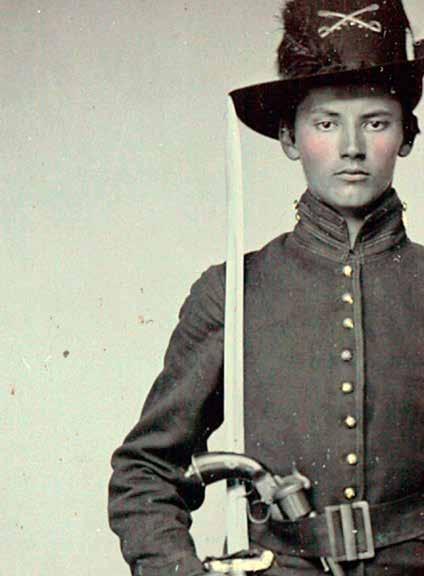
What’s a bucket-list Civil War site you’ve not yet visited? Pickett’s Mill. I hear the entrenchments are among the best preserved.
season. Nine days later, on June 28, Washington’s forces collided with the rearguard of Sir Henry Clinton’s British forces on their retreat through New Jersey. This action prompted the Battle of Monmouth.
As it happens, the latest Emerging Revolutionary War Series volume, just released, covers the winter period at Valley Forge: The Winter that Won the War (by yours truly). And don’t forget the previously released volume, which covers the battle of Monmouth, A Handsome Flogging.)
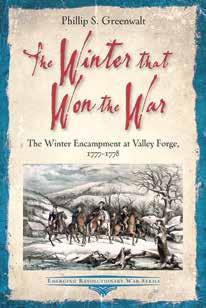
What do you find most interesting about the Bermuda Hundred Campaign?
I liked that it showed Grant at his best as a strategist, and for the first two weeks, it worked in keeping troops away from Lee’s army. One wonders what could have been accomplished if Butler had not been in command or he had more troops.

How did a guy from New Orleans find himself interested in Bermuda Hundred?
Mostly because of my earlier work on Petersburg and the New Orleans connection to Beauregard and Butler.
Butler and Beauregard both
Favorite ECWS book that’s not one of your own? Let Us Die Like Men. Lee White’s account of Franklin is the most gripping I have ever read.
Phill Greenwalt’s new ERW Series book, The Winter that Won the War.
The final “Rev War Revelry” for June will be on The Winter That Won the War. Check Emerging Revolutionary War’s Facebook or blog for details on this free bi-weekly historian happy hour. For those who cannot tune in to the Facebook Live on Sunday evenings, the videos are posted to Emerging Revolutionary War’s YouTube page shortly thereafter.
For those already looking toward the cooler months, remember to secure your tickets for the first annual Emerging Revolutionary War’s bus tour of the Trenton and Princeton campaign November 12-14, 2021.
From the Southern Theater: Lord Rawdon marched to relieve Ninety Six from Nathanael Greene’s siege operations. By the end of June 1781, Ninety Six was the only British stronghold remaining away from the British coastal enclaves, and it was about to be abandoned.
By Phill Greenwalt
June marked the start of summer. In 1778, the month also marked the end of a transition period for the Continental Army that survived the winter at Valley Forge. On June 19, General George Washington led his forces out of their encampment to embark on the next campaigning
You Can Help Emerging Civil War Emerging Civil War is a 501(c)3 not-for-profit organization. If you’re interested in supporting “emerging voices” by making a tax-deductible donation, you can do so by visiting our website: www.emergingcivilwar.com.

37 August 2021
37 August 2021 Civil War News
Civil War News
Sean Michael Chick.
Publishers/Authors Send your book(s) for review to: Civil War News 520 Folly Road, Suite 25 PMB 379 Charleston, SC 29412 bookreviews@civilwarnews.com MI Military Images magazine MilitaryImagesMagazine.com | Facebook.com/MilitaryImages Since 1979, MI has been America’s only publication dedicated to historic photographs of soldiers and sailors. By check payable to: Military Images PO Box 50171 Arlington, VA 22205 Online: MilitaryImagesMagazine.com SUBSCRIBE NOW 4 quarterly issues, $24.95 Want to try before you subscribe? Visit MI’s website to sign up for a 2 issue trial. TRIAL ISSUES Deadlines for Advertising or Editorial Submissions is the 20th of each month. Email Ads or Events to ads@civilwarnews.com
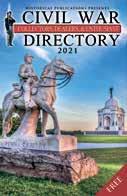


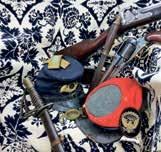

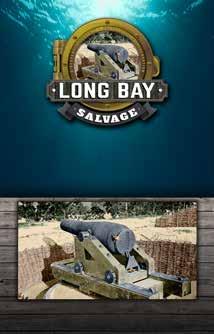










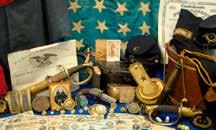
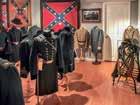















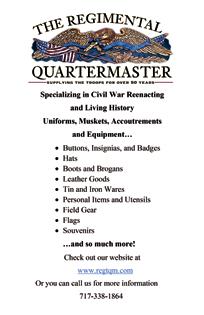





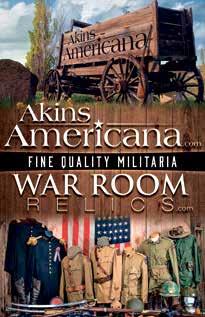
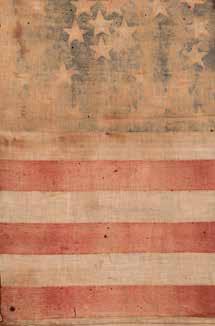

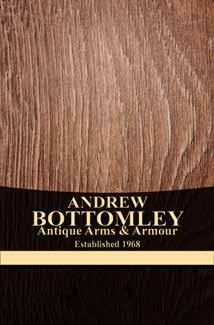






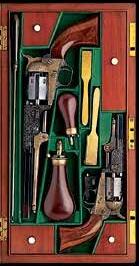

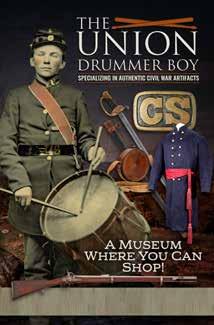
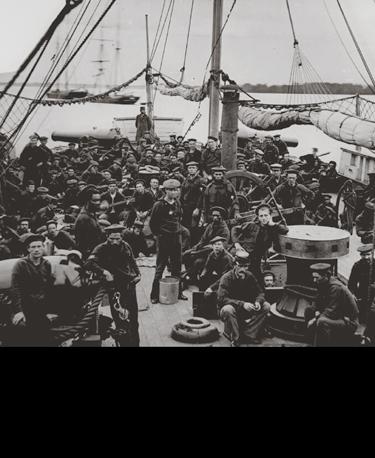

















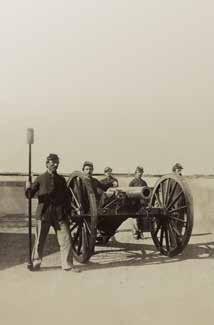







CivilWarShop.com Offering the Finest Investment Grade Military Memorabilia since 1981 Buy – Sell – Trade Certified Appraisal Services Life Member Company of Military Historians Lynn and Will Gorges, Proprietors 3910 US Hwy. 70 East New Bern, NC 28560 (252) 636-3039 • civilwarshop@gmail.com www.CivilWarShop.com Long Bay Salvage LLC specializes in the recovery and restoration of authentic Civil War Cannon with an emphasis on 10-Inch Columbiads, offering discerning collectors and museums the opportunity to own what has become a rare piece of Civil War history. Long Bay Salvage also works with historical entities (government and private) to recover and conserve large historical artifacts with Glenn Dutton Glenn Dutton glennjdutton@aol.com 770-351-7565 Rufus Perdue Rufus Perdue rperdue1@sc.rr.com 843-315-9818 PLEASE CONTACT US FOR MORE INFORMATION www.LongBaySalvage.com Promoters of Quality Shows for Shooters, Collectors, Civil War and Militaria Enthusiasts Military Collectible & Gun & Knife Shows Presents The Finest Mike Kent and Associates, LLC • PO Box 685 • Monroe, GA 30655 (770) 630-7296 • Mike@MKShows.com • www.MKShows.com Northwest Georgia Trade Center 2211 Dug Gap Battle Road Dalton, GA 30720 January 30 & 31, 2021 Chickamauga (Dalton) Civil War Show Williamson County Ag Expo Park 4215 Long Lane Franklin, TN 37064 December 4 & 5, 2021 Middle TN (Franklin) Civil War Show l Shiloh Buying & Selling Authentic Civil War Artifacts 2405 Oak Grove Road Savannah, TN 38372 731-438-3541 ShilohRelics.com History@shilohrelics.com owner Rafael Eledge .com Dealing in the Finest Authentic Militaria Since 1995 with an Emphasis on the American Civil War Pistols, Muskets, Carbines, Rifles, Bayonets, Swords, Uniforms, Headgear, Belt Buckles, Cannon, Buttons, Bullets, Artillery Implements Etc. Mid West Civil War Relics MidWestCivilWarRelics.com Allen Wandling Phone: 618-789-5751 Email: awandling1@gmail.com Museum Quality Civil War Union & Confederate Artifacts! We handle the Best Antique Bowie Knifes, Civil War Swords, Confederate D-guards, Antique Firearms, Dug Relics, Buckles & Belts, Identified Relics, Letters, Documents, Images, Currency, Uniforms, Head Gear & Flags. ROCK ISLAND AUCTION COMPANY REAL ART COMING IN 2021 REAL HISTORY REAL IRON CONSIGN TODAY Contact our Acquisitions Department by calling 800-238-8022 or Email: guns@rockislandauction.com WWW.ROCKISLANDAUCTION.COM Street West, Rock Island, IL 61201 info@rockislandauction.com Premier: April 16-18, Sept. 10-12 & Dec. 3-5 Sporting & Collector: Feb. 3-6, June 10-11 & Oct. 7-8 Online: Jan. 27, Feb. 24, Mar. 24, April 28, May 26, June 30, July 28, Aug. 25, Sept. TBD, Oct. TBD, Nov. TBD, Dec. TBD DATES SUBJECT TO CHANGE Extremely Rare New Haven Arms Company Iron Frame Henry Lever Historically Significant, National Treasure Ulysses S. Grant’s Appointment as Major General Signed by President Abraham Lincoln and Secretary of War Edwin Stanton Formerly From the Grant Family Historic, Highly Desirable Civil War New Haven Arms Co. Henry Lever Captain Stapleton Wright Historically Significant, Phenomenal W.H. Horstman & Sons Model 1850 Staff & Field Presentation Recipient Lieutenant Colonel Jacob Frick of the 96th Pennsylvania Volunteer Infantry Historic, Award Winning, Extremely Well-Documented, Superb Civil War G.W. Simmons & Bros. Sword Presented to Captain Jon Digman of Co. H, 183rd Pennsylvania Volunteer Infantry 2021 AUCTION SCHEDULE: Undisputed World Leader for Quality Collectable and Antique Firearms ® Abraham Lincoln Ulysses S. Grant 297 Steinwehr Avenue • Gettysburg, PA 17325 717-334-6245 • GettysburgMuseum.com @GettysburgHeritageCenter Operated by the non-profit Gettysburg Nature Alliance 297 Steinwehr Avenue • Gettysburg, PA 17325 717-334-6245 • GettysburgMuseum.com @GettysburgHeritageCenter Operated by the non-profit Gettysburg Nature Alliance Award-Winning MUSEUM Orientation MAP EVENTS... Licensed Battlefield Guided & Other TOURS Gift SHOP BookSTORE Visitor INFORMATION Accoutrements www.csarms.com PO Box 602 9150 John S. Mosby Hwy. Upperville, Virginia 20185 Shop Phone: 540-592-7273 Email: sophiacsarms@aol.com weaves the history behind Civil War flags of Tennessee: the stories of the women who stitched them, the regiments that bore them, and those who served under them and carried them. THE UNIVERSITY OF TENNESSEE PRESS GET YOUR BOOKS DELIVERED UTPress.org or 800-621-2736 This book Please see our website www.AndrewBottomley.com Mail Order Only • Worldwide Shipping Calling the UK from overseas: +44 1484 685 234 Calling our UK cellphone from outside the UK: +44 7770 398 270 email: sales@andrewbottomley.com The Coach House • Huddersfield Rd. HOLMFIRTH West Yorkshire United Kingdom HD9 3JJ £7,580 £17,500 £6,950 £3,850 £3,850 £1,750 Valuable Colts Attributed To Rembrandt Peale. 34 York St • Gettysburg, PA 17325 717-334-2350 • CIVILWAR@UNIONDB.com uniondb .com All Hands on Deck! Support Our Mission to Bring You the Naval History “This is the magazine for all things Civil War Navy. From ‘Uncle Sam’s web-feet’ to the ‘grey jacket navy’ raised by Jeff Davis! It is all here thoroughly researched and illustrated by beautiful contemporary navy images.” Ron Field, military historian and author of over 45 books, including Bluejackets: Uniforms of the United States Navy in the Civil War Period, 1852-1865. 1 Year—4 Issues: $37.95 Subscribe Now at civilwarnavy.com Or send a check to: CSA Media, 808 Drayton St., Savannah, GA 31401 International subscriptions subject to postage surcharge. Sailors and Marines on the deck of the U.S. gunboat Mendota, 1864. National Archives (Identifier 524548). P.O. Box 342 Thompsons Station, TN 37179 615-585-0115 Email: brubon2@bellsouth.net Franklin Relics Specializing in Accoutrements, Edged Weapons, Firearms and Uniforms FranklinRelics.com Bruce Hohler Proprietor www.AmericanRelics.net Allen Phillips 1014 Reservoir St., Suite B Harrisonburg, VA 22801 Phone: 540-476-1969 Email: americanrelicsnet@gmail.com American Relics Specializing in Buttons, Buckles, Currency, Hat Devices and other Military Artifacts. www.CivilWarBadges.com Everitt Bowles, Owner • 770.926.1132 1036 Washington Avenue Woodstock, Georgia 30188 The Largest Selection of GAR & UCV Hundreds of Memorabilia Items from Rev War through Vietnam Secure & Easy Guaranteed Authenticity of Every Item Vin Caponi Historic Antiques Vin Caponi, Jr. 18 Broadway Malverne, NY 11565 Store: 516-593-3516 Cell: 516-353-3250 rampantcolt@aol.com http://www.vincaponi.com We carry a very large inventory of Colt and Civil War firearms including muskets, carbines, rifles and accoutrements. Our inventory of historic antiques and firearms begin at the early collectors level and range all the way up to the advanced collector and investors level. 8895 Town and Country Circle • Knoxville, TN 37923 Phone: 865-693-3007 info@armyoftennesseerelics.com Civil War Artifacts Nick Periut Proprietor ArmyofTennesseeRelics.com Buying and Selling High Quality Images, Belt Buckles and Plates, Artillery Shells, rare Bullets and Buttons! Contact Glenn Dutton at: glennjdutton@aol.com or 770-351-7565 BUYING & SELLING Field & Heavy Artillery Cannon, Shells, Fuses & Etc. The 2021 Civil War Dealers Directory is out. To view or download a free copy visit: www.civilwardealers.com/dealers.htm The 2021 Civil War Dealers Directory is out. To view or download a free copy visit: www.civilwardealers.com/dealers.htm The 2021 Civil War Dealers Directory is out. To view or download a free copy visit: www.civilwardealers.com/dealers.htm The 2021 Civil War Dealers Directory is out. To view or download a free copy visit: civilwardealers.com/dealers.htm
Shenandoah University’s McCormick Civil War Institute Launches Cool Spring App



 by Jonathan A. Noyalas, Director
by Jonathan A. Noyalas, Director
Nearly two years in the making, Shenandoah University’s McCormick Civil War Institute (MCWI), in partnership with the University’s Center for Immersive Learning, launched an augmented reality app, Through Their Eyes, on March 24. The app, which can be downloaded for free on the App Store or Google Play (search “Through Their Eyes”) focuses on the individual experiences of soldiers engaged at the Battle of Cool Spring on July 18, 1864.
Fought along the banks of the Shenandoah River in Clarke County, Va., the Battle of Cool Spring does not rank among the Civil War’s most well-known engagements; however, to the soldiers who fought and were wounded at Cool Spring, and to family members who lost loved ones, there was no more significant moment in their lives than Cool Spring.
The app, based on the primary accounts of Union and Confederate soldiers, utilizes two forms of augmented reality to bring visitors into a particular moment in the engagement. First, the app contains one dozen 360 degree augmented reality videos. After scanning any flat surface with a smart phone or I-pad, users will see a three-dimensional topographic map of the battlefield with a series of markers noting the position of various regiments during the battle. Clicking on one of the markers transports users into a 360 augmented video experience where living historians recreate the experience described in the primary account.

Each vignette lasts approximately two minutes, and includes an introduction to that particular moment in the battle, the narrated primary account, and information about the soldier who authored the account.

Among the soldiers whose accounts are used to create an augmented video experience is Corporal Charles Lynch, 18th Connecticut Infantry. Lynch, who enlisted in the regiment on August 6, 1862, took great pride in the fact that he marched “every step” of 1,300 miles during the summer and autumn campaigns in the Shenandoah Valley in 1864. Lynch, whose diary was published in 1918, described the obstacles he and his comrades confronted in retreating across the Shenandoah River. Although Corporal Lynch thought he “was a goner” during the Union retreat across the Shenandoah River, he survived the battle and the war. After the conflict he was as an engineer. He died on August 2, 1924, and is buried in Spring Grove Cemetery in Hartford, Conn.
In addition to the augmented 360 video experience, the app includes a GPS-enabled augmented audio tour. When visitors, who walk the approximately two mile battlefield trail, approach within circa ten feet of a GPS coordinate, the augmented audio tour will engage and take visitors into a particular moment in the battle through the perspective of a soldier. In addition to an introduction to the moment, primary account, and information about that soldier, the augmented audio tour includes an appropriate soundscape for that vignette.
The 4th North Carolina Infantry’s James Columbus Steele is among the voices in
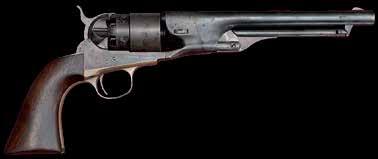


Corporal Charles Lynch’s account of the Battle of Cool Spring is among the two dozen accounts of Union and Confederate soldiers whose perspectives on the battle and its aftermath form the app’s foundation. The Civil War Diary of Charles H. Lynch, 1918.
the augmented audio experience. Steele, a member of the regimental band, enlisted in the regiment on June 7, 1861. Steele’s account focuses on Confederate General Robert Rodes’ initial flank attack against the northern end of the Union line. Steele, who survived the conflict, found enormous success after the conflict as an inventor, businessman, and factory, brick plant, and sawmill operator. He died in 1921 and is buried in Oakwood Cemetery, Statesville, N.C.
While anyone can use the 360 augmented reality video experience anywhere, the augmented audio experience is only usable on-site at Shenandoah University’s River Campus at Cool Spring Battlefield located at 1400 Parker Lane, Bluemont, Va. In the coming years additions to the app are planned. Further material will not only include additional vignettes from the battle, but also highlight the experiences of individuals who lived and labored on that portion of the Cool Spring battlefield now under the care of Shenandoah University during the Civil War era including Judge Richard Parker and the enslaved folk on the approximately 1,100 acre plantation, the Retreat.
Jonathan A. Noyalas is director of Shenandoah University’s McCormick Civil War Institute and a professor in the history department at Shenandoah University. He is the author or editor of fourteen books including Slavery and Freedom in the Shenandoah Valley during the Civil War Era released in late April by University Press of Florida.
39 August 2021 Civil War News 39 August 2021 Civil War News
Through Their Eyes Home Page. Courtesy MCWI.
Brandy Noyalas, wife of MCWI’s director Jonathan A. Noyalas, explores the app’s 360 augmented video experience. Courtesy MCWI.
MCWI’s director Jonathan A. Noyalas discusses the augmented audio experience during the app launch.
Cliff
9150
(Rt. 50)
20185
US Mail: PO BOX 602 (540) 592-7273 • SophiaCSArms@aol.com
Sophia | Proprietor CSArms.com
John S. Mosby Hwy.
Upperville, Va
for
Collector’s Arms 1700-1945 Militaria Specializing in Civil War-World War II
CIVIL WAR BOOK,___ B mv 11:

Civil War News book reviews provide our readers with timely analysis of the latest and most significant Civil War research and scholarship. Contact email: BookReviews@CivilWarNews.com.

A Pioneering study of Gettysburg Field Hospitals and Aid Stations

Bullets & Bandages: The Aid Stations And Field Hospitals At Gettysburg. By James Gindlesperger Appendices, Notes, and Index, 360pp., 2020. Blair/ Carolina Wren Press. www. blairpub.com. Cloth. $29.95.
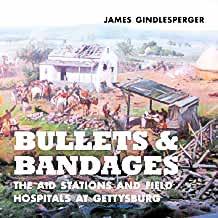
Reviewed by David Marshall
Confederate Innovation and Impromptu Naval Forces on the Mississippi River
Defending the Arteries of Rebellion: Confederate Naval Operations in the Mississippi River Valley, 1861–1865. By Neil P. Chatelain. Illustrated, Index, bibliography. Savas Beatie Publishers, www.savasbeatie. com, 2020, 324 pp., hardbound, $32.95.

Reviewed by Wayne L. Wolf
barriers to Admiral Farragut’s fleet and Porter’s river flotilla.

From the first Confederate naval victory at Head of Passes to isolated hard won skirmishes on the Mississippi and Yazoo Rivers, the Confederate naval force tried a three-pronged strategy of circumventing the blockade to keep supply lines open, attacking Northern commerce, and keeping the port of New Orleans north to Kentucky free of Union control. They ultimately were most successful in only the first of these goals, interfering with Northern commerce. Yet, their small, improvised navy managed to delay the Union fleet from cooperating with the army in capturing ports from Memphis to New Orleans.
The failure could more appropriately be attributed to the lack of army and navy command coordination, too much confidence in the strength of the River Defense Force, and a lack of resources and manpower to compete with Union industrial capacity.
There have been many books written about the battle of Gettysburg since July 3, 1863, and new titles are published every year. These works cover nearly all aspects of the fighting during the three July days with many dealing with a specific part of the battle, others looking at the common solders, regiments, tactics, specific individuals, and even the campaign. Very few volumes have dealt with field hospitals and aid stations during and following the battle. Two great titles have been written about this topic in the past: A Vast Sea of Misery and A Strange and Blighted Land, both written by Greg Coco in the mid1990’s. James Gindlesperger has now written an excellent guide book that provides students of the battle of Gettysburg’s with an understanding of the medical assistance provided many soldiers during the hostilities and the aftermath. Enthusiasts will learn about the many citizens who opened their homes and farms to
care for the many brave men from the Union and the Confederacy who fought in this historic battle.
Over 160,000 men fought in this engagement. During the battle there was a total of 51,112 casualties including 7,052 dead and 33,264 wounded Union and Confederate soldiers, approximately one in three soldiers ended up a casualty. When the two armies departed a few days later, thousands of wounded remained.
Many hospitals and aid stations were set up throughout the battlefield for corps, divisions, and regiments. Following the fighting when both the Army of the Potomac and the Army of Northern Virginia returned to Virginia, many men had to be treated around the Gettysburg area.
Gindlesperger’s guide and field study has a distinct view of this battlefield town and presents ideas and information that will benefit many enthusiasts, trampers, and armchair students. This monograph is broken into sixteen chapters that tell the story of the battlefield’s field hospitals. The text begins by detailing the treatment of the wounded, including the efficiency of Letterman Plan, and the difficulties associated with burial of the dead.
The next eleven chapters deal with farms, homes, churches, and schools around Gettysburg.
Some sites are well known such as the David Wills House, the Lutheran Seminary, the Nicolas Codori Farm, the Adam Trostle Farm, the Jacob Weikert Farm, the George Spangler Farm, the Jacob Brinkerhoff Farm, and the St. Francis Xavier Church. What
see page 42
Numerous accounts have been published of the Union’s naval operations that helped capture Forts Henry and Donelson, Vicksburg, and New Orleans; this meticulously researched volume comprehensively covers the Confederacy’s attempt to retain control of the Mississippi River Valley.
At the outset of the Civil War, the South was faced with cobbling together a navy from few resources, impromptu construction, innovative strategies, and an ad hoc naval force. A fully functional river force capable of retaining control of the Mississippi River and its tributaries was one of Navy Secretary Stephen Mallory’s top priorities. His desire was to utilize a fleet of ironclad warships and converted wooden vessels to keep internal Confederate supply lines open.
The Confederacy started the war with no government shipyard, little money, and few ships. Yet to defend the Mississippi, they still managed to create an ammunition factory, a laboratory for producing heavy armament, ironclads like the CSS Arkansas, and innovative new weapons, that included fire rafts, sunken ship barriers, and torpedoes to slow down the Union flotillas and prolong control of the Mississippi valley. The Confederate River Defense Force and the independent Louisiana Navy, while improvised and makeshift, proved formidable, albeit temporary,
From the early days of the war, the South learned the value of armored vessels, the need to fortify land positions by shifting limited resources, running ships past Union strongholds, and using unconventional weapons to blunt Union naval superiority. While ultimately failing in their attempt to retain control of the Mississippi, it was not for the lack of trying and the courage of the defenders.
Neil Chatelain does a magnificent job of weaving extensive research into a readable and engrossing, almost day by day, analysis of the Confederate navy’s actions on the Mississippi. This book is thoroughly researched, eminently readable, engrossing, and essential to any understanding of the Confederate navy’s role in the western theatre. Every historian of the Trans-Mississippi should add this volume to their library.
Dr. Wayne Wolf is Professor Emeritus at South Suburban College and the author of numerous Civil War books and articles including Two Years Before the Paddlewheel, The Last Confederate Scout, and Soldiers, Sailors and Scoundrels of the Civil War.
100 Significant Civil War Photographs: Atlanta Campaign collection of George Barnard’s camera work. Most of the photographs are from Barnard’s time in Atlanta, mid-September to mid-November 1864, during the Federal occupation of the city. With this volume, Stephen Davis advances the scholarly literature of Barnardiana.

40 Civil War News August 2021 40 Civil War News August 2021
Want To Advertise In Civil War News? Email us at: ads@civilwarnews.com
The American Civil War was the first war in which both sides widely used entrenchments, repeating rifles, ironclad warships, and telegraphed It was also the first American War to be extensively photographed. Mathew Brady, Alexander Gardner and Timothy O’Sullivan are famous for having made iconic photographs in the Civil War’s eastern theater. George N. Barnard deserves to be ranked in this top tier for his photographic work in the war’s western theater. A civilian photographer hired by Gen. William T. Sherman’s chief engineer to take pictures of fortifications around Atlanta, Barnard took several hundred of them in and around the city in the fall of 1864. His most famous is the site of Union Maj. Gen. James B. McPherson’s death in the battle of Atlanta, July 22, Thus far, no comprehensive, definitive listing has been made of the photographer’s work. The Library of Congress has 130 images; the U. S. Military Academy at West Point, New York, has at least 98 photographs, donated by Captain Poe’s widow. Other repositories, such as the Gilder Lehrman Institute of American History in New York City, have smaller collections. For this book we have chosen a hundred images we deem “significant,” though other students may wonder at some of our selections. We hope that this work will stimulate further interest in Barnardiana, and that other scholarly volumes are yet to come. The Atlanta Campaign STEPHEN DAVIS 100 SIGNIFICANT CIVIL WAR PHOTOGRAPHS ATLANTA CAMPAIGN $19.95 + $3.50 shipping 128 pages, photographs, maps,
ISBN:
Order online at www.HistoricalPubs.com or call 800-777-1862
bibliography. $19.95 + $3.50 shipping. Softbound.
978-1-61850-151-6. www.HistoricalPubs.com.
H Gettysburg Hospitals . . . . . . . . . . .
An In-depth Analysis of Grant’s Chattanooga Campaign
The Impulse of Victory: Ulysses S. Grant at Chattanooga.
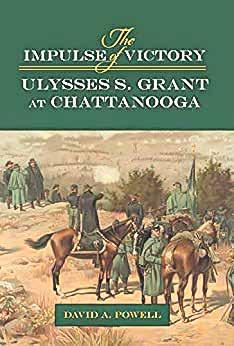 By David A. Powell. Appendix, Notes, Bibliography, and Index,
By David A. Powell. Appendix, Notes, Bibliography, and Index,
POWs: History’s Political Pawns
246
pp., 2020. Southern Illinois University Press, www.siupress. com. Hardback. $34.50.
Reviewed by John D. Fowler
on Ulysses S. Grant. Powell, a business executive by profession, is a prolific and well-regarded Civil War author by avocation. He is perhaps best known for his Chickamauga Campaign trilogy, as well as Battle Above the Clouds: Lifting the Siege of Chattanooga and the Battle of Lookout Mountain, October 16-November 24, 1863. Impulse to Victory is a natural fit with the author’s other work that covers Western Theater campaigns. What distinguishes this book from the others is that Powell focuses not only on the battle but also on Grant’s performance and generalship at this critical point in both the war and his career.
a fair commander who owes his success at Chattanooga (and perhaps his entire military career) to tenacity and luck. Grant does not perform exceptionally well at Chattanooga, and yet he gains credit for a battle actually won by the Army of the Cumberland’s soldiers in an impetuous charge and Confederate incompetence. The Grant who emerges from the pages of Powell’s book is far more nuanced than the one found in the ever-increasing hagiographical works on the general.
Useful Captives: The Role of POWs in American Military Conflicts. Edited by Daniel Krebs and Lorian Foote. Illustrated, notes, index, 344 pp., University Press of Kansas, kansaspress. ku.edu, 2021, hardcover. $45.00
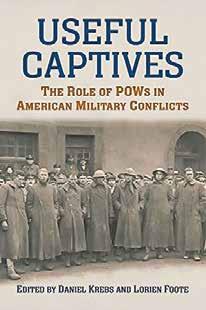 Reviewed
Reviewed
by Wayne L. Wolf
landscape, resistance, release, and lament. Without a thorough analysis of each of these stages, the POW experience can only partially be understood.
In November 1863, Union forces under the command of Major General Ulysses S. Grant routed the Confederate Army of Tennessee under Braxton Bragg outside Chattanooga. The defeat at Chattanooga was the last great Confederate catastrophe of 1863, following Gettysburg and Vicksburg. Arguably Chattanooga was the most damaging because it opened Georgia and its machine shops and farms up to Union invasion.
The Impulse to Victory by David A. Powell is the story of that defeat and the campaign’s effect
Powell examines the prelude to the battle, provides an in-depth analysis of the details of the campaign, covers all the major issues and personalities, and explores the aftermath of the encounter in twelve tight and well-written chapters. Troop movements, logistical considerations, etc., are all granted proper attention. Anyone unfamiliar with the battle would find Impulse to Victory interesting, informative, and enjoyable.
The question could be asked whether or not another book on the battle is needed, considering that Powell covers material that other historians have already presented and reaches conclusions that are not unique from previous works. A strong case in favor of the book can be argued on at least three grounds. First, Powell does an excellent job of presenting Grant realistically as
Second, Powell’s account is concise and well-written and stands out as perhaps the best short volume on the battle. It is perfect for the student or the aficionado. Third, and unfortunately perhaps the most important reason why this book is crucial now, is that professional Civil War historians have generally stopped writing military history. Indeed, scholars are becoming prejudiced against military studies. Many younger students of the war today know nearly nothing about the actual military events of the conflict. Considering the war was won and lost on the battlefield, this is devastating and detrimental to the field.
In sum, this is a solid work that both lay readers and professional historians will find it useful.
John D. Fowler Ph.D., is a professor at Dalton State College, and military historian specializing in the Civil War Era. He has written several books and articles primarily focused on the Western Theater of the conflict.
Useful Captives is a compilation of 11 essays on POWs emanating from the 2017 Filson Historical Society’s lecture series. The essays encompass the experiences of POWs from the Georgia Creek Border incursions to detainees from Iraq and Afghanistan. Four chapters deal specifically with the American Civil War.
The role of POWs is discussed around five main themes: the hostage as a negotiating tool, a propaganda asset, an object of indoctrination, the proof of military success, and use as a political expedient. Each chapter interprets the story of POWs into a broader narrative about society and the cultural and social context of warfare. Studying POWs illuminates the values inherent in both the captors and captives, whether those be the definition of manliness and courage, the role of defiance in defining POW character, or how POWs can become the targets of hatred and revenge.
To fully understand the POW experience, the authors argue that seven phases of that experience need to be understood, i.e. pre-capture, capture, removal,
The four chapters dealing with POWS in the American Civil War include individual soldier vignettes as well as common conceptions and misconceptions regarding POWs, their ordeals, motivations, and use as political ploys, particularly in the North. Additionally, environmental issues of Camp Douglas, Elmira Prison, and Andersonville, created problems for captives and the communities in which they were located. Likewise, Northern newspapers and politicians are called out for their biased coverage of the horrors of Southern prisons while neglecting the abuses in the Northern camps, political ploys that lasted decades after the war’s end. Post Reconstruction writing by former Confederates tried to counter this Northern bias by creating the literature of the Lost Cause for which they fought.
One fourth of all Civil War soldiers were captured during the war and 56,000 died in prison. The editors of this text could easily have compiled a comprehensive book on these POWs and provide a more coherent analysis of POWS, both North and South. Their present attempt should be divided into a series dealing with the POW experience in each American and foreign theatre of war. They attempt too much in a single volume that lacks the depth necessary for a complete analysis of the individual wars. Thus, this book serves best as an introduction to the trials of POWS over a 250 year span and begs the need for further research on each conflict.
Dr. Wayne L. Wolf is Professor Emeritus at South Suburban College and the author of numerous Civil War texts and articles including Two Years Before the Paddlewheel and the Last Civil War Scout. He is past president of the Lincoln-Davis Civil War Roundtable.


41 August 2021 Civil War News 41 August 2021 Civil War News Publishers/Authors Send your book(s) for review to: Civil War News 520 Folly Road, Suite 25 PMB 379 Charleston, SC 29412
Another Hit by Powell and Wittenburg
Tullahoma: The Forgotten Campaign that Changed the Course of the Civil War, June 23-July 4, 1863. By David A. Powell and Eric J. Wittenberg. Appendix, Notes, Bibliography, and Index, 395 pp., 2020. Savas Beatie, www.savasbeatie.com. Hardcover. $34.95.
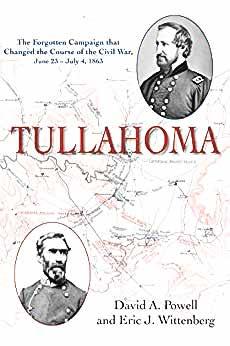
Reviewed by John D. Fowler
weeks with little bloodshed, drove Confederate General Braxton Bragg’s Army of Tennessee from middle Tennessee and finally secured the state for the Union. On par with Vicksburg and Gettysburg in terms of strategic consequences, the Tullahoma Campaign dramatically altered the situation in the Western Theater and led to the series of battles to secure Chattanooga and the gateway to Georgia.
H Gettysburg Hospitals Continued
from page 40
July 1863 was a critical month in the American Civil War. Impressive Union victories at Vicksburg and Gettysburg offered hope to a war-weary Northern populace and at the same time tested the resolve of a teetering Confederacy. The two battles were indisputably important to the final outcome of the war; however, an equally important, yet often overlooked, successful Federal campaign was decided at the same time.
While politicians, the press, and the public of both nations focused on events in Mississippi and Pennsylvania, Union General William S. Rosecrans and his Army of the Cumberland executed an impressive campaign of maneuver, and in a matter of
It is understandable that contemporaries “lost” the Tullahoma campaign among the great battles of 1863. While Rosecrans took pride in driving the Rebels from Tennessee at the cost of fewer than 500 casualties, President Lincoln and Secretary of War Stanton viewed the battle as a lost opportunity. Indeed, they chided the general that Bragg’s army had escaped destruction. Given the operational skill exhibited by the Union commander and the significance of the campaign to the movement against Chattanooga, it is both unfortunate and surprising that scholars have failed to examine it in greater depth.
Thankfully, historians David A. Powell and Eric J. Wittenberg have turned their attention and research to this forgotten campaign. Powell, a prolific author and noted authority on the Chickamauga Campaign, and Wittenberg, an equally prolific writer and a cavalry specialist, have produced an excellent study. In fourteen concise and well-written chapters, the authors cover the important events and personalities associated with the campaign from its beginnings to its aftermath. While little of their research or conclusions is new, this is still an important work for several reasons.
First, the campaign is often mentioned only briefly in other works that cover the Western

Theater or events in Tennessee. Powell and Wittenberg have given readers and scholars the indepth monographic study that Tullahoma deserves. The authors do justice to this complex campaign of intricate troop movements, long marches, feints, logistical concerns, bad weather, and skirmishes. What emerges is the brilliance of Rosecrans and the ineptitude of the Confederates. Bragg’s constant state of confusion as to Rosecrans’s objectives, exacerbated by the poor performance of his corps commanders, led to disaster for the Rebels as they ceded the southern portion of middle Tennessee without a fight.
The second reason this work is welcomed is that it clearly demonstrates the need for greater study of the military campaigns and battles of the Civil War. Far from being an exhausted field, Civil War military studies still has much to be explored.
In sum, this volume is an example of how a modern campaign study should be written. It is well-researched, well-written, and well-presented with excellent maps and illustrations. It contains balanced and nuanced evaluations of the leadership of Rosecrans and Bragg and presents realistic descriptions of their performance. Finally, it covers the often overlooked but critical role supply and logistics played in this campaign and, indeed, in all military campaigns. This book deserves a wide audience.
John D. Fowler Ph.D., is a professor at Dalton State College, and military historian specializing in the Civil War. He has written several books and articles primarily focused on the Western Theater of the conflict.

is interesting that the author included many smaller and less well known places of historic interest. People will be interested to learn that larger sites like the U.S. Sanitary Commission Lodge and Camp Letterman, not only provided services and aid to soldiers but prepared the wounded for transport to urban hospitals in places such as Philadelphia and Baltimore. Finally, the remaining chapters deal with the Hanover, Hunterstown, Fairfield, and Cashtown areas. An excellent overview of the hospitals, aid stations, farms, homes, and churches that took care of both Union and Confederate soldiers is covered throughout this treatment.
properties, notes, and an index enhance this manuscript.
This excellent volume contains many illustrations as well as a helpful map of all sites at the beginning of each chapter that provides helpful information and context about where many hospitals and aid stations were located. This monograph will help visitors to the greater Gettysburg area receive a better understanding of what doctors did in treating soldiers and what the townspeople went through in opening their homes and farms during and following the fighting. Highly recommended by this reviewer.
$19.95 + $3.50 shipping 128 pages, photographs, maps, bibliography. $19.95 + $3.50 shipping. Softbound.

ISBN: 978-1-61850-151-6. www.HistoricalPubs.com.
Order online at www.HistoricalPubs.com or call 800-777-1862
and his wife Suzanne continue the research of Greg Coco’s wellknown books and expand on the subject matter providing visitors with an excellent guide that includes the GPS coordinates of countless sites discussed in the text. People visiting Gettysburg will be able to add these important locations to their itinerary. This study is well written, soundly researched, abundantly illustrated, and enhanced with detailed maps. It is indispensable reading for anyone interested in the Battle of Gettysburg’s aftermath. Two valuable appendices, a glossary of Civil War era medical terms and money values of damaged
James Gindlesperger
David Marshall is a high school American history teacher in the Miami-Dade School district for the past thirty-four years. A lifelong Civil War enthusiast, David is president of the Miami Civil War Round Table Book Club. In addition to numerous reviews in Civil War News and other publications, he has given presentations to Civil War Round Tables on Joshua Chamberlain, Ulysses S. Grant, Abraham Lincoln, the Battle of Gettysburg, and the Common Soldier.
42 Civil War News August 2021 42 Civil War News August 2021 Publishers/Authors Send your book(s) for review to: Civil War News 520 Folly Road, Suite 25 PMB 379 Charleston, SC 29412 bookreviews@civilwarnews.com Subscribe at CivilWarNews.com 100 Significant Civil War Photographs: Atlanta Campaign collection of George Barnard’s camera work. Most of the photographs are from Barnard’s time in Atlanta, mid-September to mid-November 1864, during the Federal occupation of the city. With this volume, Stephen Davis advances the scholarly literature of Barnardiana. The American Civil War was the first war in which both sides widely used entrenchments, repeating rifles, ironclad warships, and telegraphed It was also the first American War to be extensively photographed. Mathew Brady, Alexander Gardner and Timothy O’Sullivan are famous for having made iconic photographs in the Civil War’s eastern theater. George N. Barnard deserves to be ranked in this top tier for his photographic work in the war’s western theater. A civilian photographer hired by Gen. William T. Sherman’s chief engineer to take pictures of fortifications around Atlanta, Barnard took several hundred of them in and around the city in the fall of 1864. His most famous is the site of Union Maj. Gen. James B. McPherson’s death in the battle of Atlanta, July 22, 1864. Thus far, no comprehensive, definitive listing has been made of the photographer’s The Library of Congress has 130 images; the U. S. Military Academy at West Point, New York, has at least 98 photographs, donated by Captain Poe’s widow. Other repositories, such as the Gilder Lehrman Institute of American History in New York City, have smaller collections. For this book we have chosen a hundred images we deem “significant,” though other students may wonder at some of our selections. We hope that this work will stimulate further interest in Barnardiana, and that other scholarly volumes are yet to come.
STEPHEN DAVIS 100 SIGNIFICANT CIVIL WAR PHOTOGRAPHS ATLANTA CAMPAIGN
The Atlanta Campaign
. . . . . . . . . .
Weekend Warrior: Over Fifty Years Re-living American History. By Lawrence J. Bopp, illustrated, appendices, subject index. Privately published 2020, Lawrence J. Bopp, paperback, 315 pages. $40
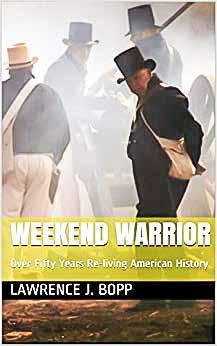 Reviewed by Craig Barry
Reviewed by Craig Barry
A Lifetime of Reenacting
their course and the 2nd NC soon folded, but Mr. Bopp had found something there that he really enjoyed and pursuing historical military reenacting would come to dominate his weekends for the next half century.

Mr. Bopp formed his own unit in 1968 in Baltimore, Md., that he called the 4th NC Infantry and maintained some of the same characteristics found in Gorman’s 2nd NC Infantry, most particularly the attention paid to their equipment and handmade woolen uniforms. His quixotic search for the right fabrics and patterns dominated his earliest recollections. Let me hasten to add, this was taking place during the time before anything in the way of quality reproduction gear was available; options were limited to what you could make yourself.
order was used. Naturally, this was an unwise practice that is now frowned upon. Today there at least some quality reproductions available which was not the case fifty years ago. It is now more widely recognized that when a historical artifact is lost or damaged in a reenactment or living history, so is a piece of history. The loss of these valuable artifacts is acknowledged by Mr. Bopp and he expresses his regrets about the matter.
that in Weekend Warrior a “farb” is always pointed out where some other guy lacks knowledge or cuts corners.

The hobby of U.S. Civil War reenacting has been around long enough now to have created a history of its own. Civil War reenactments began springing up around the time of the U.S. Civil War Centennial and have continued ever since. Weekend Warrior is the title of the memoirs of longtime reenactor Lawrence J. Bopp. He sets out here to prove the old saw that “we are all the heroes of our own story.” Mr. Bopp first began participating in American Civil War events during 1967 as a recruit in George Gorman’s 2nd NC Infantry, arguably the sine qua non of authentic Civil War units during that time. By all accounts George Gorman was an interesting character with a well-earned reputation for wild behavior. As often happens with reenactment groups, things ran
More often, what prospective reenactors would do was cobble together an outfit from their own closets which consisted of work or casual clothes, a reshaped western cowboy hat and work boots. Reenactors often showed up looking more like Texaco service station attendants than any sort of Union or Confederate Civil War soldier. A common insult at that time was to inquire, “what gas station are you fighting for?” The derogatory term, “farb,” is widely used by Bopp throughout the book to describe such participants.
Mr. Bopp also recalls the other alternative for more authentic Union and Confederate reenactors who routinely used surviving historical artifacts as part of their kit. Original jackets, trowsers (trousers), hats, and cartridge boxes were pressed back into service at Civil War reenactments.

The muskets were cobbled together from disassociated parts or else an original still in serviceable
There is something of a sliding scale in how Mr. Bopp considers matters of authenticity as it relates to the hobby of Civil War reenacting. He pays considerable attention to the hat and uniform part of his kit, which he terms his “costume.” The preferred term in the authentic living history community for the clothing worn is “period attire.” This may seem trivial but it is strongly inferred in this book that modern sewing machines were used to construct his Confederate “costumes.” However, sewing machines were not in wide use to construct Confederate uniforms domestically during the Civil War. Hence, most reenactors who participate in the history heavy side of the hobby hand sew their clothing as this was the method of construction during the 1860s. Further, the use of vegetable dyed cotton thread is used, and so on. There is more to authenticity than just getting the correct wool.
In addition, Bopp recalls that his first major purchase was a reproduction of the two-band 1862/3 Remington contract rifle that reenactors of the time incorrectly called the “Zouave.” These were never issued to Civil Warera Zouave units or for that matter anybody else. While they were among the first reproductions available, what is also true is that they are completely anachronistic to any authentic portrayal of a Confederate Civil War soldier in the Army of Northern Virginia. In fact, the reproduction “Zouave” rifle became so closely associated with those who Bopp derisively terms “farbs” that most mainstream Civil War reenactments eventually banned their use. He also sometimes calls The Battle Flag of the Army of Northern Virginia the “Confederate Battle Flag” and in at least one instance, “the Stars and Bars.” This is regrettable since the original 4th NC Infantry served with distinction in the Army of Northern Virginia. You are certainly to be excused if you don’t find such matters to be of any concern to the overall narrative. The broader point here is
These minor criticisms aside, there is much worthwhile information here and for the intended audience of American history buffs and reenactors the book can be recommended. For example, it is annotated in the Chicago style where a superscript number is placed in the text that corresponds to a footnote at the bottom of the page. The footnotes often contain important information that put things in better context and should always be read. Mr. Bopp makes this part easy on the reader. Another much appreciated feature was the subject matter index at the back of the book to assist in quickly finding people you might know as well as other points of interest. The book is arranged in chronological order and chapters correspond to different time periods in his long reenacting career which over time increased to include all periods of American history from Revolutionary War to World War II. Mr. Bopp also participated in a number of television programs and National Park Service Visitor Center films, an activity for which he devotes a separate chapter in the book. His recollections mirror my own observations about some of those same experiences.
The best parts in Weekend Warrior are the author’s vivid
recollection of hundreds of campfire stories involving his interactions with colorful characters over the years, many of whom have since passed away. The part of the living history hobby that many participants enjoy most begins after the battles or demonstrations are finished; the sun goes down and the serious drinking starts. Mr. Bopp mentions that he was known by the nickname “Uncle Filth.” It is apparently well deserved. If you enjoy pranks, salty language, misadventures, and scatological humor you are in for a treat. If not, consider yourself warned.
Craig L. Barry was born in Charlottesville, Va. He holds his BA and Masters degrees from the University of North Carolina (Charlotte). Craig served The Watchdog Civil War Quarterly as Associate Editor and Editor from 2003–2017. The Watchdog published books and columns on 19th-century material and donated all funds from publications to battlefield preservation. He is the author of several books including The Civil War Musket: A Handbook for Historical Accuracy (2006, 2011), The Unfinished Fight: Essays on Confederate Material Culture Vol. I and II (2012, 2013). He has also published four books in the Suppliers to the Confederacy series on English Arms & Accoutrements, Quartermaster stores and other European imports.
43 August 2021 Civil War News 43 August 2021 Civil War News
19th CENTURY LIVING HISTORY! James Country MERCANTILE 111 N. Main Liberty, MO 64068 816-781-9473 • FAX 816-781-1470 www.jamescountry.com Ladies – Gentlemen Civilian – Military • Books • Buttons • Fabrics • Music • Patterns • Weapons Mens, Ladies and Children’s • Civilian Clothing • Military Clothing • Military Accessories • Accoutrements Everything needed by the Living Historian! Our Clothing is 100% American Made! The home of HOMESPUN PATTERNS©
– MAKER –LEATHER WORKS (845) 339-4916 or email sales@dellsleatherworks.com WWW. DELLSLEATHERWORKS.COM
Popular Driving Trail Expands into Virginia
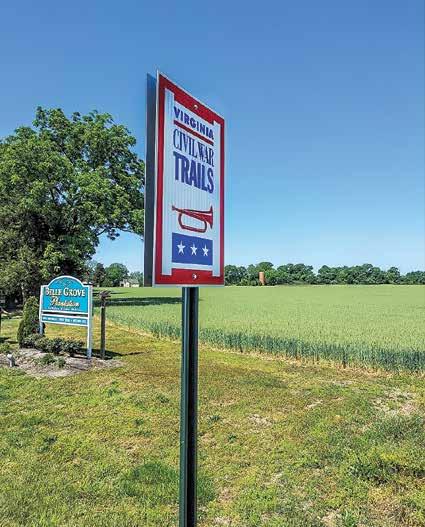
Civil War Trails Inc., in partnership with King George County Economic Development and Tourism are excited to announce the official expansion of the popular “John Wilkes Booth, Escape of an Assassin” driving trail into Virginia. The thematic driving trail that began in Maryland over 15 years ago now offers visitors 11 sites to explore. The four new sites in King George County, Va., are the latest additions to the Civil War Trails program that now offers over 1,350 sites across six states.

Originally designed and implemented in Maryland, the thematic driving trail offers something for history travelers, road trip enthusiasts, and communities hosting the Civil War Trails sites and signs. “By following the Trail, visitors experience the story of one of the most significant events in American history,” said Maryland Department of Commerce Assistant Secretary Tom Riford. “The newly expanded trail helps this scenic and historic driving tour come to life, in the places where the events happened.”

Since the “Escape of an Assassin” trail originally opened, interest from visitors has only increased and requests for the brochure rivals other Civil War Trails pieces in popularity. This interest was the driving force behind expanding the trail into King George County. “King George is excited to join the Civil War Trails sign network. With travel projected to be at an all-time high this year, our highways will be full of tourists and travelers looking for historical locations as they make their way to beaches and family gatherings,” explained Nicholas Minor, with the King George County Economic and Tourism Development Office.
Over the last year the Civil War Trails program offered a safe and



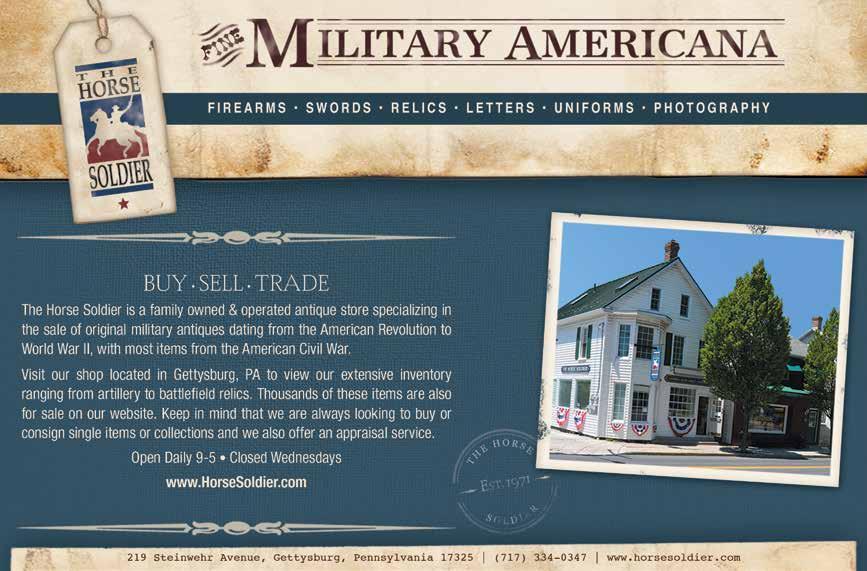
responsible amenity for families and travelers, often driving sorely needed revenues to businesses. Moreover, over the last several years the Civil War Trails program continued to experience growing visitation, along with an increasingly younger and more dynamic audience. “The [Booth] byway highlights attractions that make for a great side trip for history buffs who travel to or live in Washington D.C.,”
said Ashley Chenault, Chief of Tourism, Explore Charles County, Maryland.
The Civil War Trails team is excited about continuing to grow beyond the four thematic sites in King George and to uncover other aspects of their Civil War history. “With these signs as a starting point, we are happy continue working with stakeholders in King George to tell larger and more diverse stories in the county,” said Chris Brown, Assistant Director at Civil War Trails. For more information about Civil War Trails or to request your free brochure today connect with them at: www.civilwartrails.org, or @civilwartrails.
44 Civil War News August 2021 44 Civil War News August 2021
Drew Gruber (left) and Jason Shaffer (Right) install the interpretive marker for Quesenberry Cottage.
A new Civil War Trails “Trailblazer” welcomes guests to Belle Grove.
Want To Advertise In Civil War News? Email us at ads@civilwarnews.com Call 800-777-1862 CW N Vol. 46, No. 48 Pages, January 2020 $3.50 Civil War News America’s Monthly Newspaper For Civil War Enthusiasts Remembrance Day, 2019, Gettysburg President Lincoln was wrong–and visiting monuments.enactors; still impressive num-(Garry Adelman, American
Before making plans to attend any event contact the event host.
Deadlines for Advertising, Editorial or Events
Submissions is the 20th of each month. We strive to add all events submitted to us but do not guarantee that your event will be published.
There is a 100 word maximum for each event and a $50 insertion fee for each event.
Email events to: ads@civilwarnews.com

July 16-17 and Aug. 28-29, Georgia. Antique Gun Military Show
Explore antique guns, U.S. and foreign military arms, Civil War collectibles, books, and military collectibles of all periods. Exhibit, buy, sell, and trade.

IAMAW Union Hall, 1032 S. Marietta Parkway, Marietta. Fri. 12 p.m. – 5 p.m., Sat. 9 a.m. – 4 p.m. Admission $7, Ages 7-12 $1. For more information; 704-282-1339, richard@thecarolinatrader.com, www.thecarolinatrader.com.
July 24-25, Tennessee. Civil War Show and Sale
American Digger presents the Chattanooga Antique Militaria & Americana Show at the Camp Jordan Arena, 323 Camp Jordan Pkwy., East Ridge, TN. Hours are 9 a.m. to 5 p.m. on Sat and 9 a.m. to 3 p.m. on Sun. For more information; 770-362-8671 or americandigger.com/American-digger-events.
Aug. 14-15, Georgia. Civil War Show and Sale
42nd Annual show in Marietta at the Cobb County Civic Center hosted by the North Ga. Relic Hunters. Cobb County Civic Center, 548 South Marietta Pkwy SE, Marietta, GA 30060. Hours Sat. 9 a.m. - 5 p.m., Sun. 9 a.m. - 3 p.m. Show chairman: Ray McMahan at terryraymac@hotmail.com. For more information visit www.ngrha.com.
Aug. 28-29, North Carolina. Antique Gun and Military Antiques Show

82nd Old North State Show consisting of antique guns, U.S. and foreign military arms, Civil War collectibles, books, and military collectibles of all periods. Exhibit, buy, sell, and trade at the North Carolina State Fairgrounds, 1025 Blue Ridge Rd., Raleigh, N.C. Sat. 9 a.m. to 5 p.m. and Sun. 10 a.m. to 4 p.m. Daily admission adults $8, and ages 7-12 $1. For more information; 704-282-1339, richard@thecarolinatrader.com, www.thecarolinatrader.com.
Sept. 18-19, Pennsylvania. Reenactment and Living History: 159th Battle of Sharpsburg
This fall Reenactment and Living History event at the Daniel Lady Farm in Gettysburg will feature The Cornfield Battle, The Sunken Road Battle, and Burnside’s Bridge Battle, the bloodiest day on American soil, along with an extensive Living History area for an all-around, all-day educational Civil War experience for the whole family! For information; danielladyfarm.com.
Sept. 25, Illinois. Civil War & Military Extravaganza.
Zurko Promotions presents The National Civil War Collectors Fall Show and Sale which will be held at the DuPage County Fairgrounds in Wheaton. Hours: 9 a.m. to 4 p.m. Admission is $9, Free parking. For more information visit www.chicagocivilwarshow.com.
Oct. 7-10. Georgia. Georgia Battlefields Assn. Annual Tour

GBA’s 2021 Tour is scheduled for 7-10 Oct. 2021 based in Macon, Ga. at the Springhill Suites at 4630 Sheraton Drive in Macon. Room rate, which includes breakfast and tax is $119 per night. Please call the hotel at: 478-8039100 for room reservations. The 2-1/2-day tour cost is $430 and will cover two dinners, two lunches, maps, and bus transportation. The GBA Tour will cover the opening weeks of The March to The Sea, some additional events of the July 1864 Stoneman Raid, defenses of Macon and events relating to the capture of Jefferson Davis. Please mail a check for $430 check per person payable to GBA to Georgia Battlefields Association at P.O. Box 669953, Marietta, GA 30066, or pay online at http://www.georgiabattlefields.org.
Nov. 6, Virginia. Seminar
Shenandoah University’s McCormick Civil War Institute’s fall seminar and tour “We Shall Have Graveyards at Every Door”: The Lower Shenandoah Valley’s Border Region during the Civil War with Prof. Jonathan A. Noyalas. $25 registration fee covers morning lecture, lunch at SU, and afternoon caravan tour of sites between Stephens City south to the banks of Cedar Creek. Space is limited, so visit www.su.edu/mcwi to register. For information; jnoyalas01@ su.edu or phone 540-665-4501.
Nov. 20, Pennsylvania. Parade
The 64th Annual Remembrance Day parade, Gettysburg, Pa. is sponsored by the Sons of Veterans Reserve, the Military Dept. of the Sons of Union Veterans of the Civil War. Parade briefing at the Wyndham Hotel at 9:30 a.m. Units form up at noon on Lefever St. between Baltimore St. and E. Confederate Ave. Parade will start at 1 p.m. For information; majorsvrprovost@gmail.com or 609-812-2012.
Nov. 20, Pennsylvania. Civil War Ball
The original Civil War Ball will be held at the Wyndham Gettysburg Hotel located at 95 Presidential Circle. Price per person is $20 advance, $25 at the door. Music by Philadelphia Brigade Band, dances led by Victorian Dance Ensemble. Period dress encouraged. Door prizes, plus prizes for ladies’ cake walk. Cash bar. 8 p.m. to midnight. For information; email Col. Steve Michaels SVR at Lt.col.sm@gmail.com, 414-712-4655.

Dec. 4-5, Tennessee. Civil War Show and Sale
MK Shows presents the 34th Annual Middle Tennessee Civil War Show and Sale at the Williamson County Ag Expo Park, 4215 Long Lane in Franklin. The nation’s largest Civil War show, featuring 800 tables of antique weapons, artifacts and memorabilia from top dealers and collectors around the country and encompassing all eras of military history from the Revolutionary War through World War II. Appraisers are always on hand to help you identify and value your military collectibles at no cost. Hours are 9-5 on Sat., 9-3 on Sun., parking is free and admission is only $10/adults and children under 12 are free. For more information; www.MKShows.com or Mike@MKShows.com.
45 August 2021 Civil War News 45 August 2021 Civil War News
Camp Jordan Arena 323 Camp Jordan Pkwy. East Ridge, TN July 24-25, 2021 CHATTANOOGA ANTIQUE MILITARIA & AMERICANA SHOW American Digger® Magazine now has TWO great shows each year! January 15-16, 2022* Omar Shrine Temple 176 Patriots Point Rd. Mt Pleasant, SC For information: Call (770) 362-8671 or (716) 574-0465 Email: anita@ americandigger.com Both shows Open to Public: Saturday: 9-5 Sunday: 9-3 Dealer Setup: Friday 1-7 PM Sat 7-9 AM americandigger.com/american-digger-events/ Swords & Knives Antique Firearms Dug & Non-dug Relics • Civilian Items & Jewelry • Bottles & Stone Artifacts Art, Photos, & Books Militaria & Americana All Eras to WWII • Metal Detectors • Awards & Prizes Both shows feature all this and more: LOWCOUNTRY ANTIQUE MILITARIA & AMERICANA SHOW Display!Trade! Buy!Sell! Note date change! *Temporary date change to avoid New Years Eve conflict. www.NGRHA.com 43rd Annual Southeastern Civil War Antique Firearms Show and Cobb County Civic Center 548 S. Marietta Parkway, S.E., Marietta, Georgia 30060 $8 Admission Fee. Free for veterans, military personnel, and children under 10. August 14 & 15, 2021 Hours: Saturday 9–5 • Sunday 9–3 • Dug Relics • Guns and Swords • Books • Frameable Prints • Metal Detectors • Artillery Items • Currency • Documents Inquires: NGRHA Attn.: Show Chairman PO Box 503 Marietta, GA 30061 terryraymac@hotmail.com










































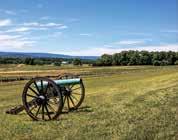








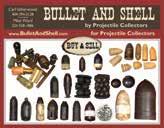


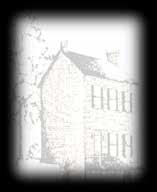




































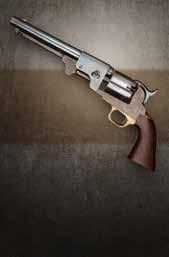





















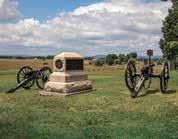











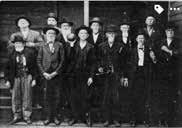












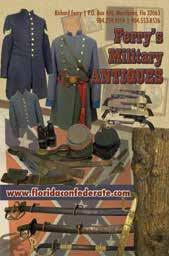
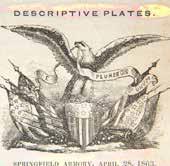
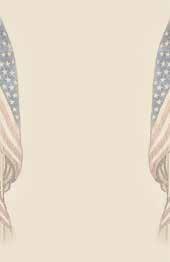















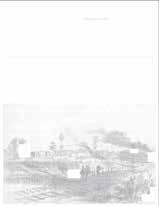



























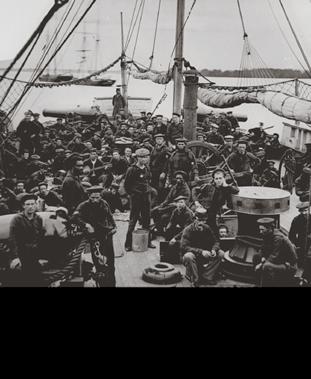
46 Civil War News August 2021 46 Civil War News August 2021 ACE Pyro & Fire Art – Black Powder ACE Pyro Saline, MI 48176 Phone: 877-223-3552 Website: http://www.acepyro.com Fire Art Clearfield, PA 16830 Phone: 814-765-5918 Website: http://www.fireartcorp.com Master Distributors of Schuetzen/Wano Black Powder 1FA, 2FA, 3FA, 4FA and Meal-D. B. M. Green Civil War Paper Memorabilia, Inc. B. M. Green PO Box 1816 Kernersville, NC 27285 Phone: 336-993-5100 Email: bmgcivilwar@triad.rr.com Website: http://shop.bmgcivilwar.net Confederate & Union autographs, letters, documents, diaries, Confederate currency, Confederate postal history, UCV & GAR encampment & first day covers. Our long time experience as dealers and collectors of Civil War material assures you a service second to none. Bowling Green Drummer Herman Kinder 14 Clayridge Court Bowling Green, KY 42103 Phone: 270-842-8058 or 270-779-3104 Email: cwbgdlr@twc.com Website: http://www.bowlinggreendrummer.com Bowling Green Drummer buys, sells & trades on quality, original Civil War, Indian Wars, Old West, WWI & WWII artifacts & militaria. This site has quality Civil War & other era militaria including WWI & WWII items. Regular high quality Union & Confederate artifacts are listed as well as items that are not normally seen on most Civil War websites. David S. LaSlavic 530 E. McDowell Rd. Suite 107-160 Phoenix, AZ 85004 Phone: 602-245-4721 Email: DAVEL@azswords.com Website: http://azswords.com Dedicated to Civil War Edge Weapons! Swords – Sabers – D-Guards – Bowies – Muskets – Rifles – Pistols – Revolvers Best time to call: 9AM – 7PM – Arizona time. ARIZONA SWORDS Mid West Civil War Relics Museum Quality Civil War Union & Confederate Artifacts! We handle the Best Antique Bowie Knifes, Civil War Swords, Confederate D-guards, Antique Firearms, Dug Relics, Buckles & Belts, Identified Relics, Letters, Documents, Images, Currency, Uniforms, Head Gear & Flags. 3500 Shacklett Rd • Murfreesboro, TN 37129 tom@stonesrivertrading.com (615) 336-2188 StonesRiverTrading.com Tom Hays Proprietor We carry all types of relics, dug & non-dug, Confederate & Federal. 100% Guaranteed. A strong emphasis on dug relics, but also a full line of non-dug relics of all types. Over 30 years experience with a full time, online store since 1997. We also have a shop located five miles from Battlefield that is open by appointment. The Maryland Arms Collectors Assoc., Inc. presents The “Original Baltimore” Antique Arms Show Since 1955 Maryland State Fairgrounds Timonium, MD North of Baltimore, York Road, MD. - Rt. 45 1,000 8-Foot Tables March 20-21, 2021 Public Hours: Sat. 9 to 5, Sun. 9 to 3. Admission: $10.00 – Modern Handguns are Prohibited –Complete information on web site: www.baltimoreshow.com Or Call 443-497-9253 Known as the “CROWN JEWEL” of Collector’s Shows! BrentsAntiques.com Specializing in Civil War and World War II Militaria Cell: 336-580-3330 • Email: Bsmith1181@aol.com Website updated Daily! Civil War Buttons William Leigh PO Box 145 Hamilton, VA 20159 Phone: 703-777-8549 Email: wmleigh@msn.com Website: http://www.civilwarbuttons.com Collector & Purveyor of American Military Buttons. Our business is founded on the fundamental principle that our customers are our most important resource. Buy with confidence and be assured that the items you order are authentic & accurately represented. Also, interested in purchasing all types of buttons, uniforms, other historical & military items that you may have to offer. Steve & Melody Strickland PO Box 17 Cumming, GA 30028 Phone: 770-633-5034 Email: 66thgeorgia@bellsouth.net Website: http://www.dixierelicsonline.com eBay ID: Dixierelics Civil War Firearms, Edged Weapons including excavated and non-excavated relics. Our specialty is American Civil War but we do deal in World War and World War II militaria. Burnt Hickory Relics David Baity & Jeff Cash Dallas, GA (Atlanta area) David’s Phone: 770-871-8753 Email: csa1864dab@comcast.net Jeff’s Phone: 678-471-4014 Email: RelicDealer67@gmail.com Looking to buy one piece or entire Civil War collections. Buy, sell and trade. Specializing in quality dug relics such as artillery, bullets, cartridges, Confederate and Union belt buckles, plates and buttons. Will travel to buy collections. J h J H y Q G t b g PA j yHayes Otoupalik Militaria PO Box 8423 Missoula, MT 59808 Phone: 406-549-4817 Email: hayesotoupalik@aol.com Website: http://www.hayesotoupalik.com We have been collecting and dealing in American Militaria from 1830 to 1960 for over 45 years. We Buy, Sell, Trade, Appraise. Your satisfaction is always assured. See our website for over 5,000 American Militaria GET SERIOUS ABOUT COLLECTING! “LET’S CHARGE TO VICTORY!” in JOSHUA’S ATTIC website. Specializing in Photos, Insignia, Weapons, Shells, Plates, Accoutrements and Anything Cool. Visit: www.JoshuasAttic.com HMS Productions, Inc. Charles Mauro & Don Hakenson 2508 Iron Forge Road Herndon, VA 20171 Email: cmauro10@aol.com or dhakenson@verizon.net Website: http://www.hmshistory.com HMS Productions covers the Civil War in Northern Virginia. Our products include three tour guides and DVD on Colonel John S. Mosby’s Combat Operations in Fairfax, Loudoun and Fauquier counties. We have a book and DVD on the Battle of Chantilly. We also have books on the Civil War in Alexandria and Fairfax County; and on civilians and spies. John S. Mosby MidTenRelics/YesterYear Larry Hicklen 3511 Old Nashville Hwy. Murfreesboro, TN 37129 Phone: 615-893-3470 Email: larryhicklen@comcast.net Website: http://www.midtenrelics.com Since 1977! Our specialty is museum quality Civil War artifacts for sale, both Union and Confederate items including artillery, swords, rifles, muskets, belt buckles, buttons, currency, images, and documents. Visit us online, at shows and by appointment only. North MS Civil War Relics Tony & Lydia Moore 248 Hwy. 72 E, PO Box 83 Burnsville, MS 38833 Phone: 662-802-0041, 662-665-2290 Email: Tony@nmsrelics.com Website: http://www.nmsrelics.com We offer wide range of Civil War relics – always having plenty of excavated items. We are always looking to purchase “New” items. Come by our shop or call/email us and be sure to look for us at most major shows. A 50 YEAR COLLECTION Soldiers Letters & Artifacts Will buy letter collections, ID discs & slave tags Call: Cal Packard @ 419-565-4100 http://www.mqamericana.com Email: cal@mqamericana.com WWW.PECARD.COM MADE IN THE USA SINCE 1902 Green Bay, WI 54311 Info@pecard.com 1-920-468-5056 DEALER INQUIRES WELCOME Whether genuine relic or an authentic reproduction, valuable leather needs care. Pecard Antique Leather Dressing has time tested, proven results for the care and treatment of oil tanned leather. 14 Rick Burton’s Civil War Antiques 931-B S. Main St. #110 Kernersville NC 27284 Phone: 336-830-1203 Email: ccrelics@ccrelics.com Website: http://www.ccrelics.com Authentic Civil War Military Items with emphasis on Confederate. Revolvers, muskets, carbines, swords, knives, pistols, buttons, bullets, belt plates, cannon and artillery projectiles. We sell both non-dug and dug relics, Union and Confederate. We also offer military objects from the American Revolution, War of 1812, Mexican War, Indian War, World War and World War II. Regimental Headquarters Karen Eubanks Falmouth, VA 22403 Email: regimentalhq@cox.net Website: http://www.regimentalheadquarters.com Ebay User Id: Regimentalheadquarters Authentic American Civil War Artifacts. Dug & non-dug. Specializing in Buttons and ID tags. setup at many shows and also sell on eBay. Over 30+ years experience. Contact me if there is something you are looking for. RegimentalHeadquarters.com 1,000’s of Civil War Treasures! Plus! Revolutionary War Spanish-American War Indian Wars • Mountain Men Bowie Knife Collector Arms Fur Traders World Wars I & II April 24 Sept. 25 2021 • CHICAGOLAND’S NATIONAL OSMA LLC Hickory Hill Mansion • 9222 Wickham Manor Way Ashland, VA 23005 • 804-543-4597 • oldsouthantiques@gmail.com Buying & Selling only the Highest Quality Original Confederate Antiques in the World OldSouthAntiques.com CivilWarGuru.com Civil War Shot and Shell Relics CivilWarShotandShellRelics.com P.O. Box 362 East Petersburg, PA 17520 Ph: 717-449-6302 or 717-380-4685 Email: ShotandShellRelics@yahoo.com CivilWarGuru.com Steve Munson 151 Atkinson Hill Ave Bardstown, KY 40004 Phone: 502-349-0910 • Email: stevemnsn@yahoo.com Rev-War thru WWII Artwork Cannons Airplanes Classic Corvettes Free Verbal Appraisals 50+ Years of Collecting l l l l l l l Special Interest in Civil War Watch the Civil War Guru on youtube.com Civil War Shot and Shell Relics Specializing in Artillery Items, Buckles and Plates, Bullets, Confederate and Union Buttons, Insignia, Military Items and Misc. Dug Relics. CivilWarShotandShellRelics.com P.O. Box 362 East Petersburg, PA 17520 Ph: 717-449-6302 or 717-380-4685 Email: ShotandShellRelics@yahoo.com Christopher & Carrie Harwick Buying and Selling The Finest in Americana 11311 S. Indian River Dr. • Fort Pierce, Florida 770-329-4985 • gwjuno@aol.com George Weller Juno John & Nikki Walsh Fort Donelson Relics FortDonelsonRelics.com Full Line Civil War Artifact Dealer Email: john@fortdonelsonrelics.com Promoters of Quality Shows for Shooters, Collectors, Civil War and Militaria Enthusiasts Mike Kent and Associates, LLC PO Box 685 Monroe, GA 30655 (770) 630-7296 Mike@MKShows.com • www.MKShows.com January 30 & 31, 2021 Chickamauga (Dalton) Civil War Show November 13 & 14, 2021 Capital of the Confederacy Civil War Show Get your tickets online! 401 Baltimore Street Gettysburg, PA 17325 717-334-8838 www.farnsworthhouseinn.com The Historic FARNSWORTH HOUSE INN “The Showplace of the Civil War” Fine Antiques & Militaria Military Items 1650-1945 Armor Swords Firearms Bayonets Equipment Accoutrements www.csarms.com PO Box 602 9150 John S. Mosby Hwy. Upperville, Virginia 20185 Shop Phone: 540-592-7273 Email: sophiacsarms@aol.com C.S. Arms, Inc. Specialize in U.S. & British Militaria American Digger Magazine has TWO great annual shows! Call (770) 362-8671 or (716) 574-0465 Email: anita@ americandigger.com Both shows americandigger.com/american-digger-events/ Camp Jordan Arena 323 Camp Jordan Pkwy. East Ridge, TN July 24-25, 2021 CHATTANOOGA ANTIQUE MILITARIA & AMERICANA SHOW Swiftly becoming one of the southeast’s biggest shows! January 1-2, 2022 LOWCOUNTRY ANTIQUE MILITARIA & AMERICANA SHOW Don’t miss the first show of a brand new year! Bigger & better than ever! Swords & Knives Antique Firearms Dug & Non-dug Relics Civilian Items & Jewelry Bottles & Stone Artifacts Art, Photos, & Books Militaria & Americana All Eras to WWII Metal Detectors Awards & Prizes Both shows feature all this and more: Display!Trade! Buy!Sell! 43rd Annual Ohio Civil War Show Including WWI & II 28th Annual Artillery Show Military Material From 1775 Through 1945 Saturday May1st – Sunday May 2nd 2021 Sat. 9:00 – 5:00 Sun. 9:00 – 3:00 Richland County Fairgrounds, Mansfield, Ohio Location: US-30 and Trimble Road 800 Tables of Military Items, Books, Prints and More For Buy, Sell, Trade & Display SPECIAL FEATURES Artillery Demonstrations & Cannon Firing Demonstrations Civil War & WWII Encampments Sutler’s Row Field Hospital Scenario Period Church Service Camp Chase Fife & Drum & 73 OVI Regimental Band Gettysburg Address Presented by President Lincoln Marlboro Volunteers Traveling Museum & Military Vehicles $7 Admission (includes parking) – Under 12 FREE Handicap Facilities, Food and Door Prizes www.ohiocivilwarshow.com For Information Call: 419 Facebook: Ohio Civil War Show FOR VALUABLE AMERICAN HISTORIC ITEMS OF ANY GENRE AUTHENTICATIONS & APPRAISALS International Society of Appraisers Appraisers Association of America Senior Accredited Appraiser (ASA) John Sexton ASA, ISA-CAPP 770-329-4984 CivilWarAppraiser@gmail.com www.civilwarappraiser.com CONFIDENTIAL CONSULTATIONS Over 40 years experience • AUTHENTICATION SERVICES FOR COLLECTORS & MUSEUMS • APPRAISALS FOR ANY INTENDED USE • I attend most major trade shows and auctions nationwide. • Available as a Buyers Agent when purchasing rare & expensive items. • Consultations as to best monetize valuable objects or collections in current markets. The Historical Shop Margaret & Cary Delery Box 73244 Metairie, LA 70033 Phone: 504-467-2532 c.j.delery@att.net www.historicalshop.com Since 1978 selling rare Americana Historical Shop The Early American items through the Civil War artifacts, autographs, photography, currency, bonds, historical displays, military items, “Reproduction Antique Spectacles to suit all sights” Authentic reproduction Civil War era eyeglasses to fit your lifestyle. Historically accurate, ophthalmic quality eyeglass frames suitable for reading, distance, bifocals, progressive lenses, sunglasses & nonprescription tinted lenses. Made for full time wear. “Spectacles are most overlooked, most obvious way to spoil an otherwise fine impression.” Thomas Valenza, Optician When you are ready to complete your impression, visit us online for detailed information about our spectacles: www.HistoricEyeWearCompany.com Prices start at $139.95 862.812.4737 Left: Unidentified Union soldier wearing oblong spectacles (Library of Congress) Above Right: First Lieutenant Adam J. Slemmer, defender of Fort Pickens (U.S. Army Heritage & Education Center) The Best Civil War Era Spectacles Civil War Military Longarms a Specialty ConfederateArmsCompany.com 1209 Victor II Blvd., Morgan City, La. 70380 Cell: 985-518-1802 • Email: leegray@LHprinting.com Lee Gray Confederate Arms Company P.O. Box 160 • Kingston, TN 37763 Phone: 803-431-1798 Email: vann@veteransattic.com www.VeteransAttic.com Vann Martin United Confederate Veterans, Grand Army of the Republic, Civil War Photographs and other Civil War items. David K. Parks Military Antiques PO Box 180674 Utica, MI 48318-0674 Phone: 586-871-6462 Email: dkpma@comcast.net Offering a large selection of Civil War and Historical Memorabilia ranging from the Revolutionary War to World War (emphasis on the American Civil War). On line catalog regularly offers over 700 items from nearly every category of collecting. www.RelicsOfHistory.com SELLING CIVIL WAR MILITARIA Journey’s End Antiques Antiques • Collectibles Furniture • Glassware Old Toys, Dolls & Trains Paul Brill apbrill@earthlink.net Home: 910.725.0466 | Cell: 910.638.4542 Southern Pines, NC 28387 journeysendantiques.com Antique Flag Conservation Services Save your family heirlooms and valuable textiles Specialist in Civil War flag Restoration and Conservation Custom affordable rates free estimates/fully insured email heritageconservationva@gmail.com Or call Josh Phillips at 540-320-6588 Heritage Conservation, LLC Robert Jones • 119 Frances Ave. • Stanhope, NJ 07874 Phone: 973-810-2976 • Email: Bob33rd@optonline.net We sell original Civil War artifacts, There is also a selection of mid-19th century antiques. www.YankeeRebelAntiques.com Proprietor, Robert Jones, is the author of seven books on Civil War subjects: The Civil War Canteen Civil War Artillery A Pictorial Introduction Children at the Battle of Gettysburg –Their Unforgettable Summer The Civil War Canteen Second Edition, Battle of Gettysburg –The Relics, Artifacts & Souvenirs, The Civil War Soldier His Personal Items, magazine. Order his books online at http://www.lulu.com/spotlight/civilwarbooks alabamaCavalry@gmail.com 615 306 2364 1stAlabamaCavalry.com 1st Alabama Cavalry Southeastern Civil War & Antique Gun Show 43rd Annual Cobb County Civic Center 548 S. Marietta Parkway, S.E., Marietta, Georgia 30060 Free Parking Admission: $6 for Adults Veterans & Children under 10 Free Aug. 14 & 15, 2021 Saturday 9–5 Sunday 9–3 Over 230 8 Foot Tables of: Dug Relics Guns and Swords Books Frameable Prints Metal Detectors Artillery Items Currency Inquires: NGRHA Attn: Show Chairman P.O. Box 503, Marietta, GA 30061 terryraymac@hotmail.comCompetitors shoot original or approved reproduction muskets, carbines and revolvers at breakable targets in a timed match. Some units even compete with cannons and mortars. Each team represents a specific Civil War regiment or unit and wears the uniform they wore over 150 years ago. Dedicated to preserving our history, period firearms competition and the camaraderie of team sports with friends and family, theFor more information visit us online at -ssa.orgCompetitors shoot original or approved reproduction muskets, carbines and revolvers at breakable targets in a timed match. Some units even compete with cannons and mortars. Each team represents a specific Civil War regiment or unit and wears the uniform they wore over 150 years ago. Dedicated to preserving our history, period firearms competition and the camaraderie of team sports with friends and family, the N-SSA may be just right for you. For more information visit us online at -ssa.org Sold $23,500 Morse Breech Loading Carbine (Est. $15,000-20,000) Firearms & Militaria Auctioneers Or Better! Expensive Items and Valuable Collections %0 Premier Firearms 5 Day Auction Event December 11-15, 2020 | Fairfield ME 199 Skowhegan Rd Fairfield, ME 04937 207-453-2114 civilwar@poulinauctions.com poulinauctions.com Stephen Poulin, ME Lic 1115 auction world records set in june 2020 auction SOLD $230,000 SOLD $63,250 SOLD $57,500 SOLD $92,000 SOLD $64,400 below are a few more of the past successes we have had for our consignors Sold $36,425 Breech Loading Percussion Carbine (Est. $20,000-30,000) Confederate Bilharz Muzzleloading Carbine (Est. $15,000-20,000) Sold $38,185 Hand Sewn Civil War Era 13 Star Flag (Est. $3,000-5,000) Sold $41,710 Antiques Buying Selling Rev WWII Swords, Molds, Tools and Accoutrements. in Union www.jjmilitaryantiques.com 610-599-0766 THE FINEST HISTORICAL ANTIQUE MILITARIA Wallace Markert info@csacquisitions.com 16905 Nash Road • Dewitt, Virginia 23840 804-536-6413 • 804-469-7362 www.csacquisitions.com The 2021 Civil War Dealers Directory is out. To view or download a free copy visit: civilwardealers.com/dealers.htm The 2021 Civil War Dealers Directory is out. To view or download a free copy visit: civilwardealers.com/dealers.htm 11311 S. Indian 770-329-49 George ■12m Annual Corinth Civil War Reliu Show and Sale Sponsored y: Camp# 321, P.O. Box 1591, Corinth, ississippi 38835 Daily Door Prizes! At the CROSSROADS ARENA 2800 S. Harper Road Corinth, MS 38834 (Located at the Harper Road Exit on Hwy. 4-5 - just mile south of Hwy. 72 in Corinth, MS) SHOWHOURS: Saturday,April10 9:00a.mto500p.m. Sunday,April11 9:00a.mto3:00p.m. Show&SaleTABLES:$65.00,afterJan15th$70.00 Day Sh $80 ADMISSION: $5.00 Children Under 2: Free Dennis Brown 662-212-4621 ducksu@frontiernct.net) Buddy Ellis 662-66S-1419 @ ) visit ww"\-v.battleofcorinth.com (Nearby) Sponsored by: COB.INTI-I �-N Corinth Civil War Show Corinth Civil War Show www.AmericanRelics.net Allen Phillips 1014 Reservoir St., Suite B Harrisonburg, VA 22801 Phone: 540-476-1969 Email: americanrelicsnet@gmail.com American Relics Specializing in Buttons, Buckles, Currency, Hat Devices and other Military Artifacts. P.O. Box 342 Thompsons Station, TN 37179 615-585-0115 Email: brubon2@bellsouth.net Franklin Relics Specializing in Accoutrements, Edged Weapons, Firearms and Uniforms FranklinRelics.com Bruce Hohler Proprietor alabamaCavalry@gmail.com 615 306 2364 1stAlabamaCavalry.com 1st Alabama Cavalry All Hands on Deck! Support Our Mission to Bring You the Naval History “This is the magazine for all things Civil War Navy. From ‘Uncle Sam’s web-feet’ to the ‘grey jacket navy’ raised by Jeff Davis! It is all here thoroughly researched and illustrated by beautiful contemporary navy images.” Ron Field, military historian and author of over 45 books, including Bluejackets: Uniforms of the United States Navy in the Civil War Period, 1852-1865. 1 Year—4 Issues: $37.95 Subscribe Now at civilwarnavy.com Or send a check to: CSA Media, 808 Drayton St., Savannah, GA 31401 International subscriptions subject to postage surcharge. Sailors and Marines on the deck of the U.S. gunboat Mendota 1864. National Archives (Identifier 524548).
Trivia Answers
Terms and Conditions
The following terms and conditions shall be incorporated by reference into all placement and order for placement of any advertisements in Civil War News by Advertiser and any Agency acting on Advertiser’s behalf. By submitting an order for placement of an advertisement and/or by placing an advertisement, Advertiser and Agency, and each of them, agree to be bound by all of the following terms and conditions:
1. All advertisements and articles are subject to acceptance by Publisher who has the right to refuse any ad submitted for any reason. Mailed articles and photos will not be returned.
2. The advertiser and/or their agency warrant that they have permission and rights to anything contained within the advertisement as to copyrights, trademarks or registrations. Any infringement will be the responsibility of the advertiser or their agency and the advertiser will hold harmless the Publisher for any claims or damages from publishing their advertisement. This includes all attorney fees and judgments.
3. The Publisher will not be held responsible for incorrect placement of the advertisement and will not be responsible for any loss of income or potential profit lost.
4. All orders to place advertisements in the publication are subject to the rate card charges, space units and specifications then in effect, all of which are subject to change and shall be made a part of these terms and conditions.
5. Photographs or images sent for publication must be high resolution, unedited and full size. Phone photographs are discouraged.
6. At the discretion of Civil War News any and all articles will be edited for accuracy, clarity, grammar and punctuation per our style guide.
7. Articles can be emailed as a Word Doc attachment or emailed in the body of the message. Microsoft Word format is preferred. Email articles and photographs: mail@civilwarnews.com
8. Articles and photographs mailed to Civil War News will not be returned
return envelope with postage is included.
47 August 2021 Civil War News 47 August 2021 Civil War News Publishers: Please send your book(s) for review to: Civil War News 520 Folly Road, Suite 25 PMB 379 Charleston, SC 29412 Advertisers In This Issue: 100 Significant Civil War Photographs: Atlanta 7 100 Significant Civil War Photographs: Charleston 19 American Battlefield Trust 19 Ace Pyro LLC 42 Artilleryman Magazine 27 B.M. Green Civil War Paper Memorabilia, Inc. 2 C.S. Acquisitions – Wallace Markert 5 CS Arms – Cliff Sophia 39 CWMedals.com, Civil War Recreations 9 Civil War Artillery Projectiles: Half Shell Book 44 Civil War Navy Magazine 13 Civil War News 11 College Hill Arsenal – Tim Prince 22 Dell’s Leather Works 17 Dixie Gun Works Inc. 28 Georgia’s Confederate Monuments – Book 10 Gettysburg Foundation 17 Greg Ton Currency 5 Gunsight Antiques 15 Harpers Ferry Civil War Guns 25 The Horse Soldier 44 James Country Mercantile 9 Jeweler’s Daughter 27 Le Juneau Gallery 7 Mike McCauley – Wanted Fort Fisher Artifacts 9 Military Images Magazine 37 National Museum of Civil War Medicine 13 N-SSA 9 Panther Lodges 2 The Regimental Quartermaster 7 Richard LaPosta Civil War Books 40 Stars Over New Jersey book 42 Suppliers to the Confederacy – Book, Craig Barry 8 Ulysses S. Grant impersonator – Curt Fields 13 University of Tennessee Press 20 Events: American Digger Events 45 Longstreet Society Seminar 9 MKShows, Mike Kent 3, 7 Poulin Auctions 48 Southeastern Civil War & Antq. Firearms Show 45
unless a
c c c c c c Charge my: Discover MasterCard Visa NAME ADDRESS ADDRESS CITY STATE ZIP CODE EMAIL $41 - 1 year USA Print $51 - 1 year USA Print & Digital $71 - 2 year USA Print $91 - 2 year USA Print & Digital $29.95 - 1 year Digital only Payment Enclosed Check # Card # Exp. Date Security Code Name on Card New Renewal c Make checks payable to Historical Publications LLC. c c c c Civil War News – 12 Issues Per Year Subscription/Renewal Form (required for digital subscription) USA Subscriptions Only No Canada or International Mail to: Historical Publications LLC 520 Folly Road, Suite 25 PMB 379, Charleston, SC 29412 Civil War News is now in a secure polybag with plain cover sheet for privacy. Subscribe online CivilWarNews.com PHONE Required 800-777-1862
1. Lt. George Pickett 2. General Albert Pike 3. Palmito Ranch, Texas 4. Fort Pulaski 5. General John Pope 6. CSS Palmetto State 7. General Benjamin Prentiss 8. Robert P. Parrott 9. Picacho Peak, Arizona 10. Pontoon
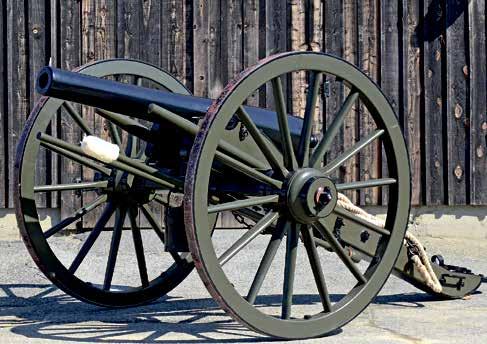
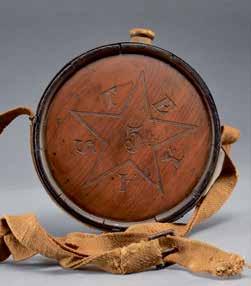
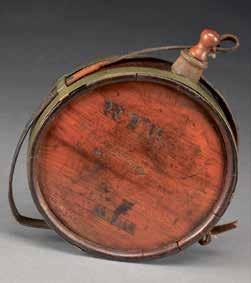
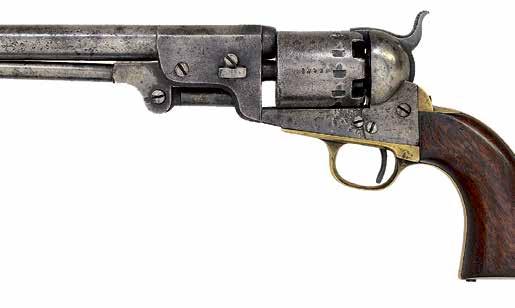
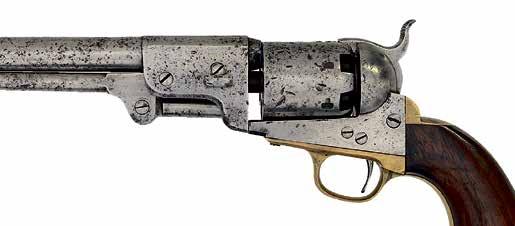
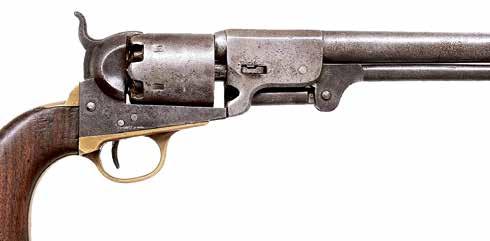

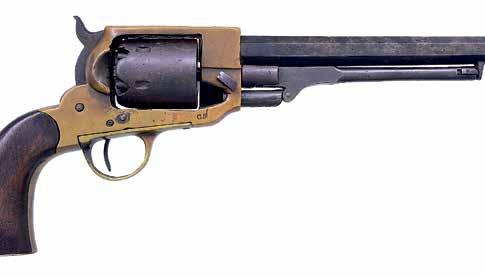
civilwar@poulinauctions.com | poulinauctions.com | 199 Skowhegan Rd, Fairfield, ME 04937 | 207-453-2114 Stephen Poulin, ME Lic # 1115 Premier Firearms And Militaria Auction Nov 5, 6, & 7, 2021 | Fairfield, ME now accepting consignments Firearms & Militaria Auctioneers For more info, visit poulinauctions.com, or call (207) 453-2114 and become a consignor today! 0% Or Better! Seller’s Commission Or Expensive Items and Valuable Collections Sold $24,075 Extremely Rare & Fine Identified Texas Confederate Wood Canteen. EST. $8,000 - $12,000 Sold $12,925 Confederate Wood Canteen Carved “Mississippi” Carried By William T. Works, 4th Alabama Infantry. EST. $3,000 - $4,000 Highest Known Serial Number For Confederate Leech & Rigdon Revolver. S# 1461. EST. $20,000 - $30,000 Sold $24,675 Sold $25,850 Highest Serial Known For Confederate Rigdon & Ansley Revolver. S# 2352. EST. $20,000 - $30,000 Sold $44,650 Very Fine Civil War 3 Inch Model 1861 Ordnance Rifle. To view the full May 2021 Auction Prices Realized, please visit poulinauctions.com

























































 by James Crane III
by James Crane III













































 by Bob Ruegsegger
by Bob Ruegsegger







































































 by J. Dale West, P.E.
by J. Dale West, P.E.


 By Lawrence E. Babits
By Lawrence E. Babits












































































 by Jonathan A. Noyalas, Director
by Jonathan A. Noyalas, Director










 By David A. Powell. Appendix, Notes, Bibliography, and Index,
By David A. Powell. Appendix, Notes, Bibliography, and Index,
 Reviewed
Reviewed




 Reviewed by Craig Barry
Reviewed by Craig Barry

















































































